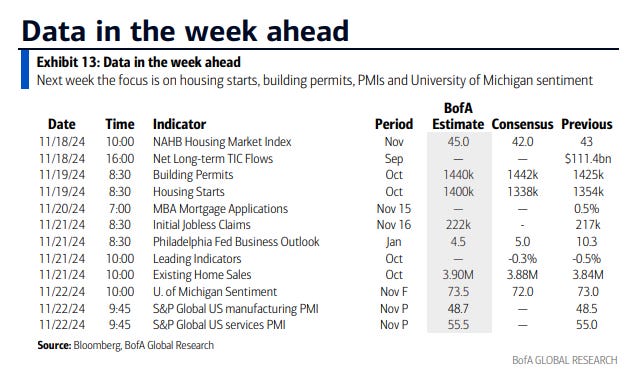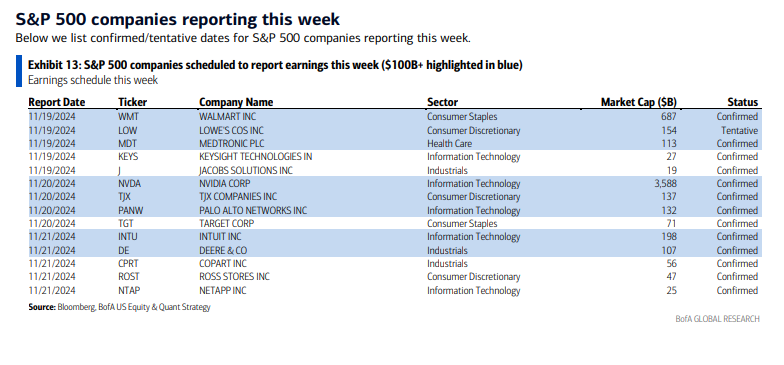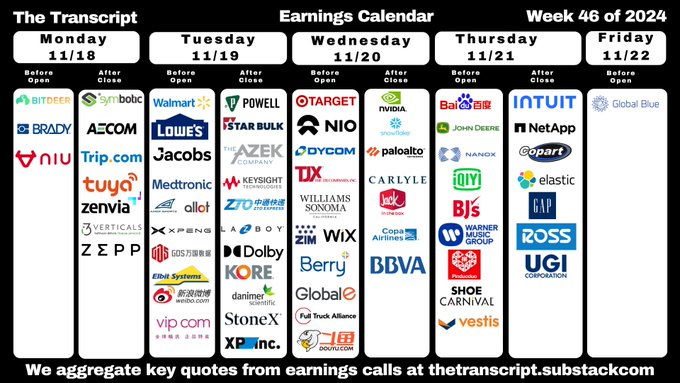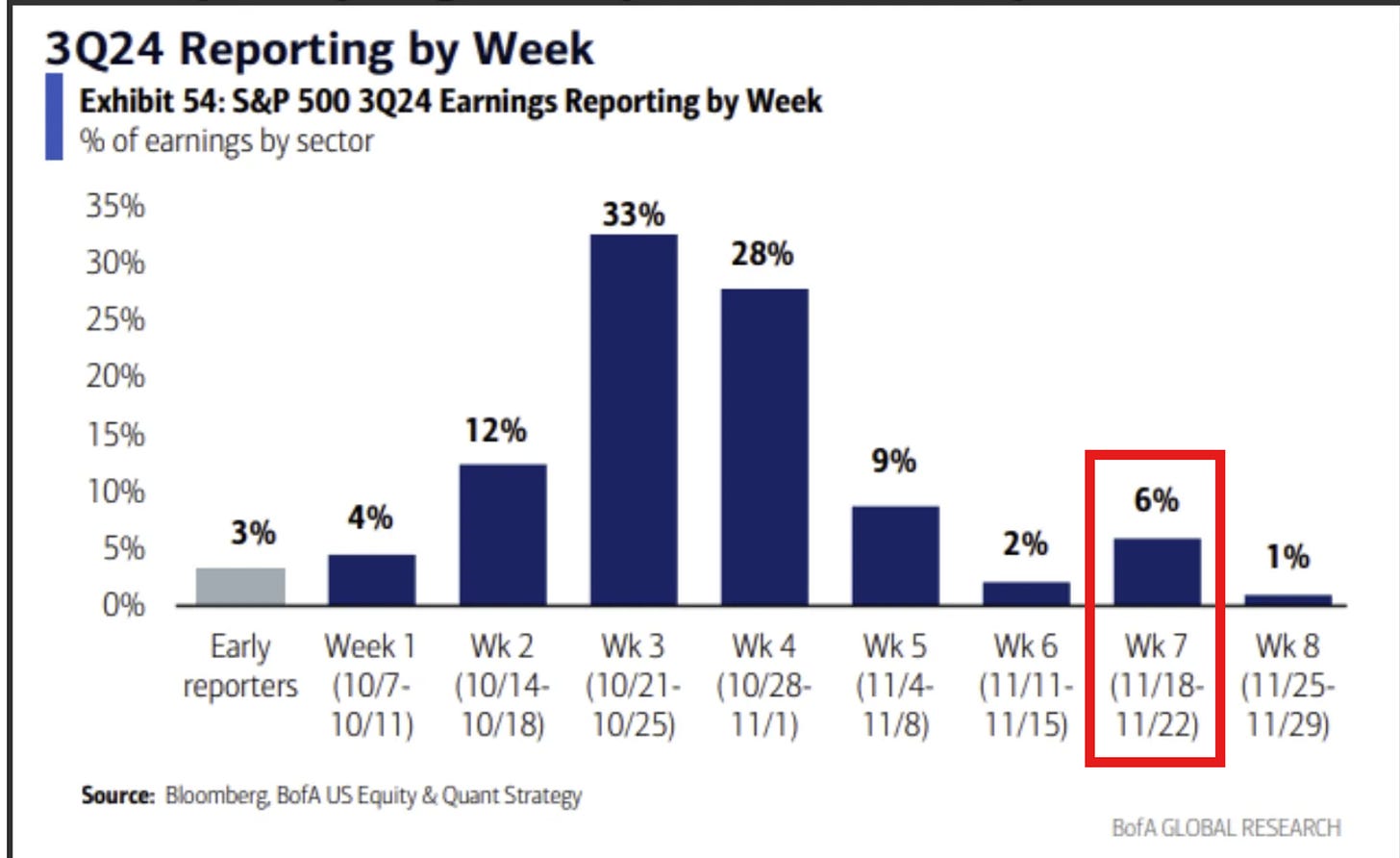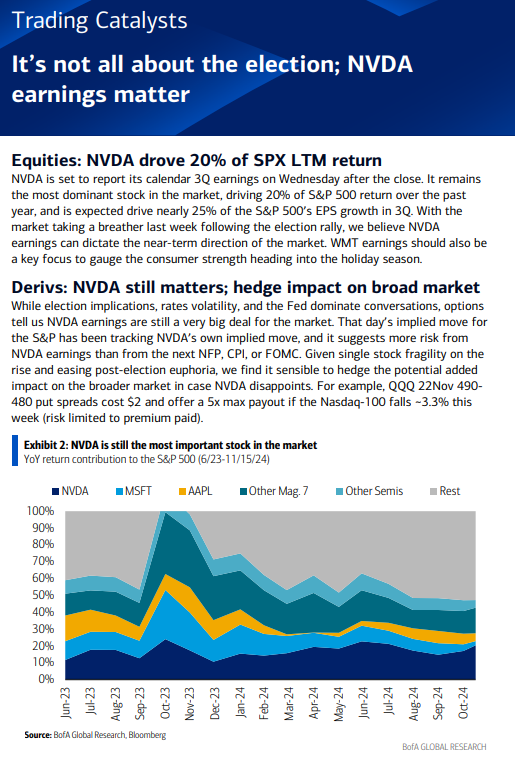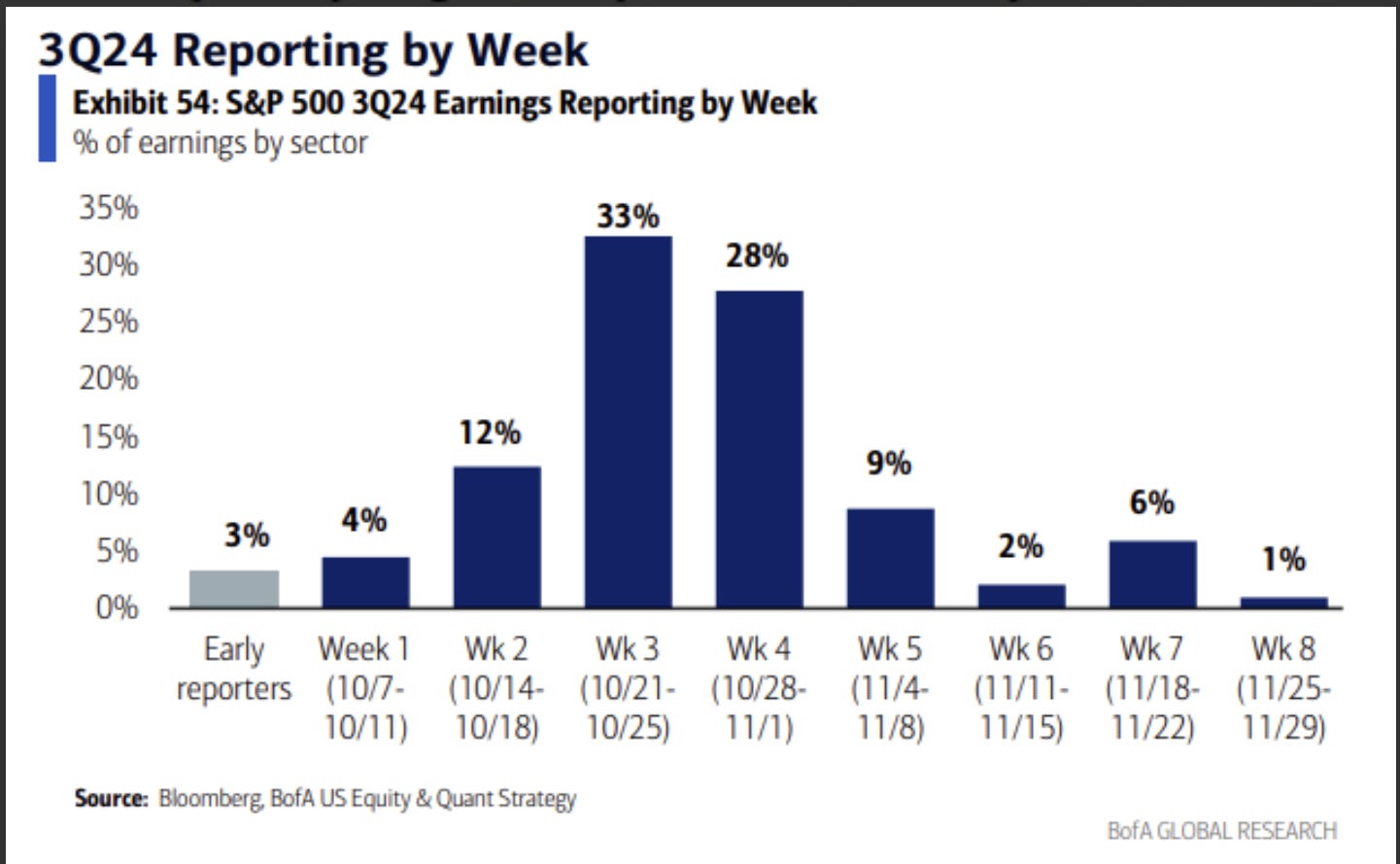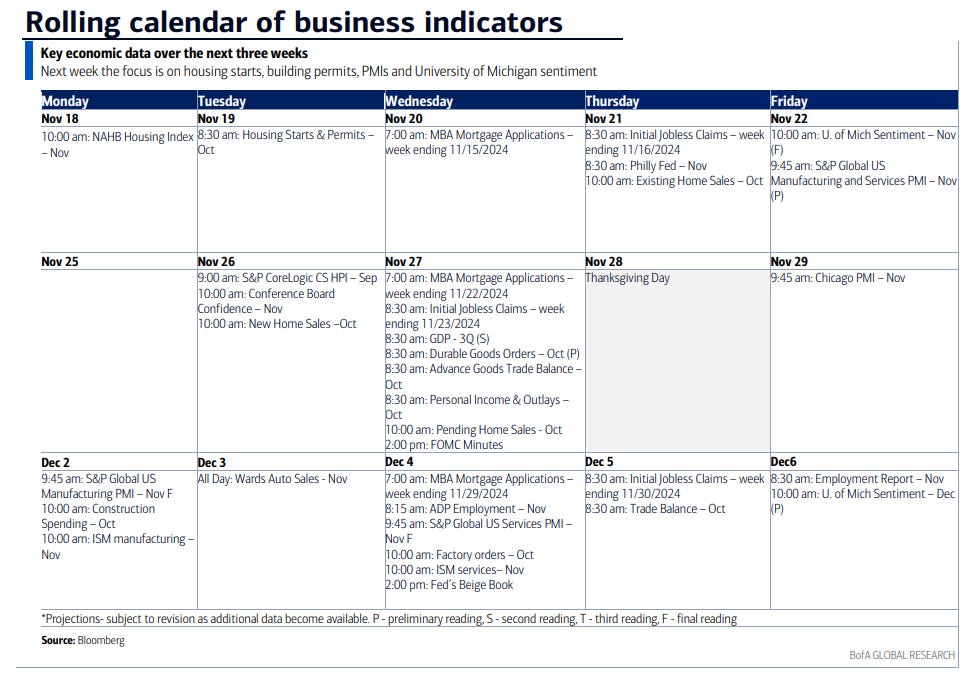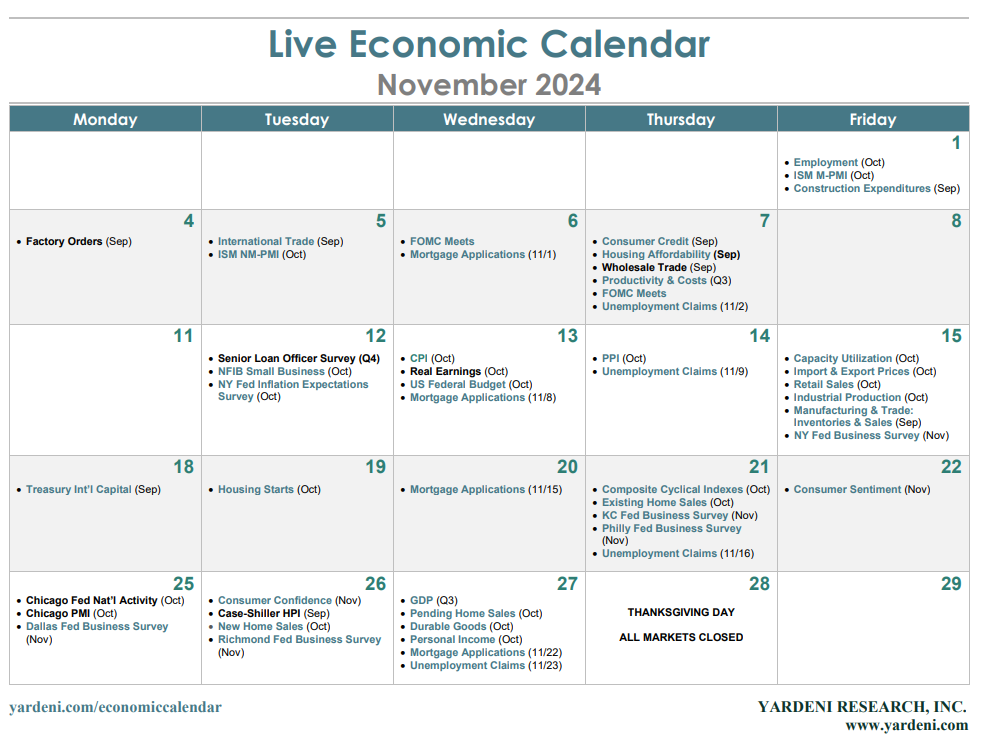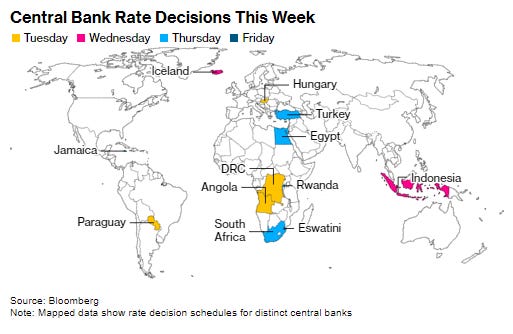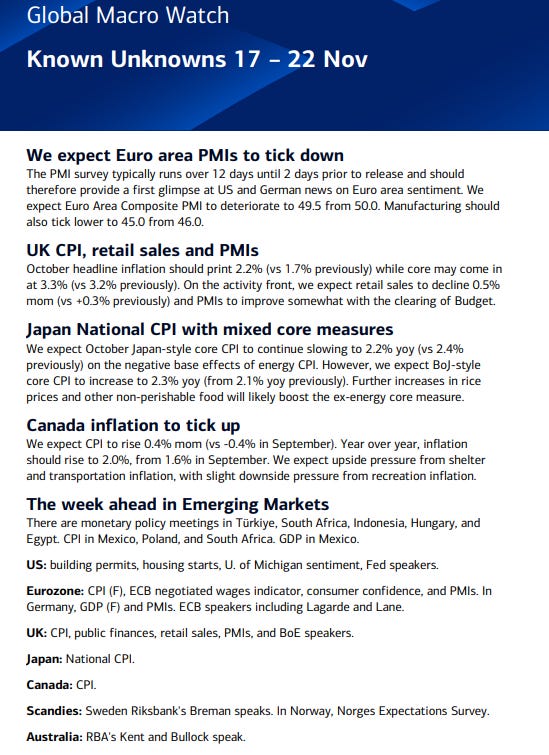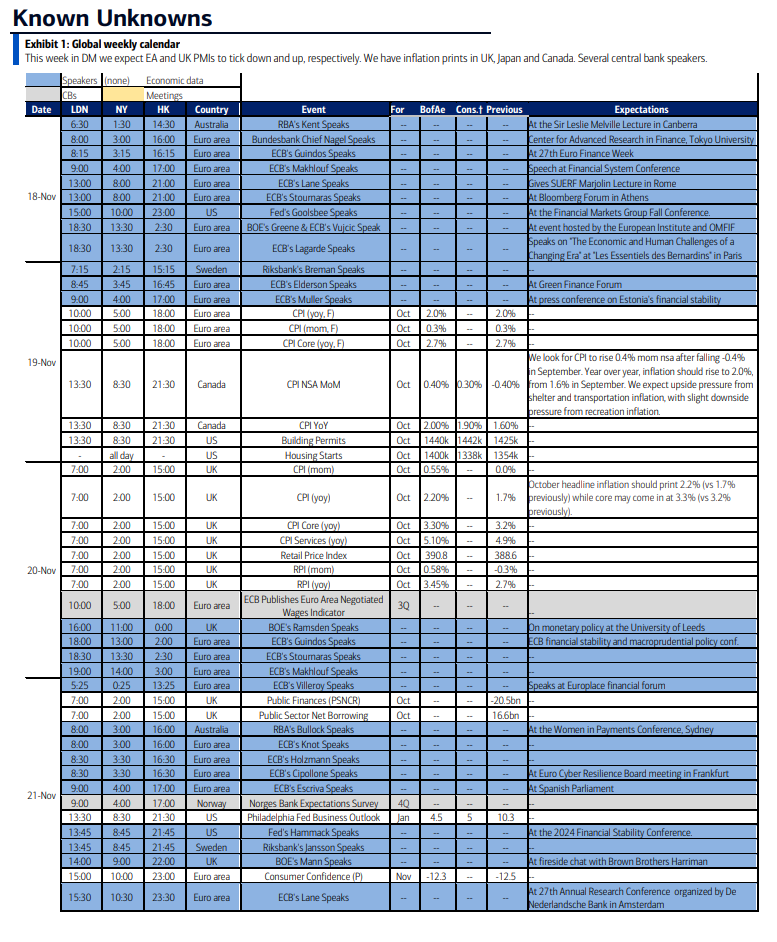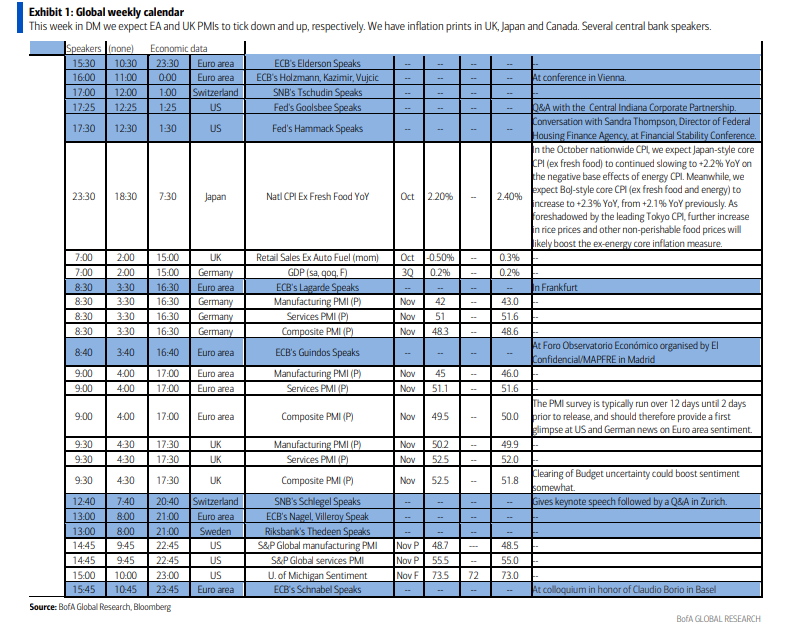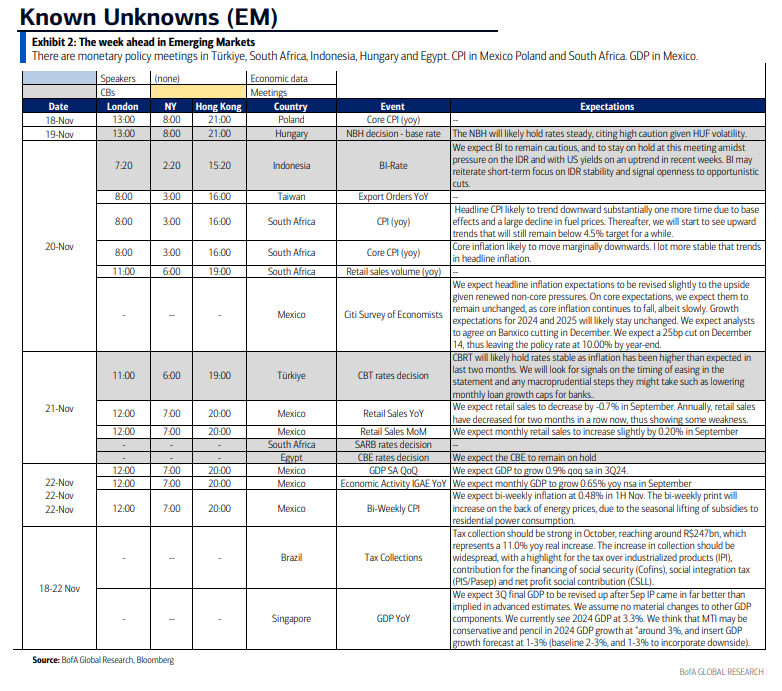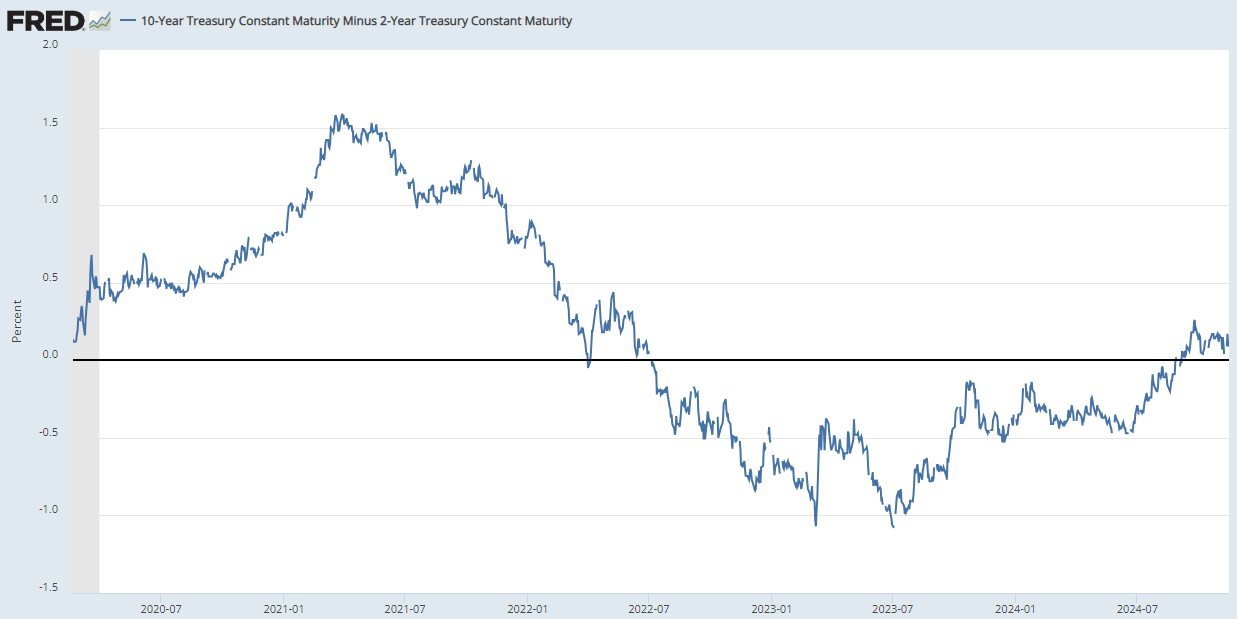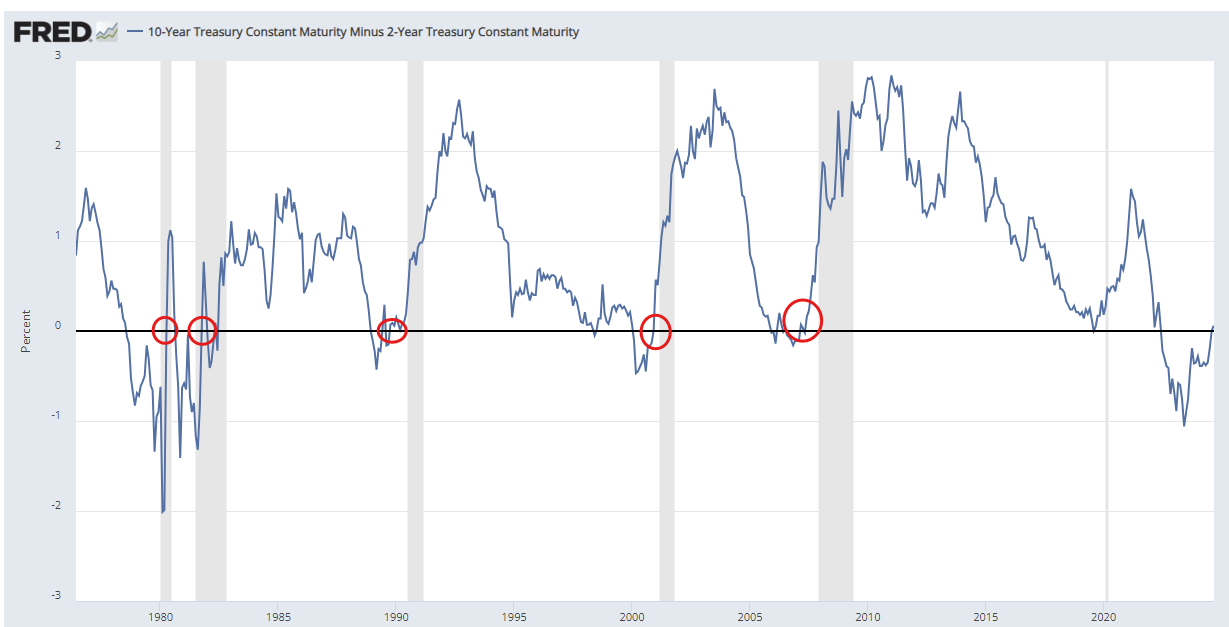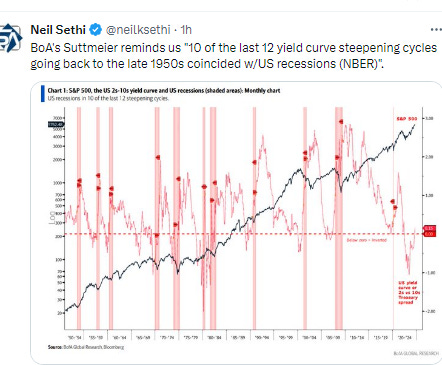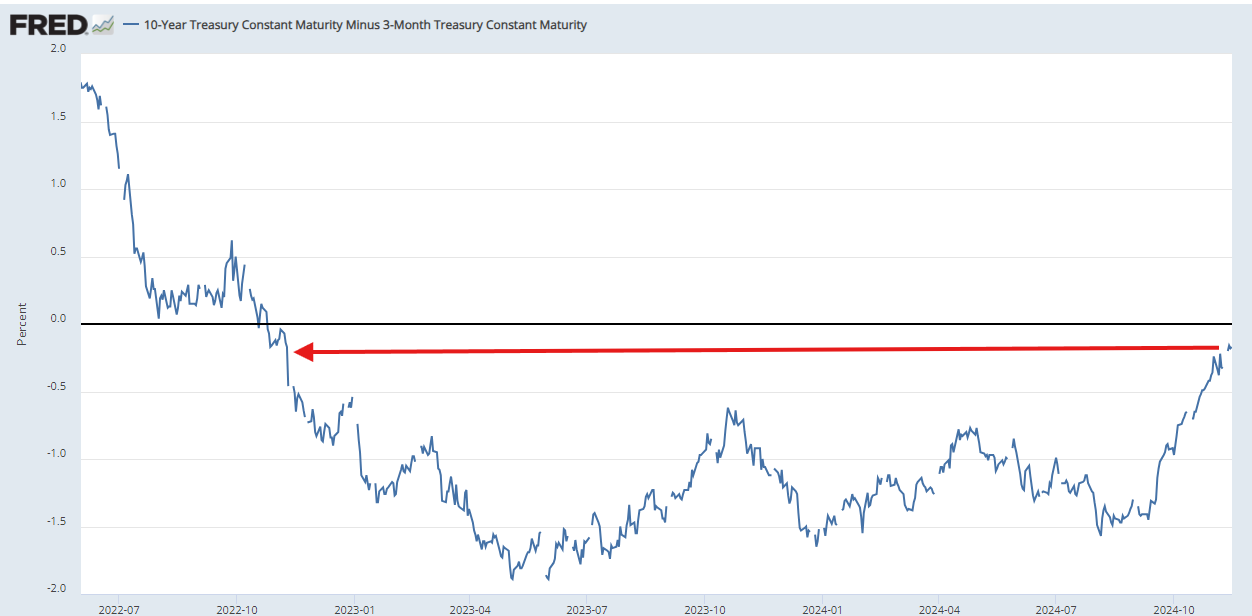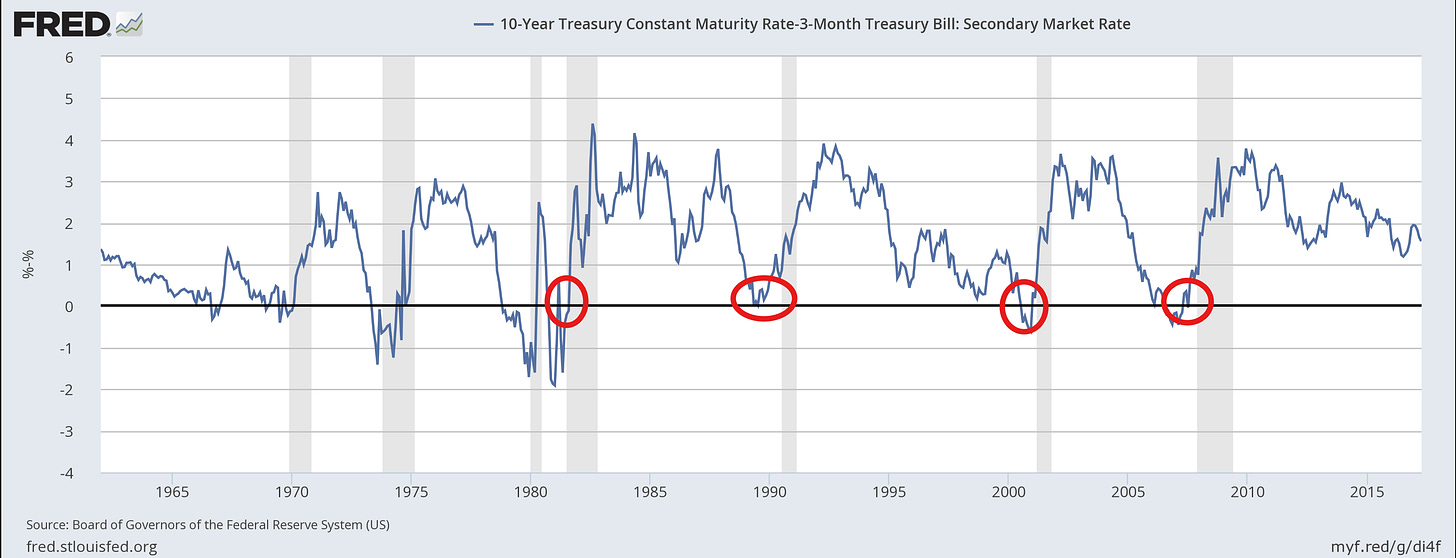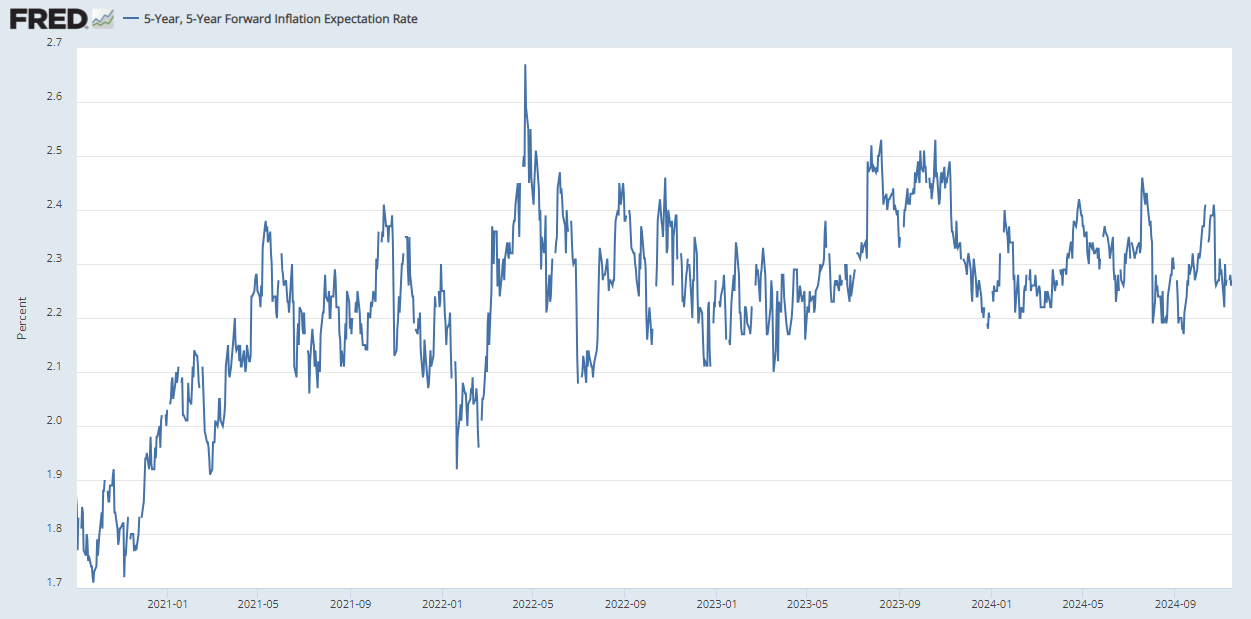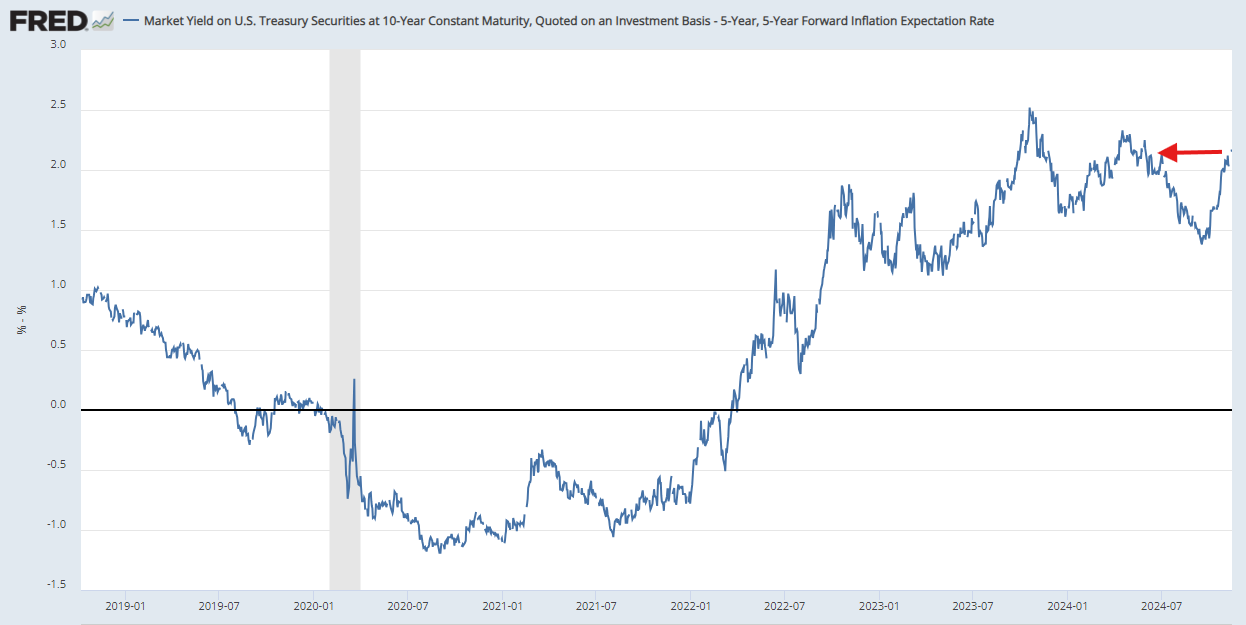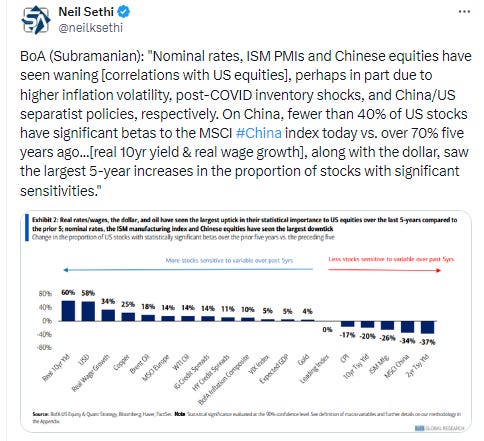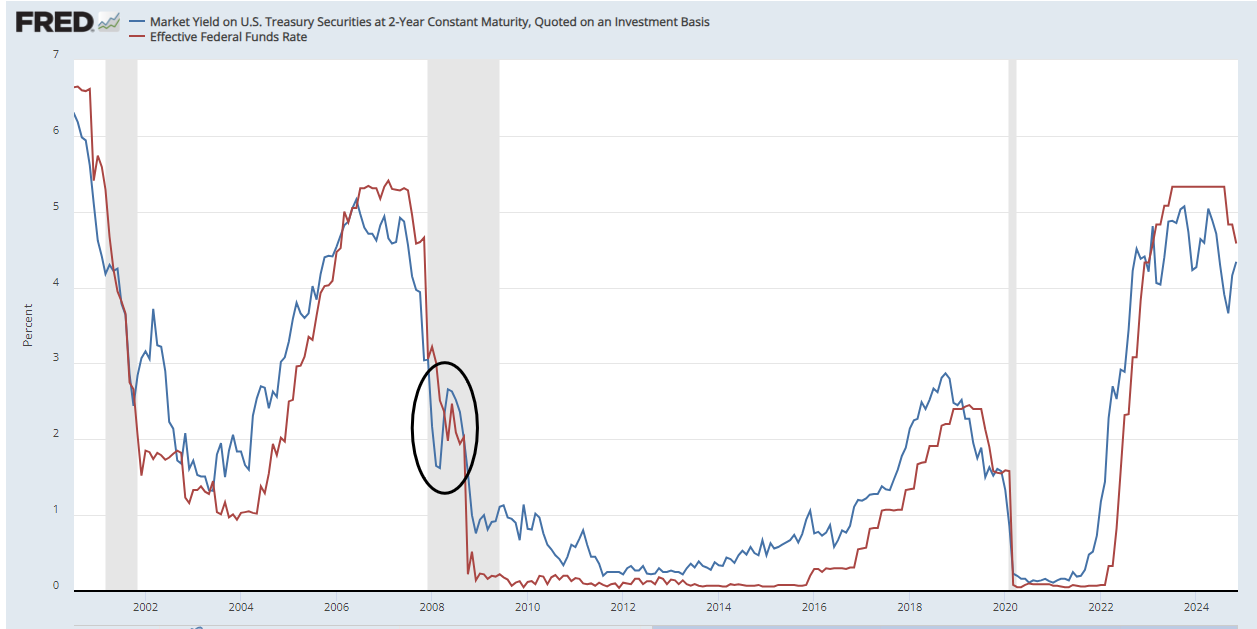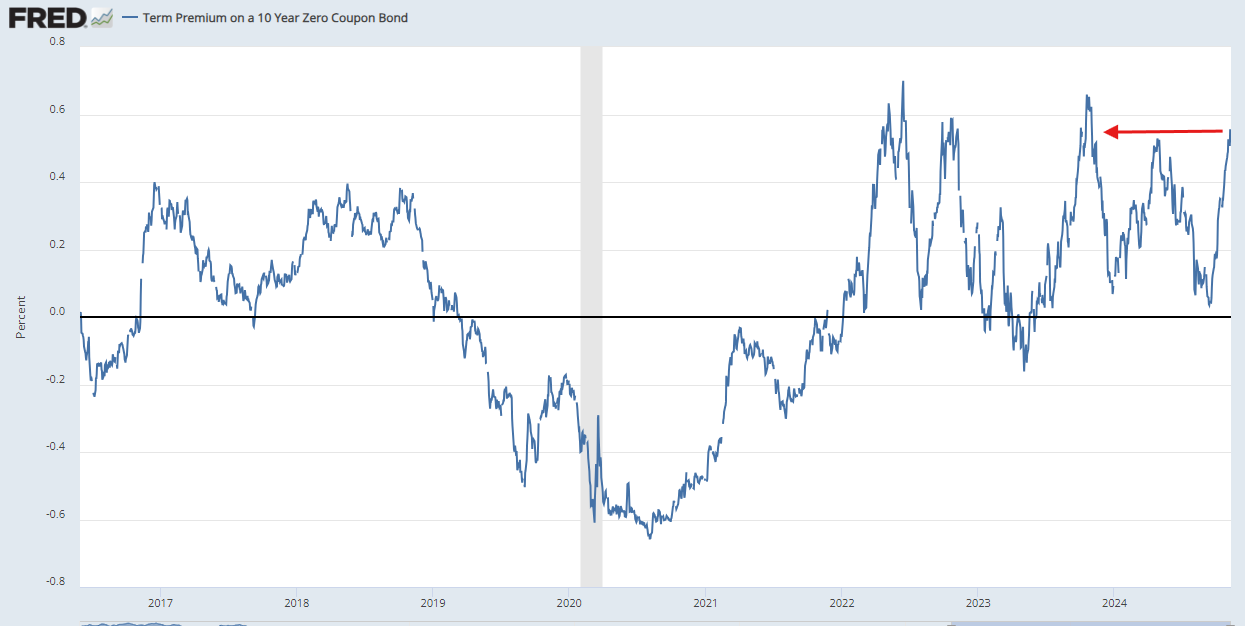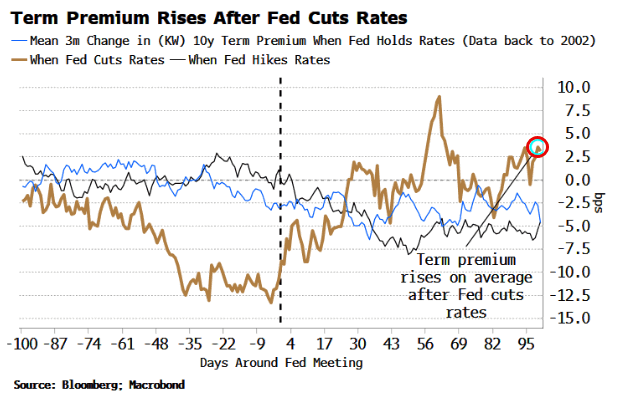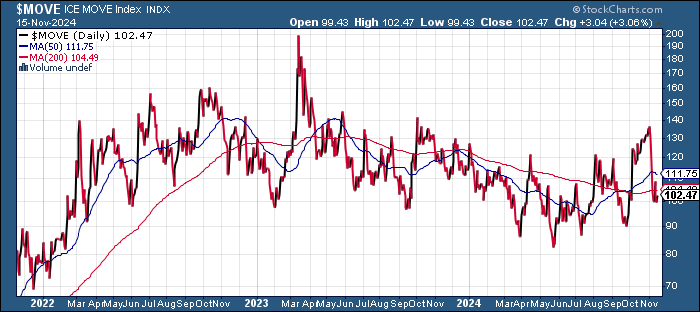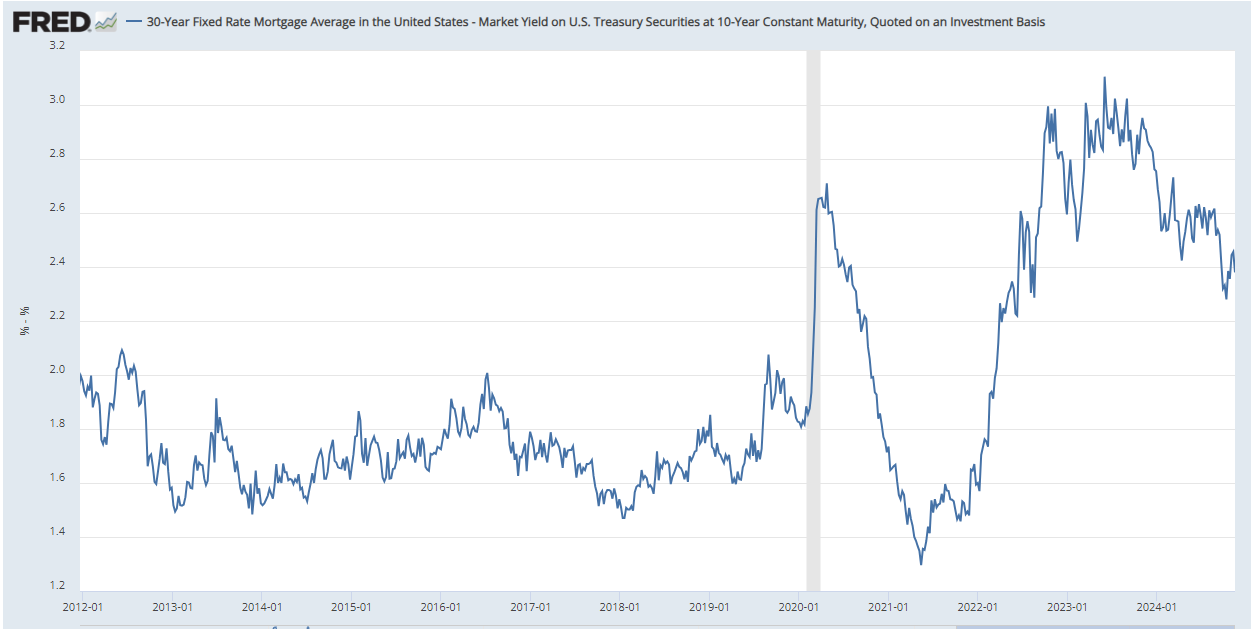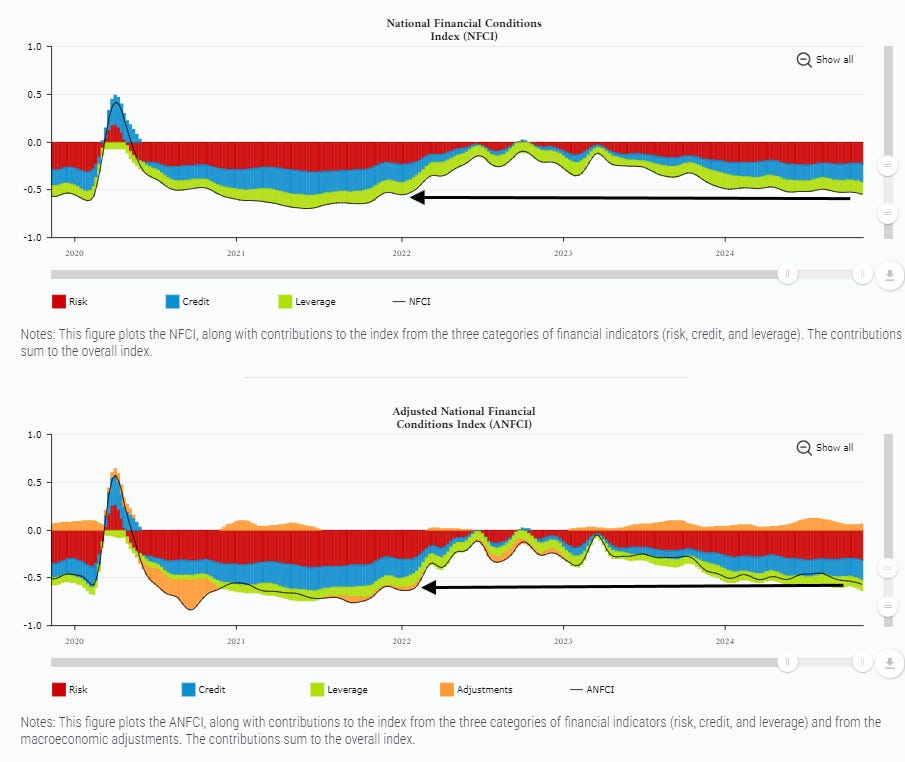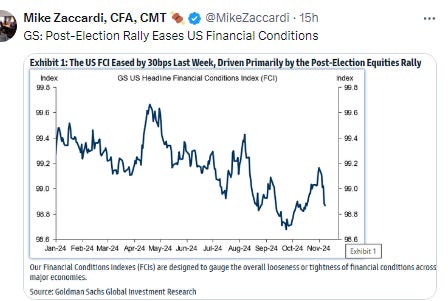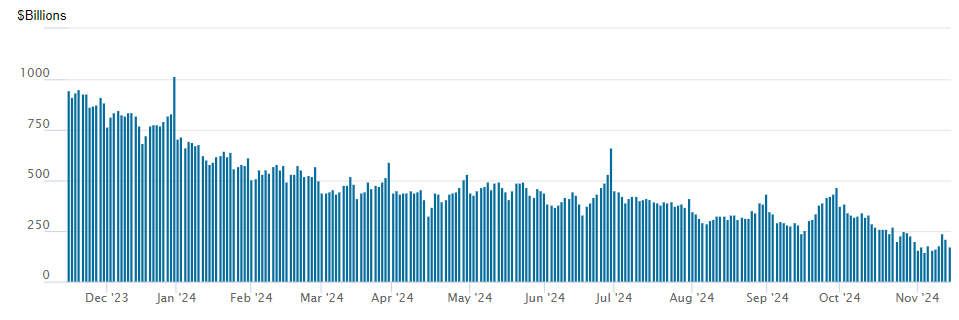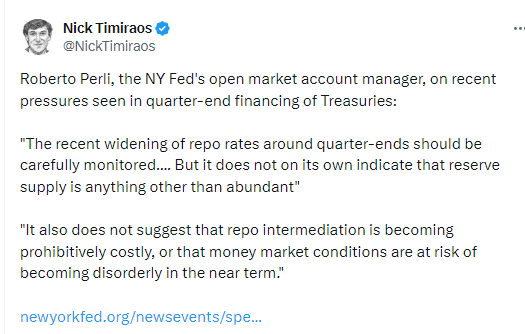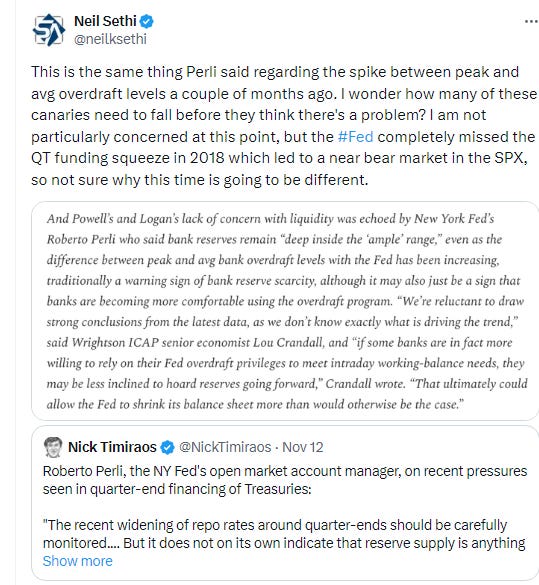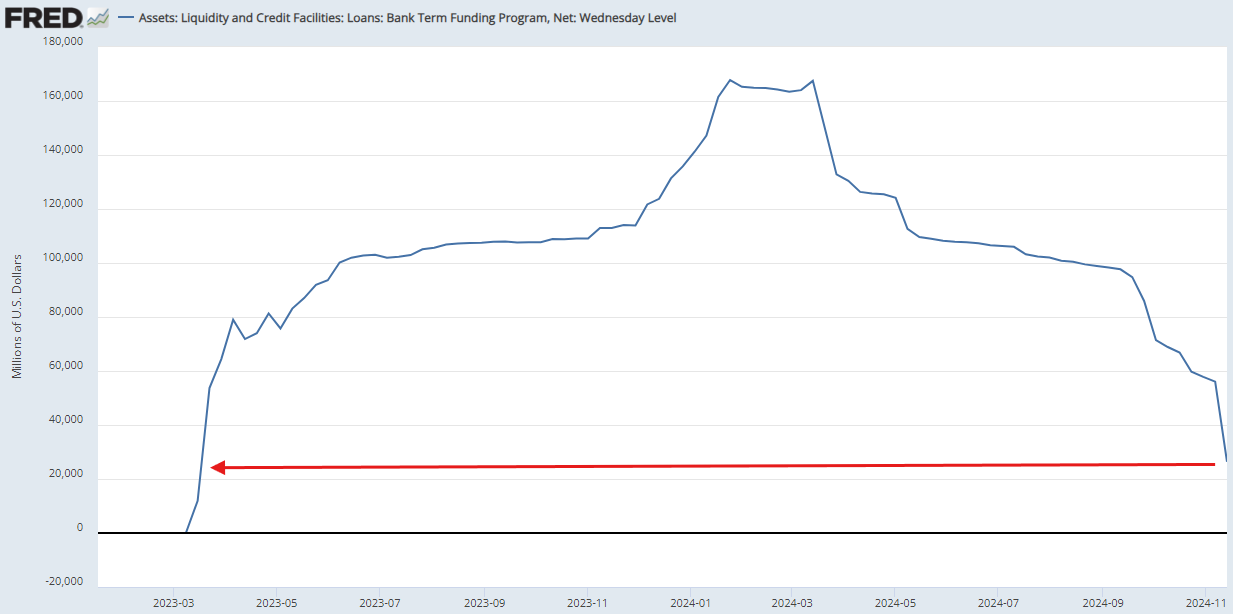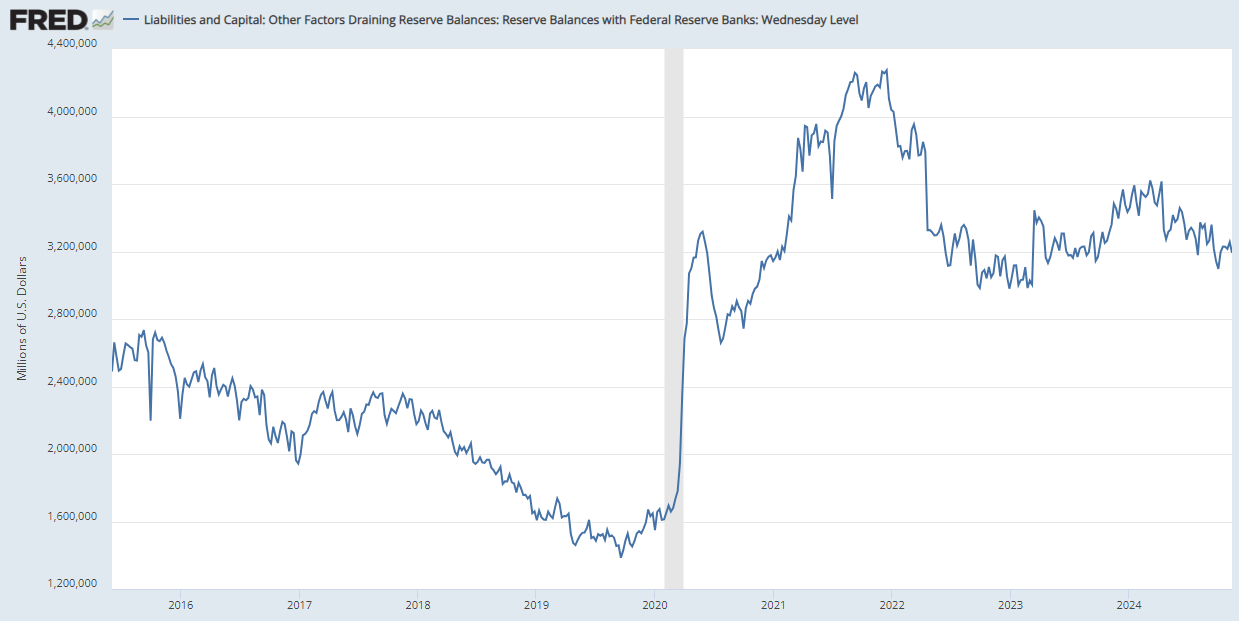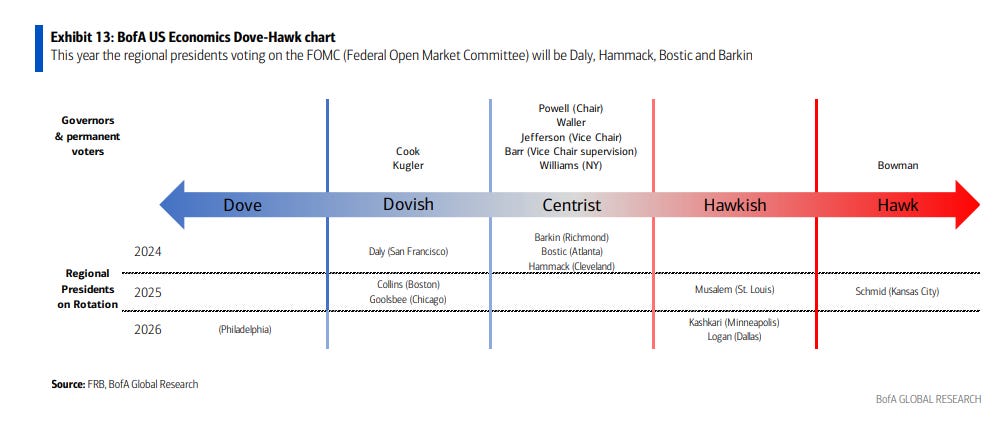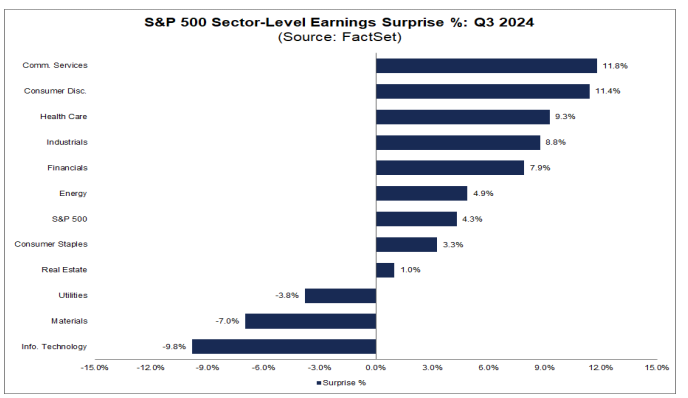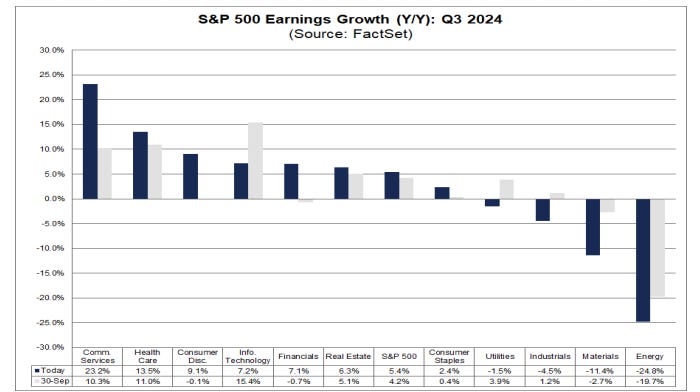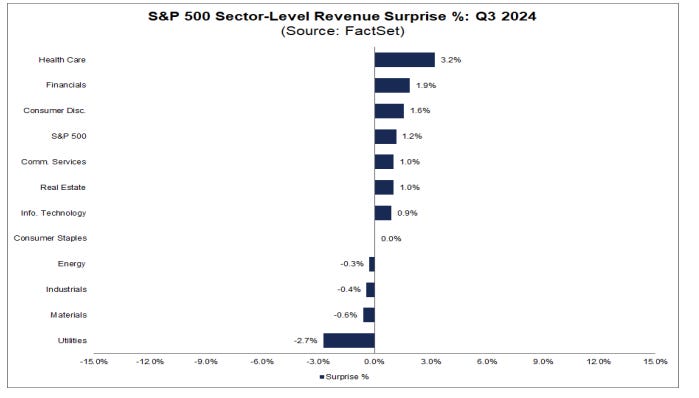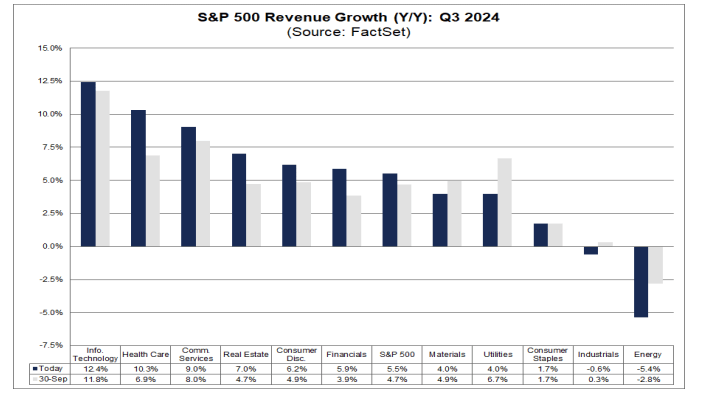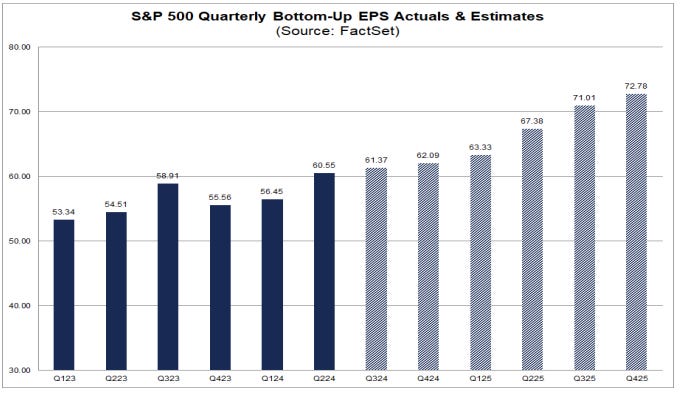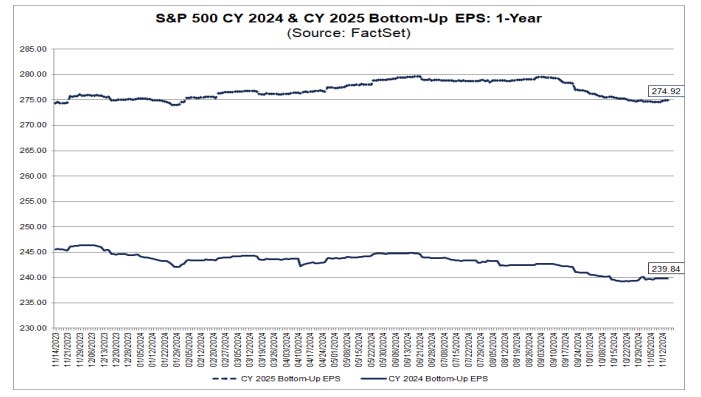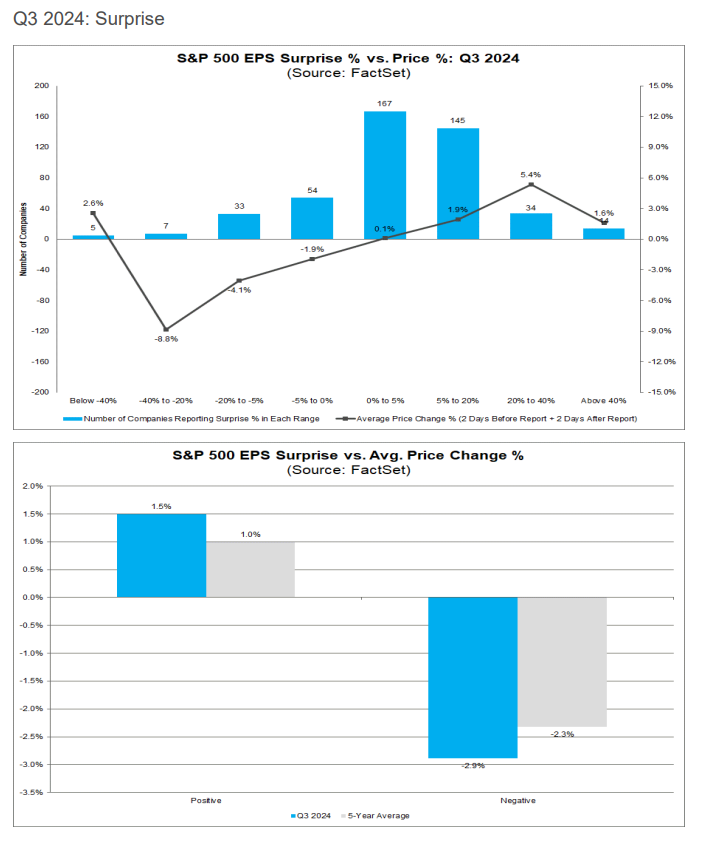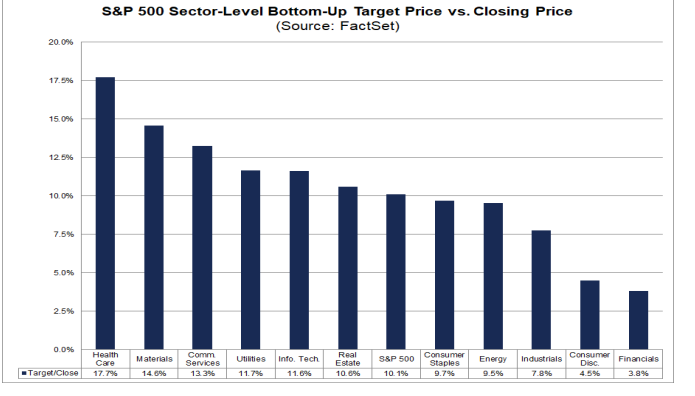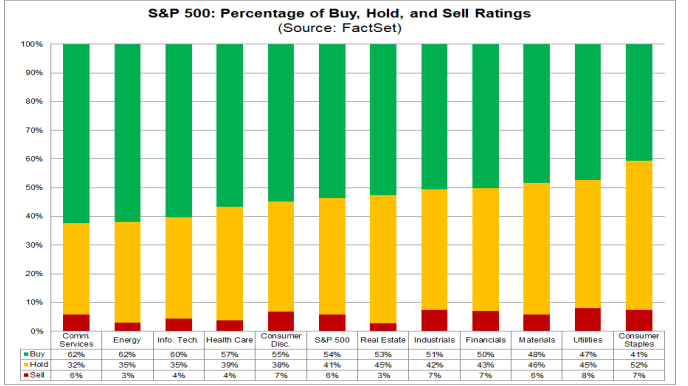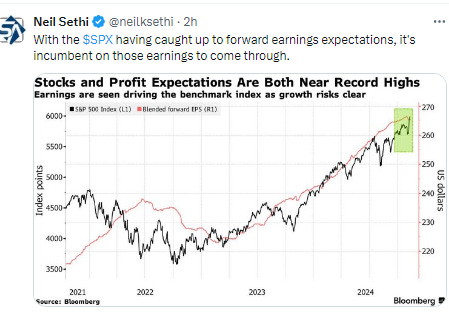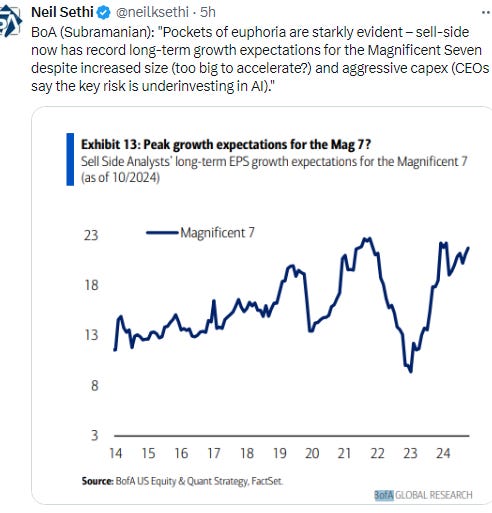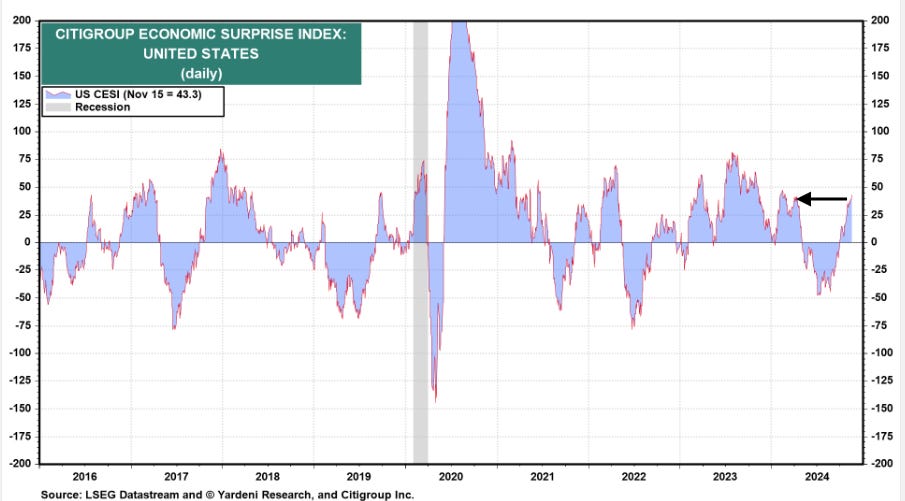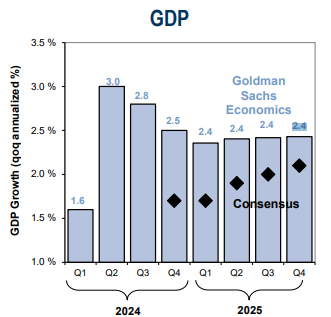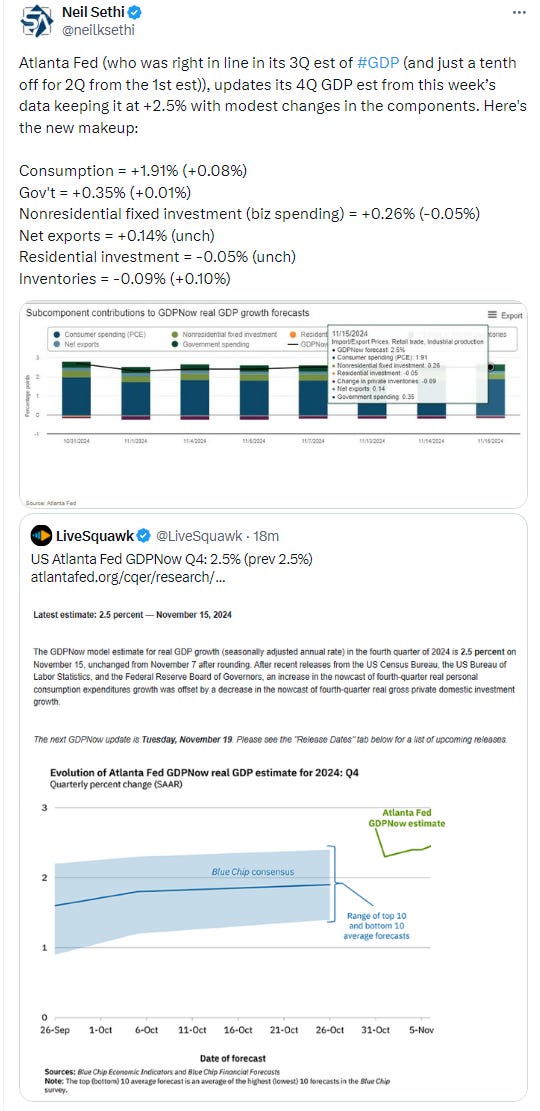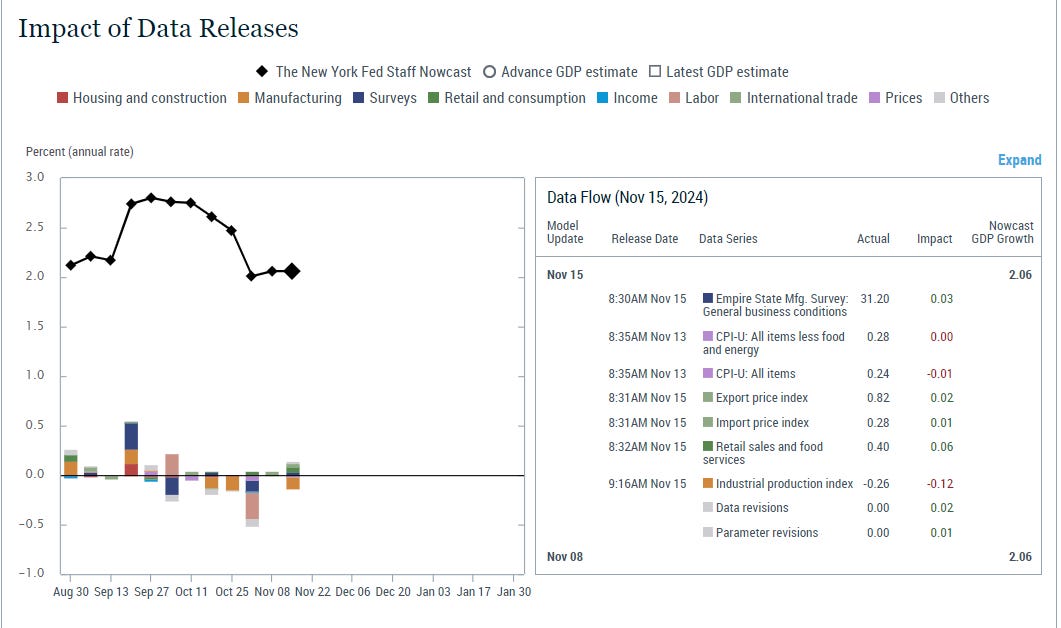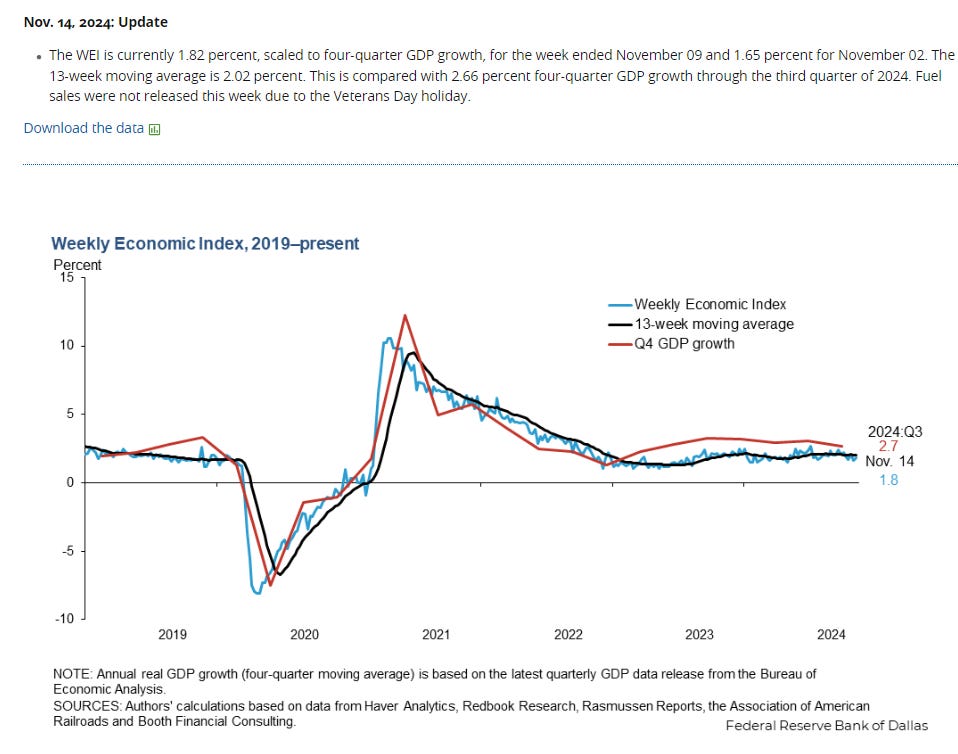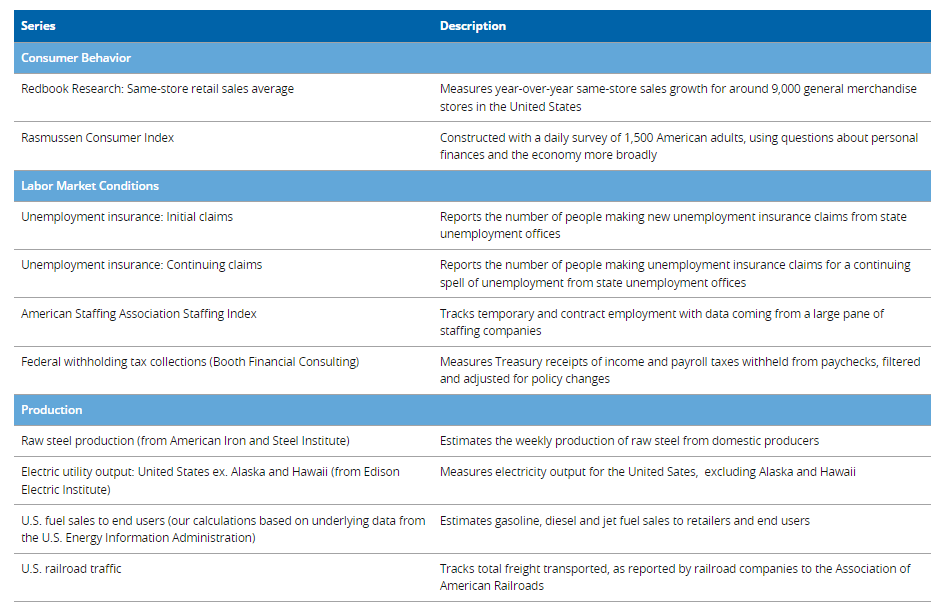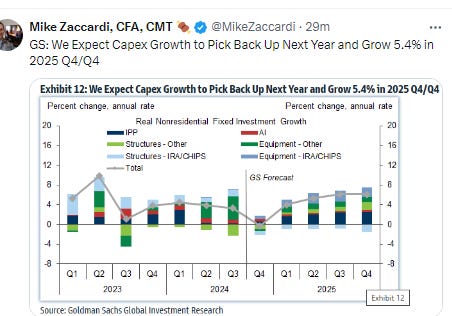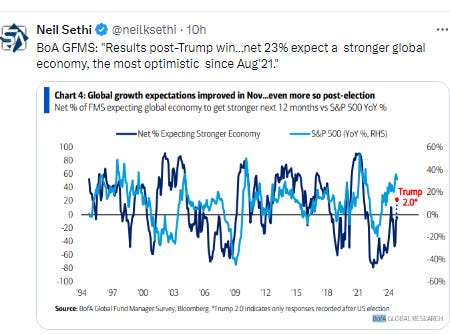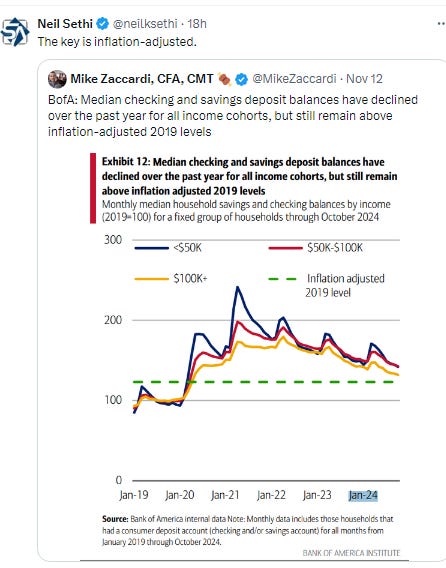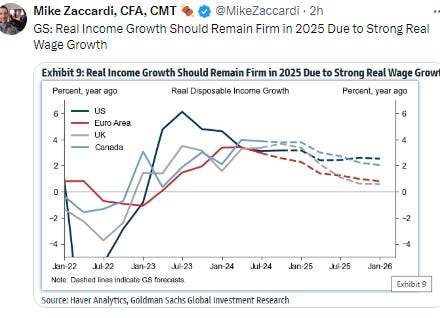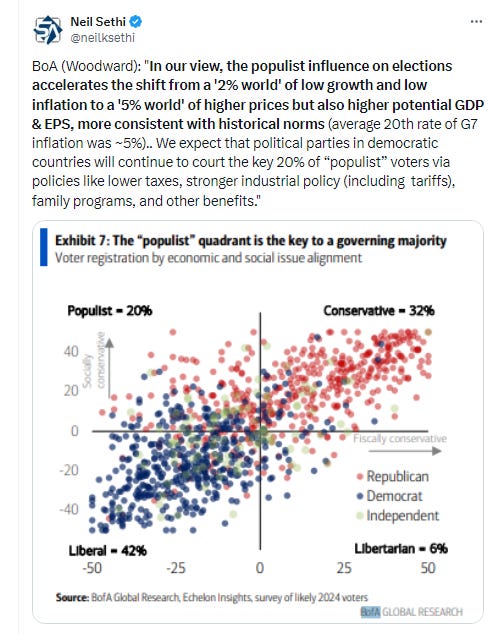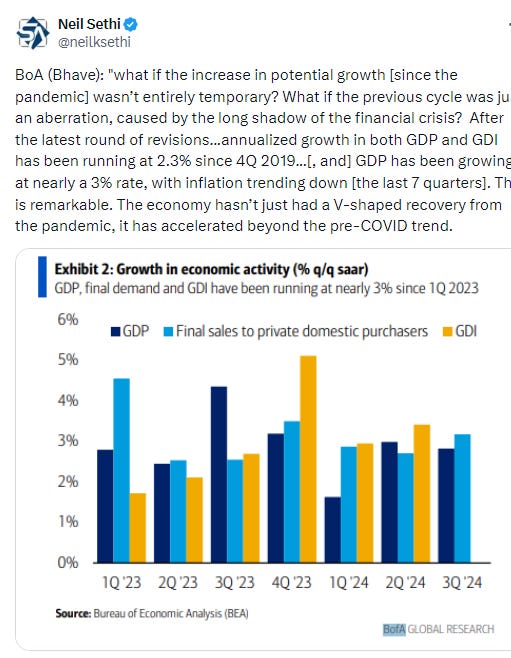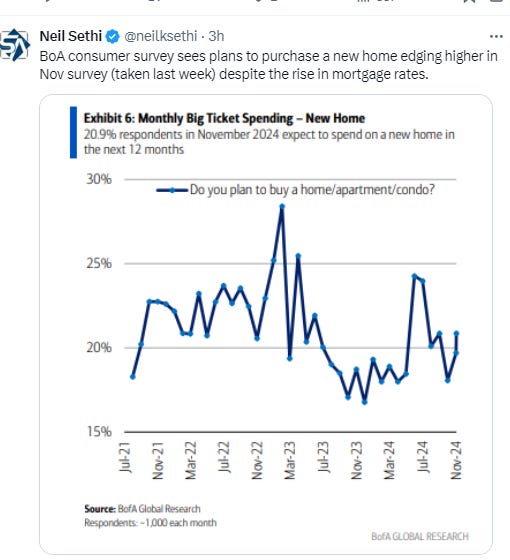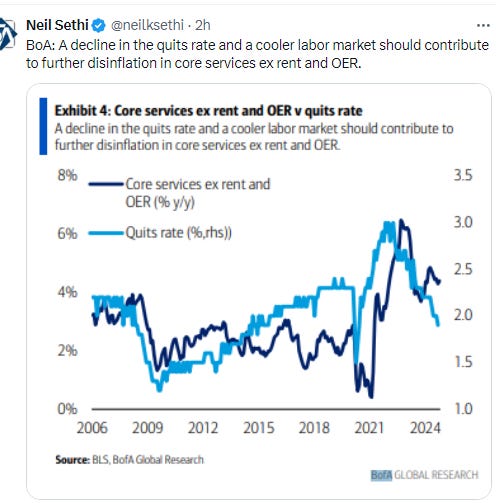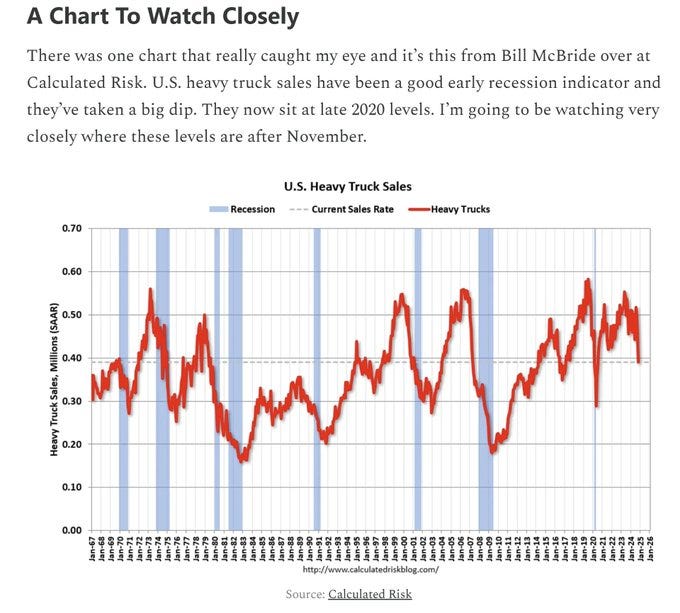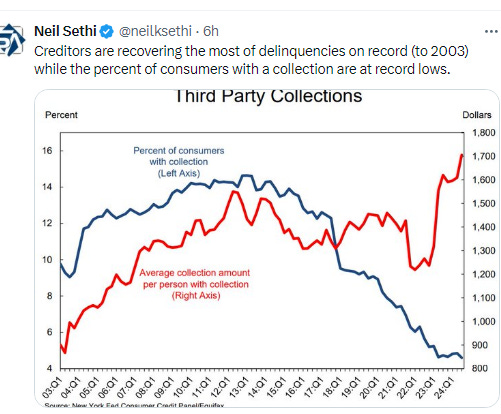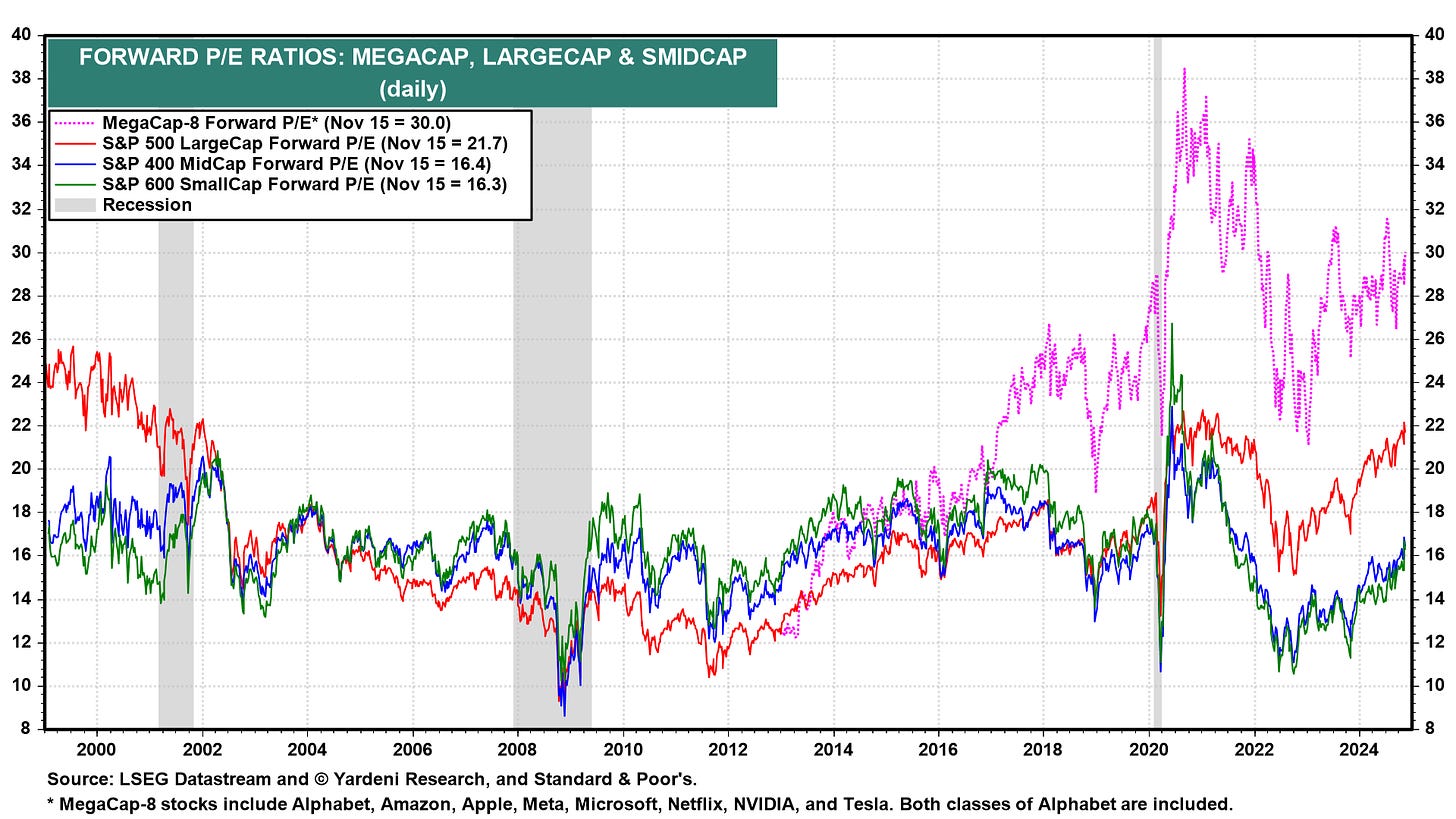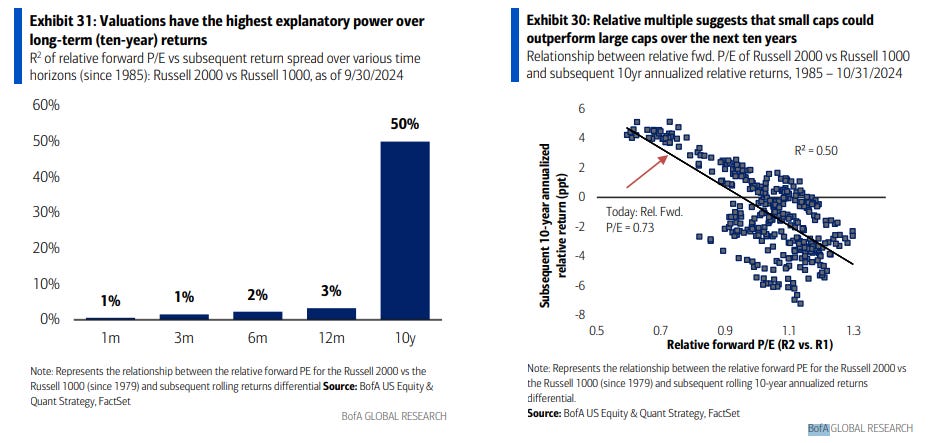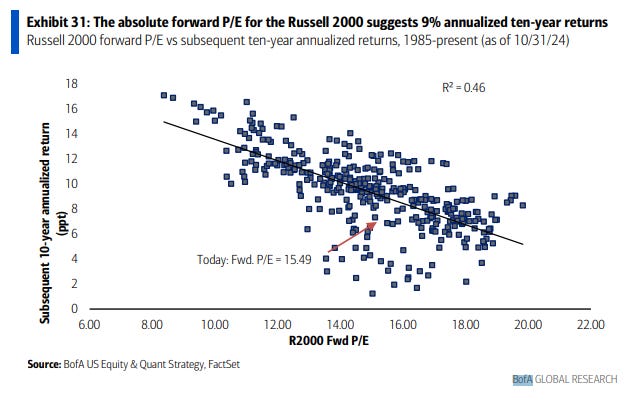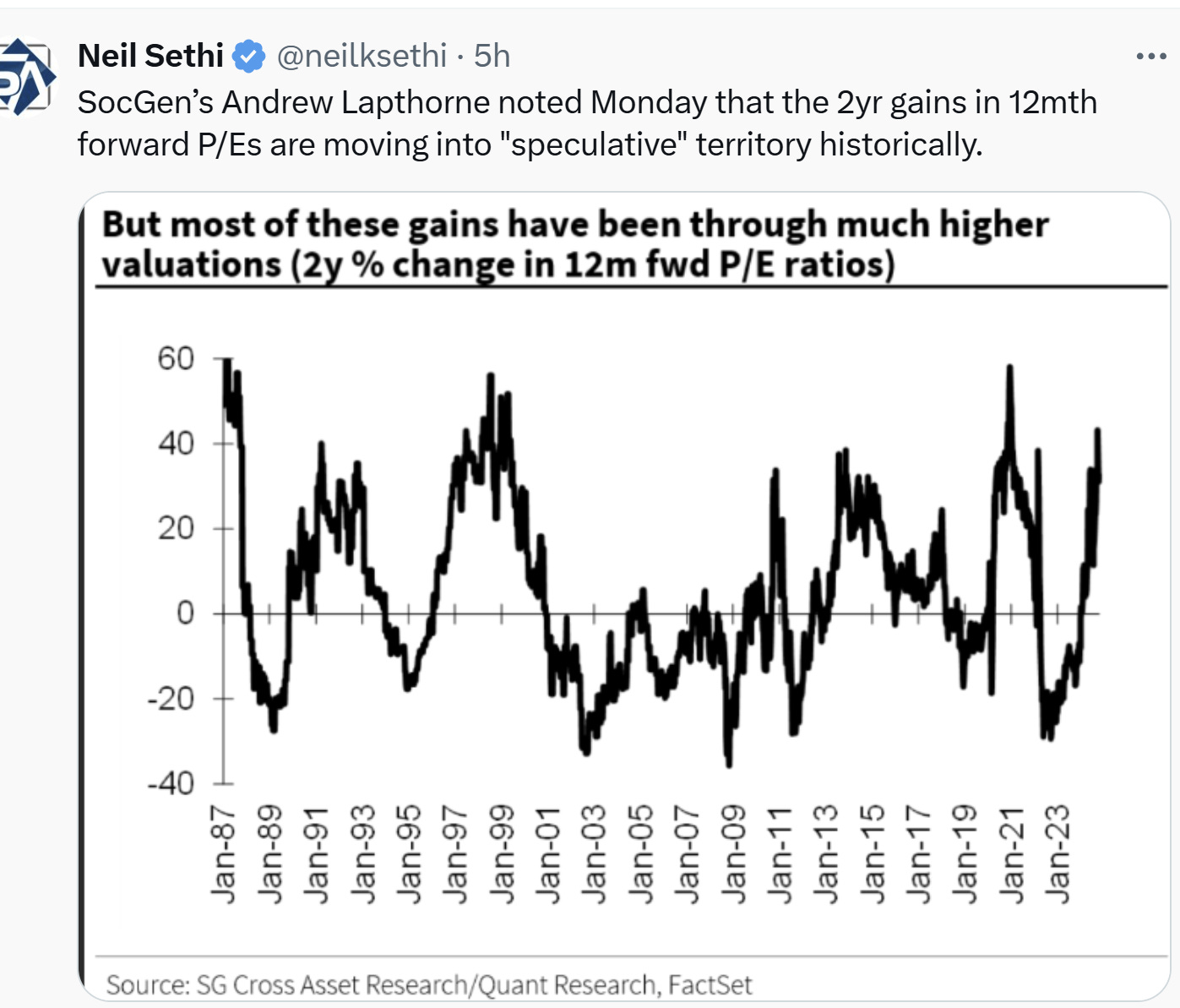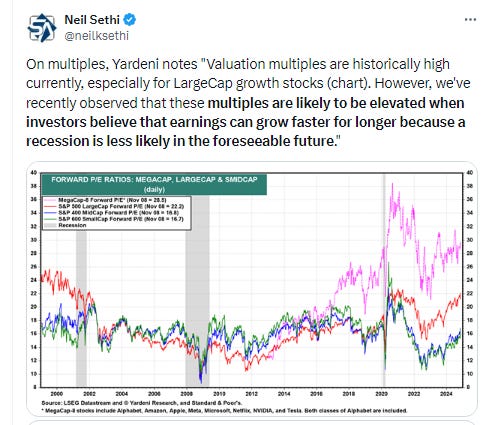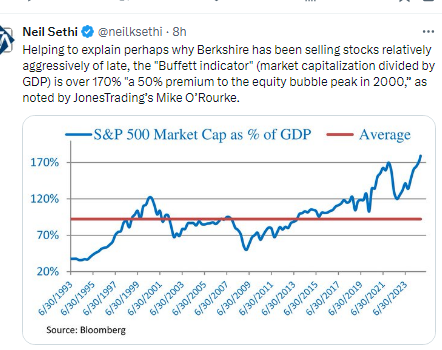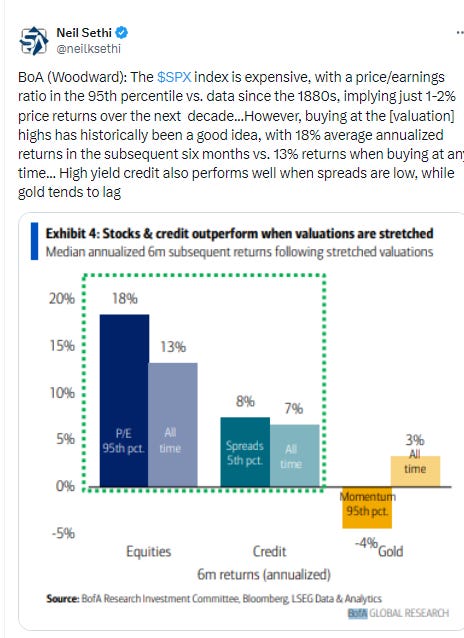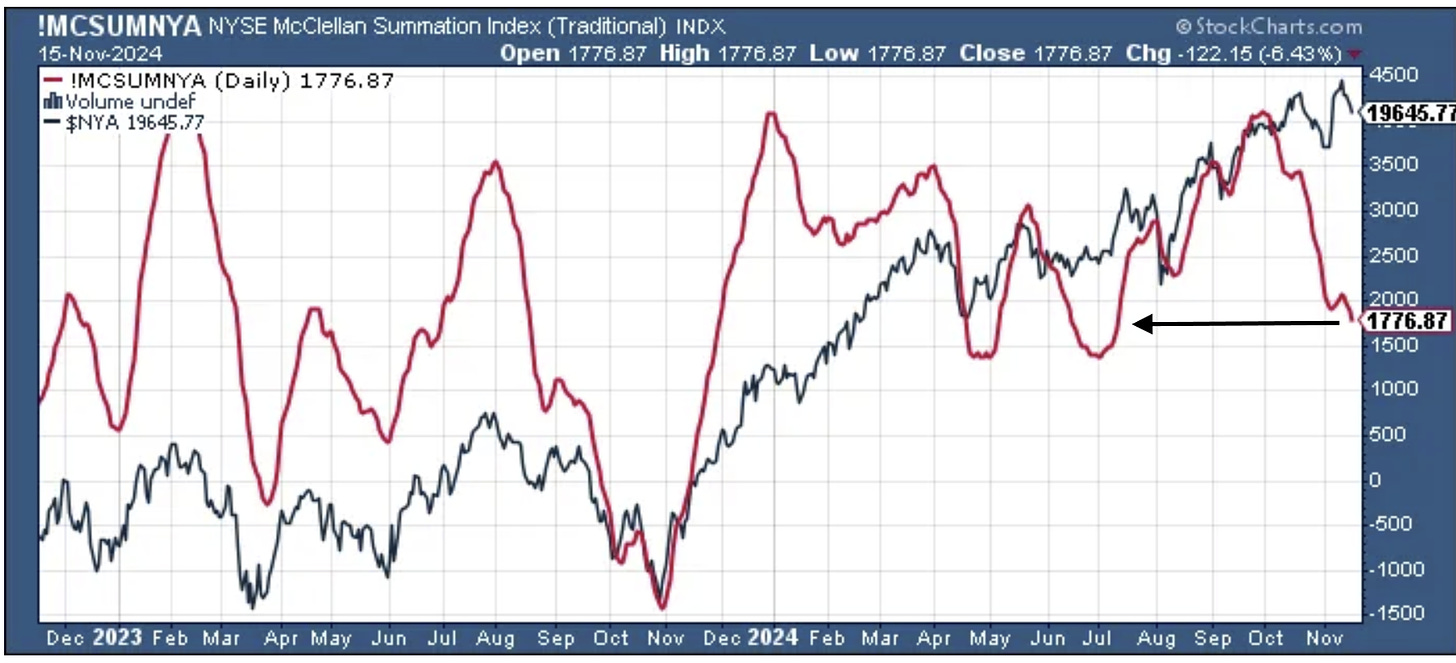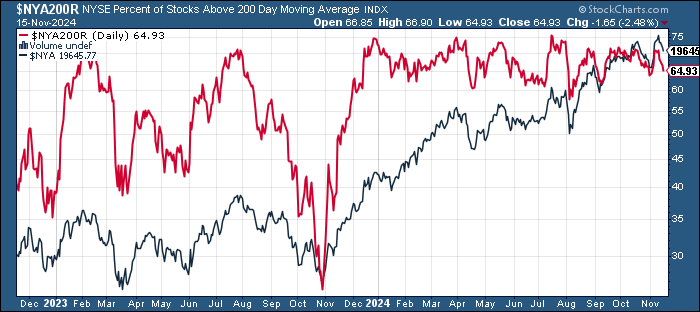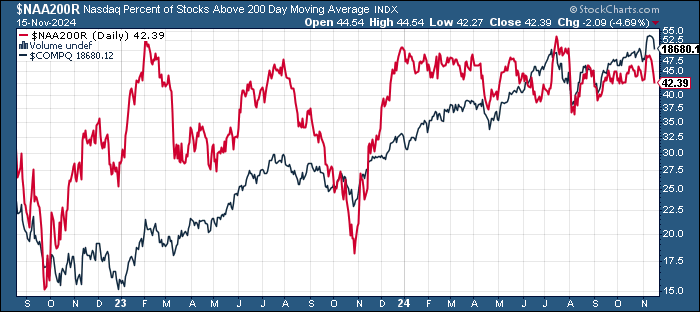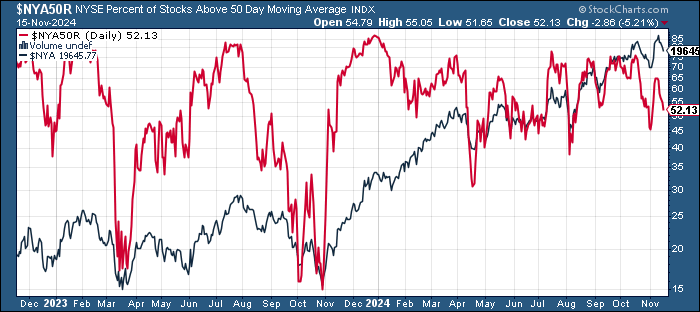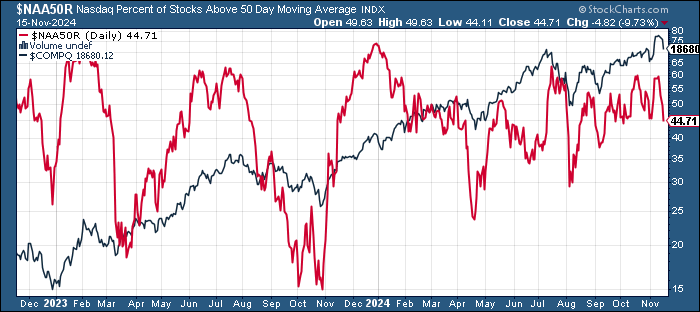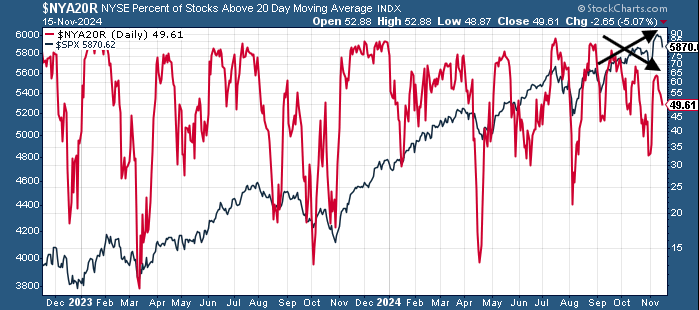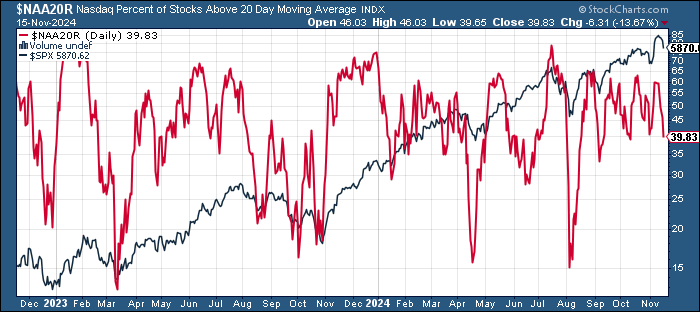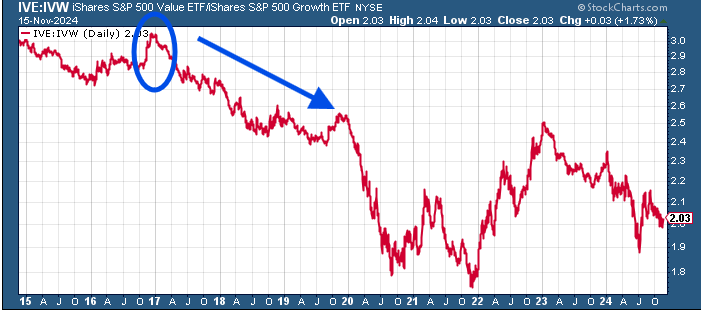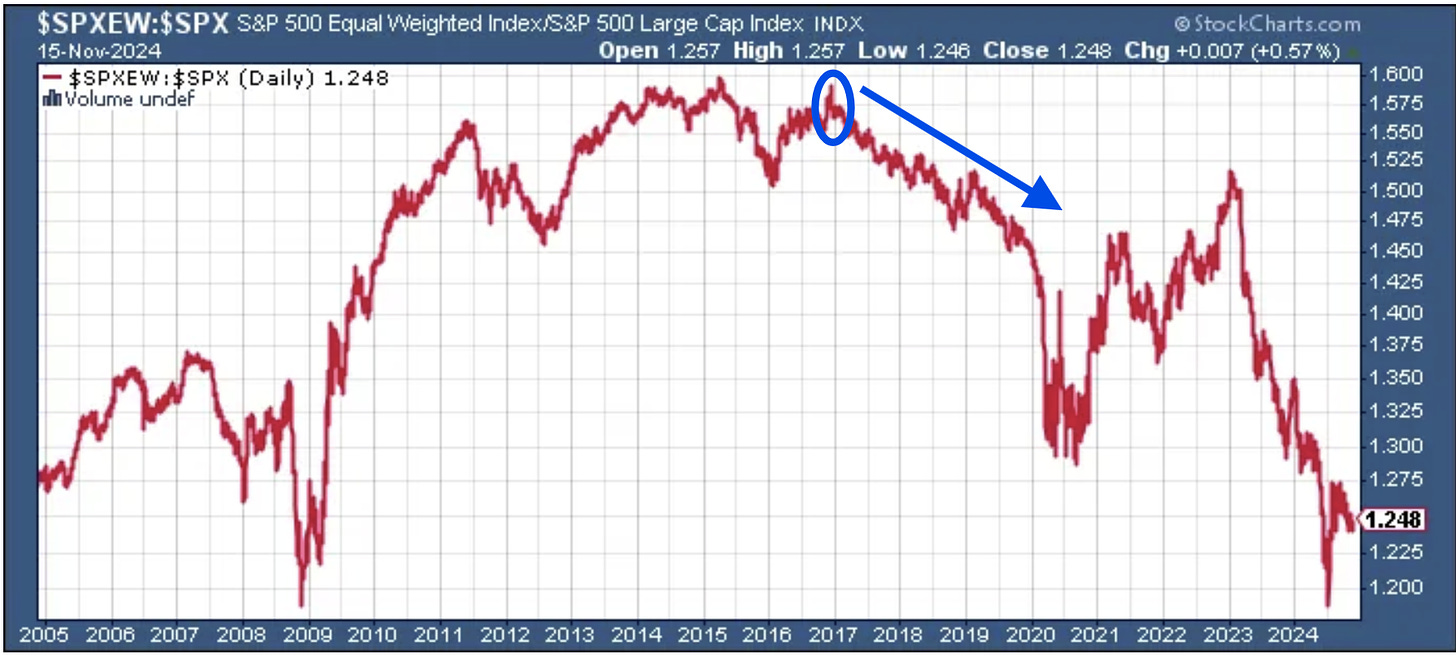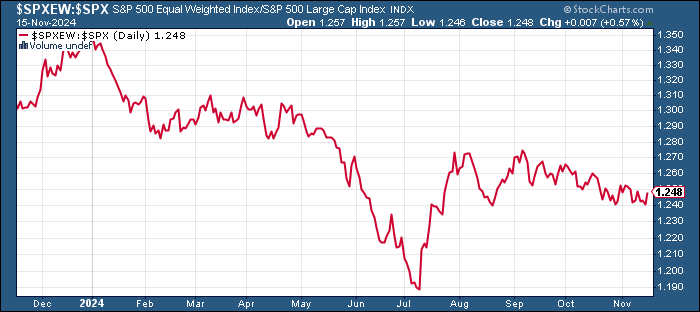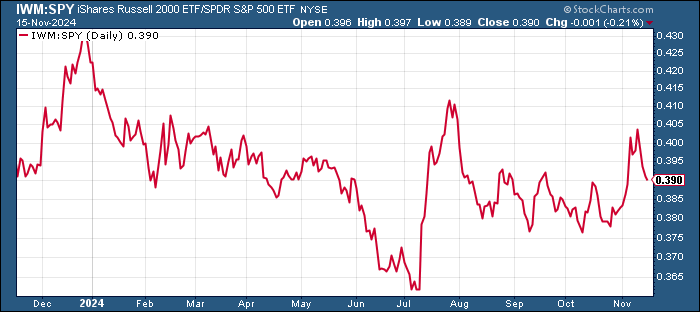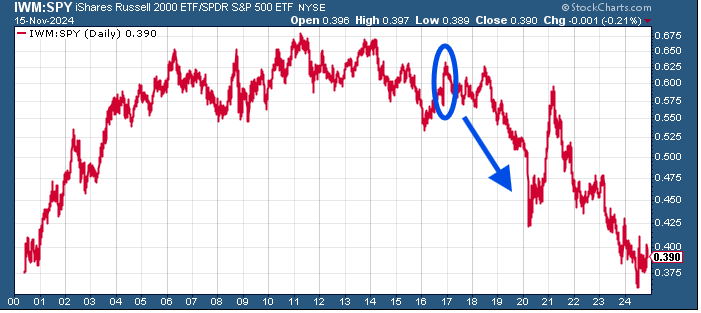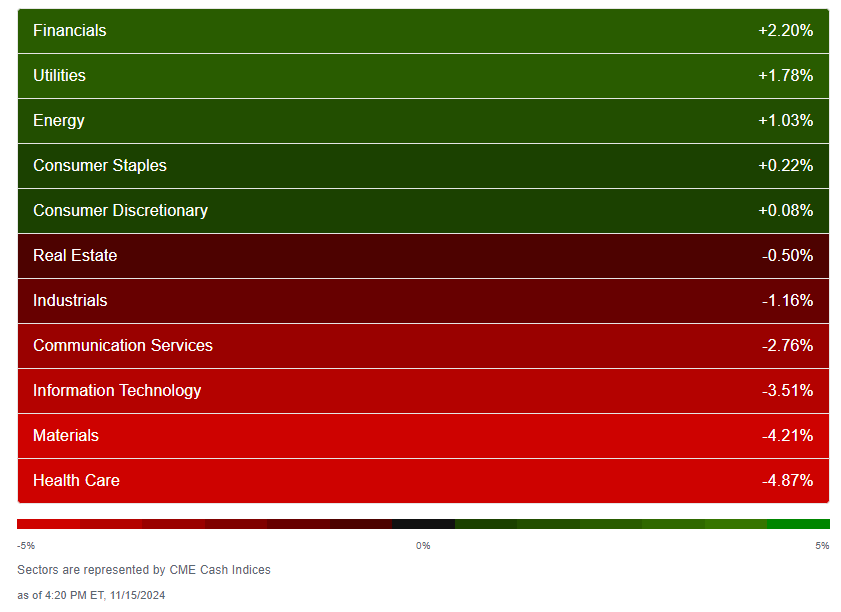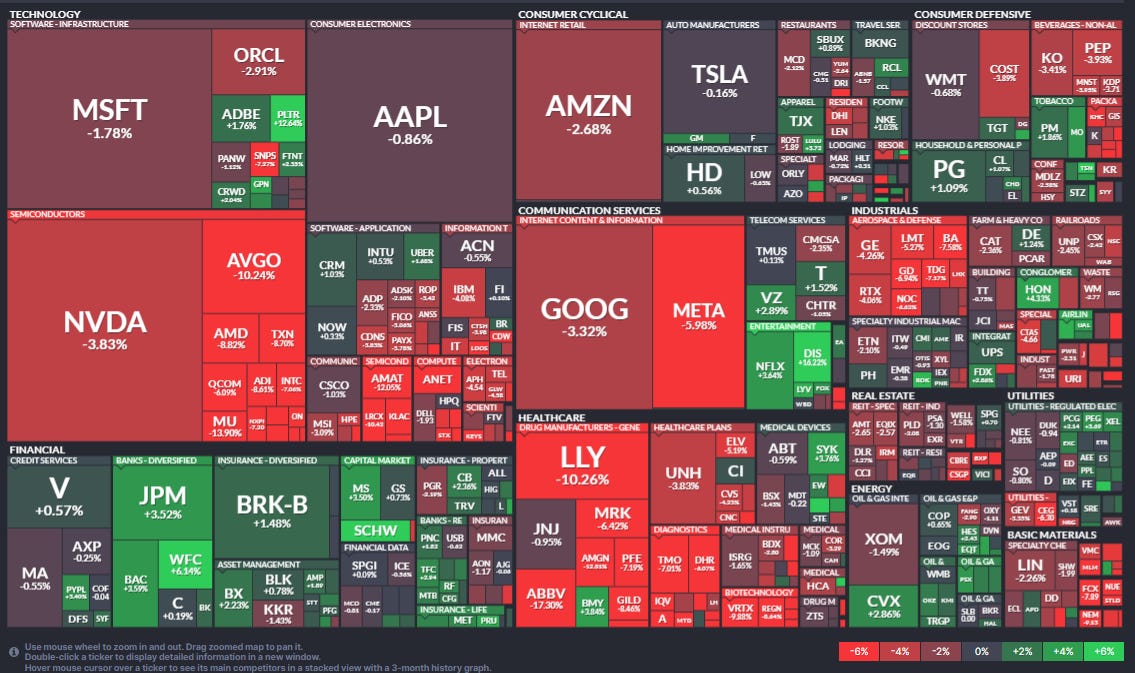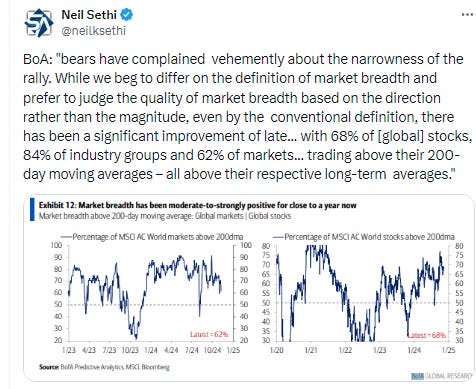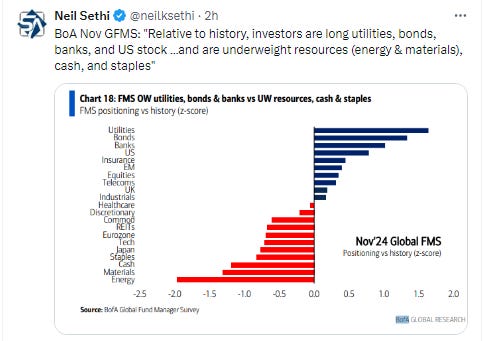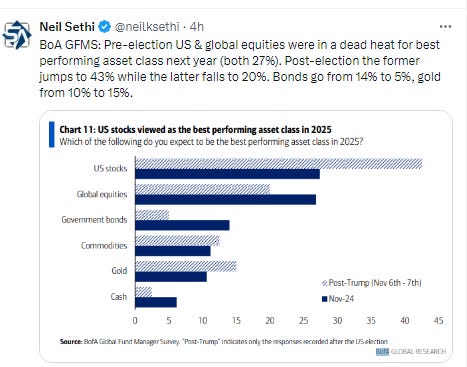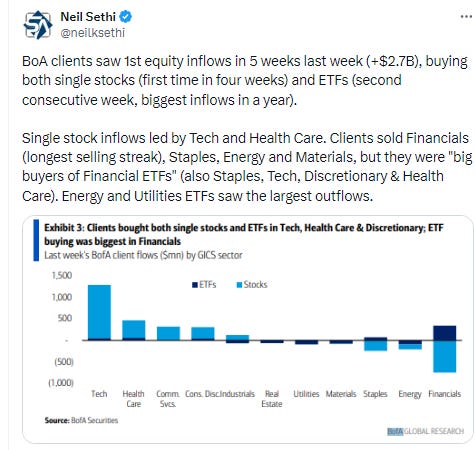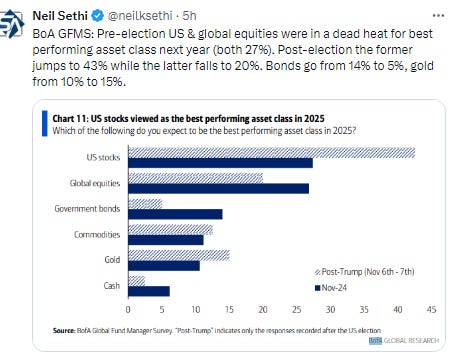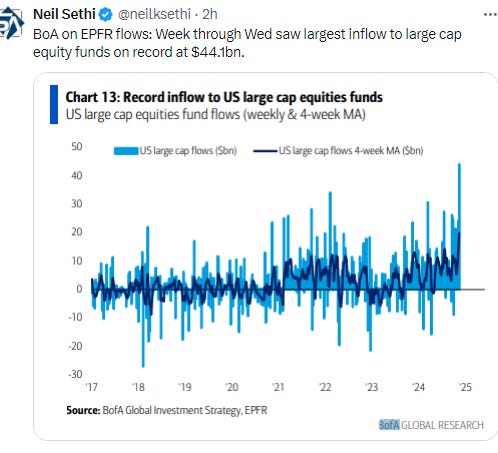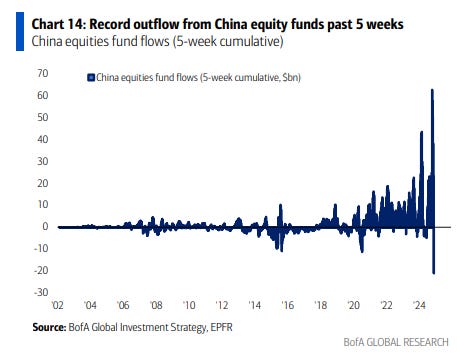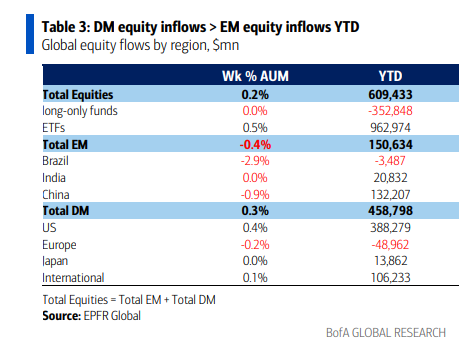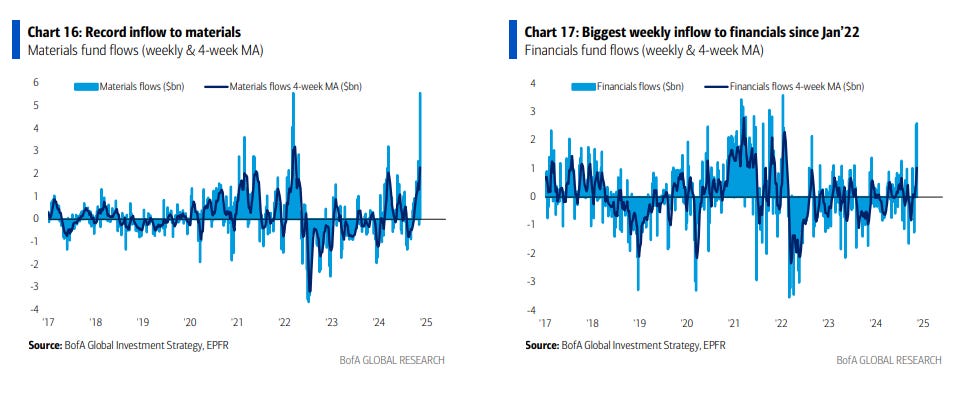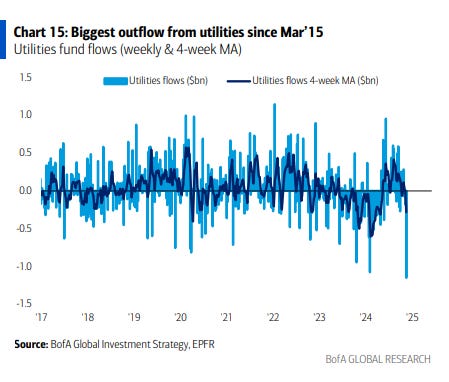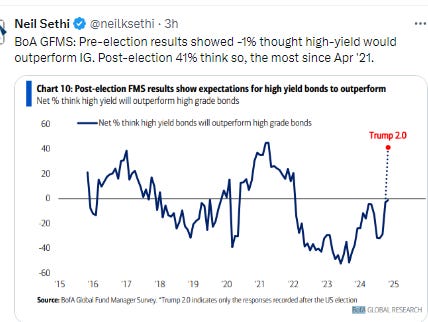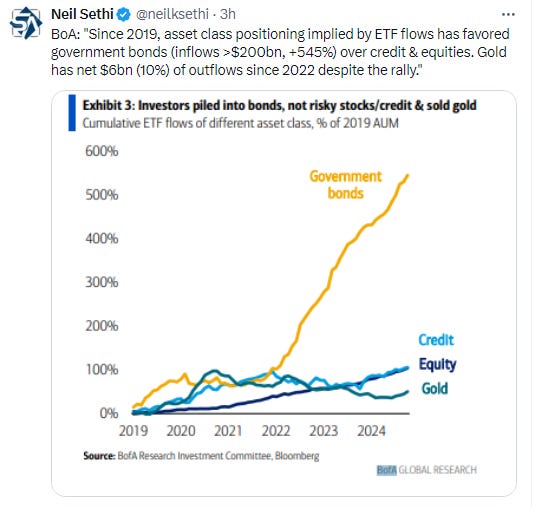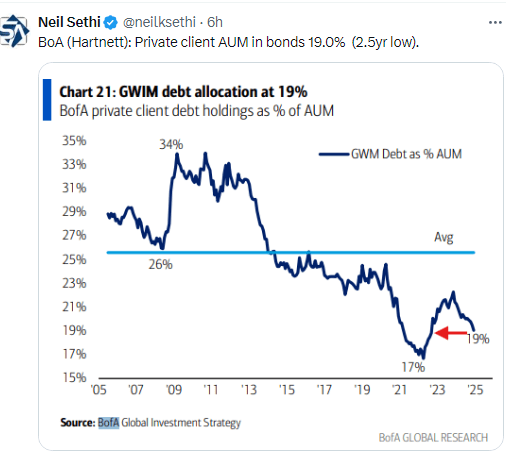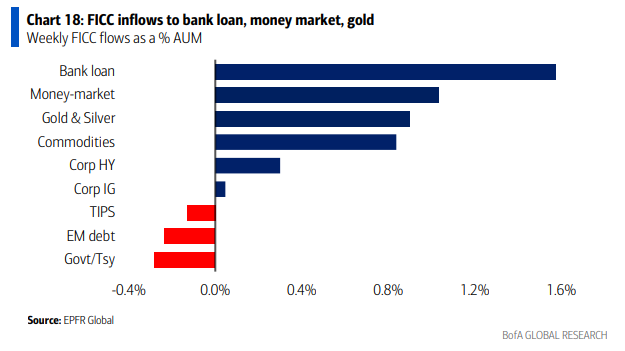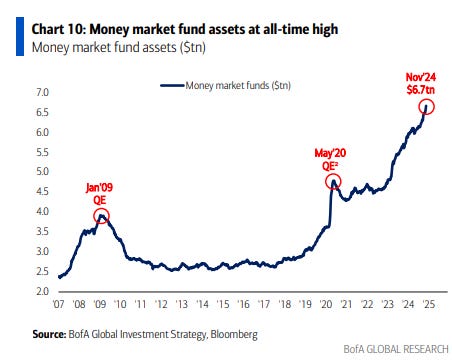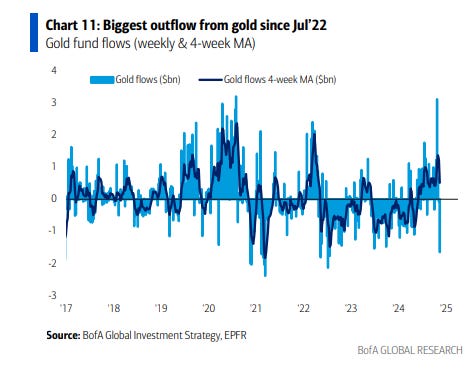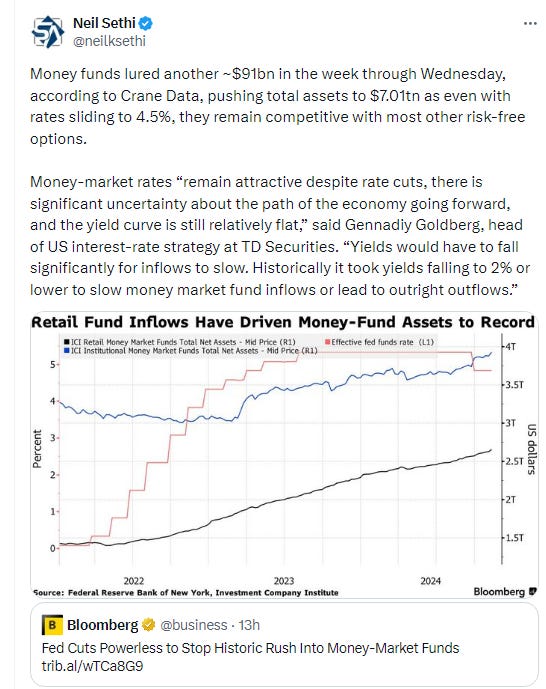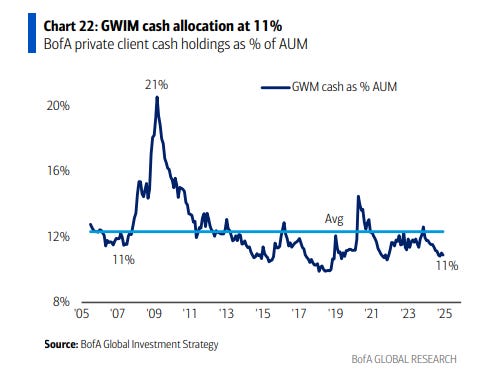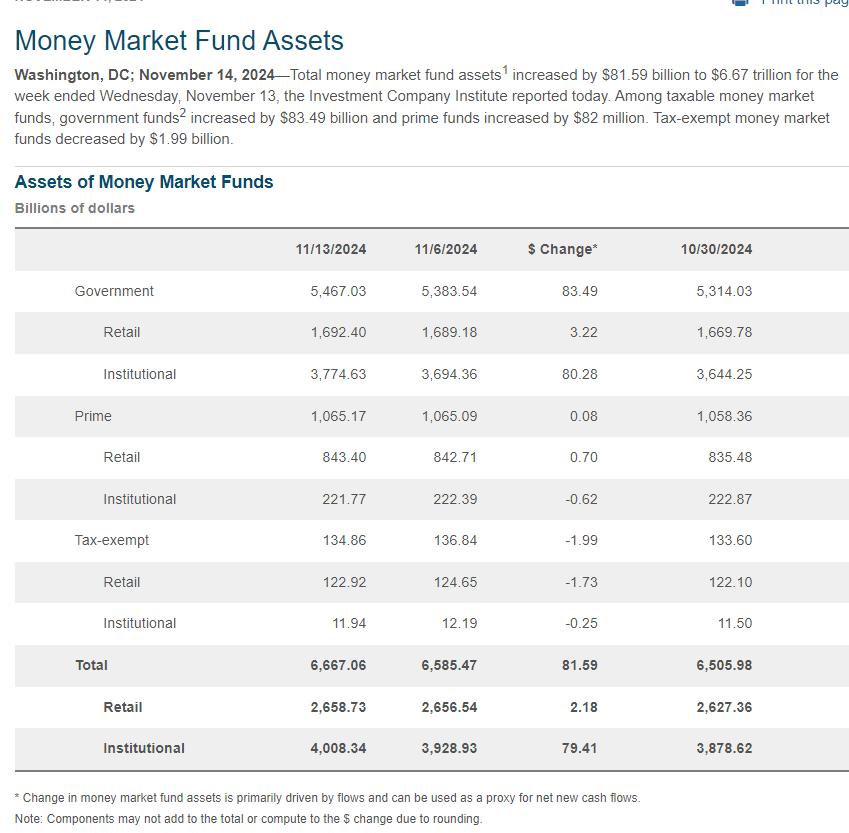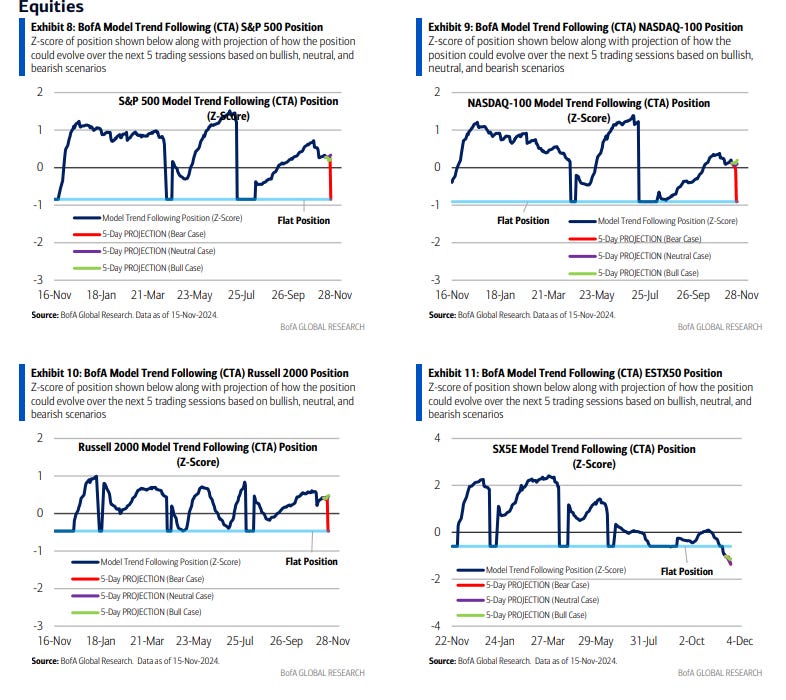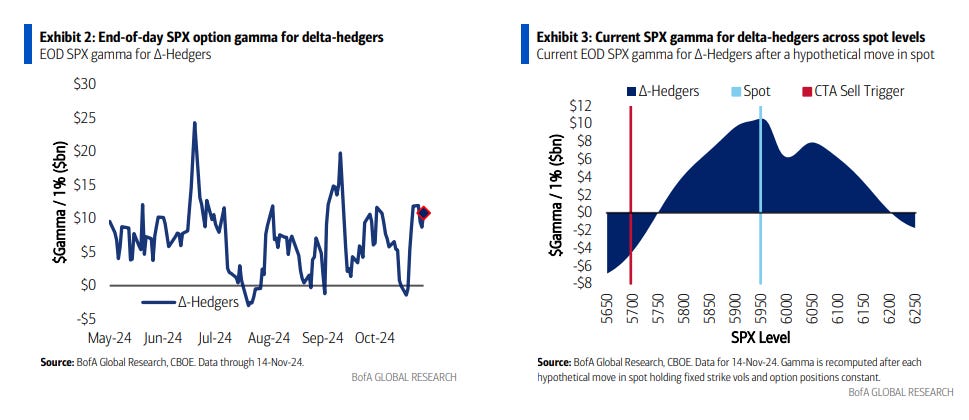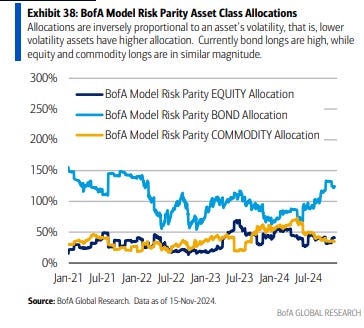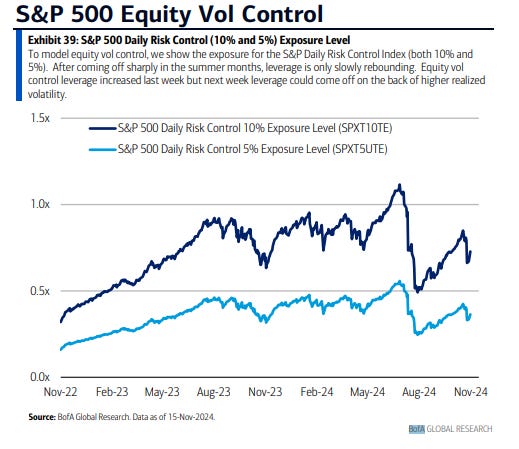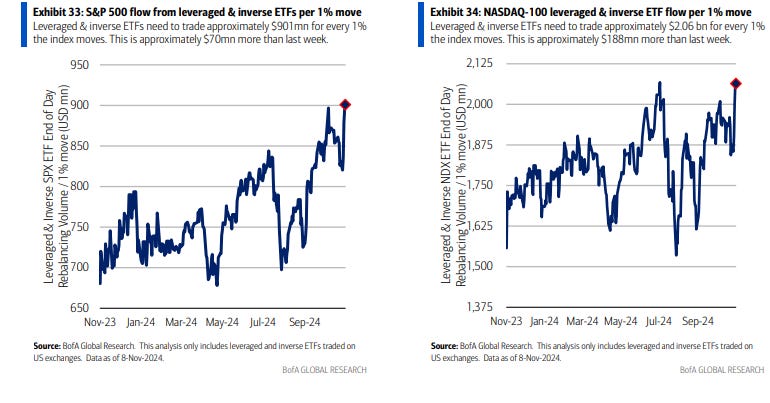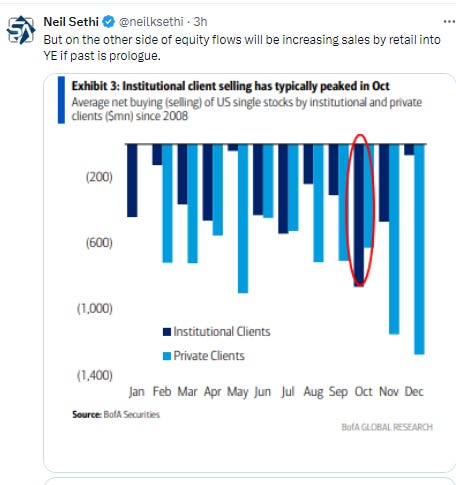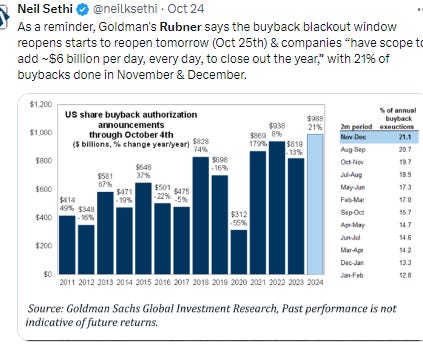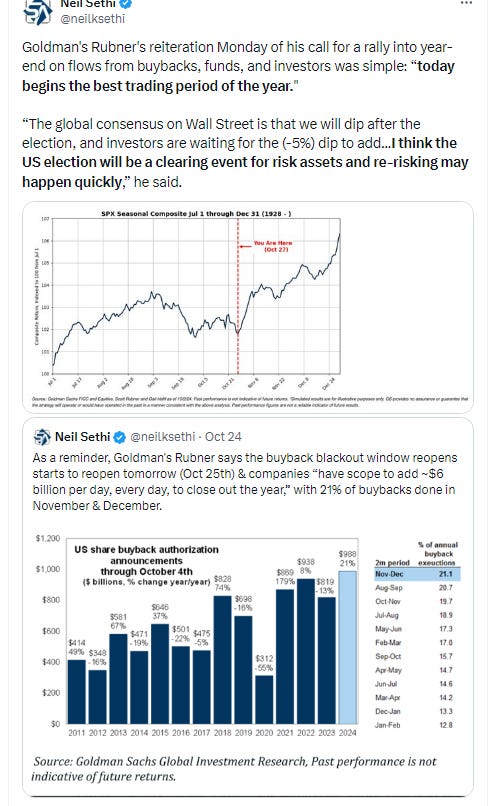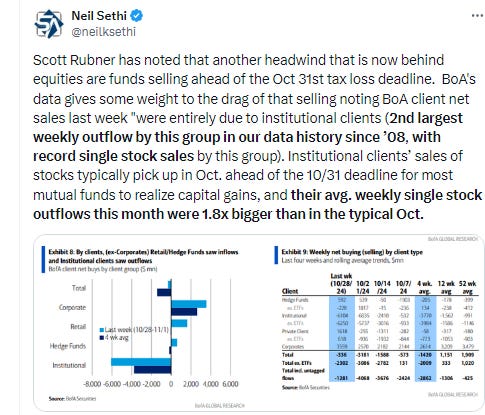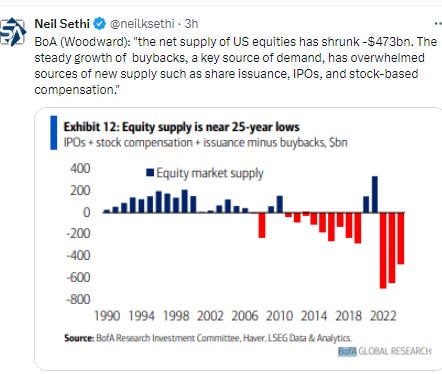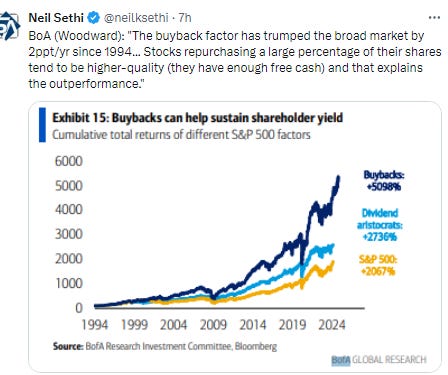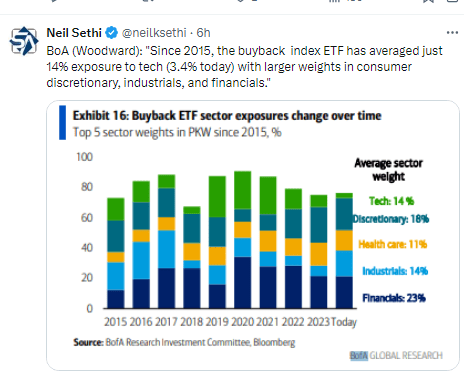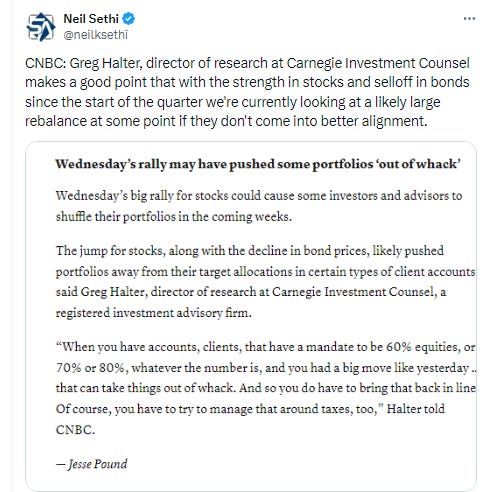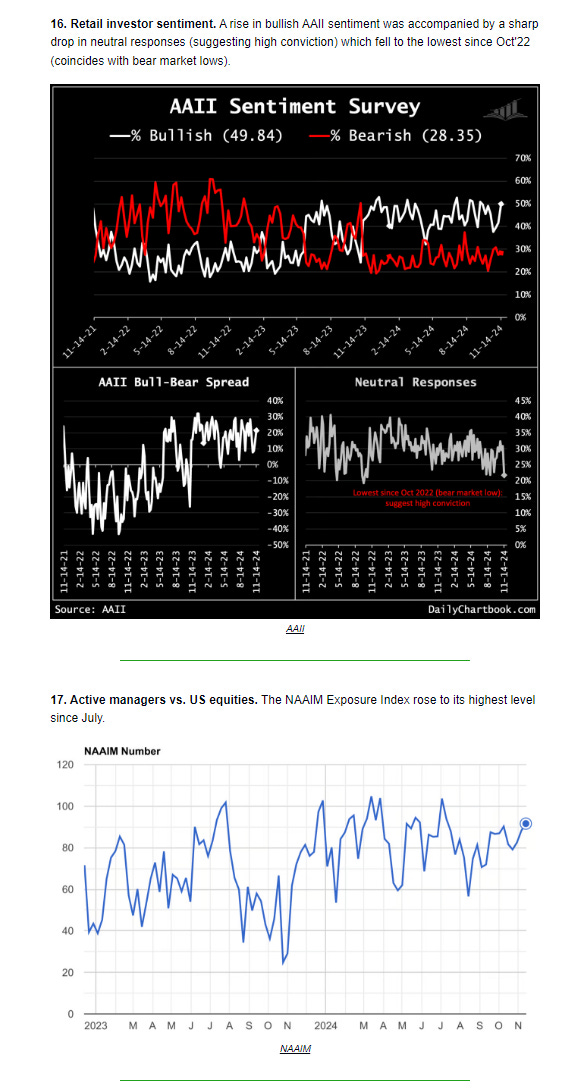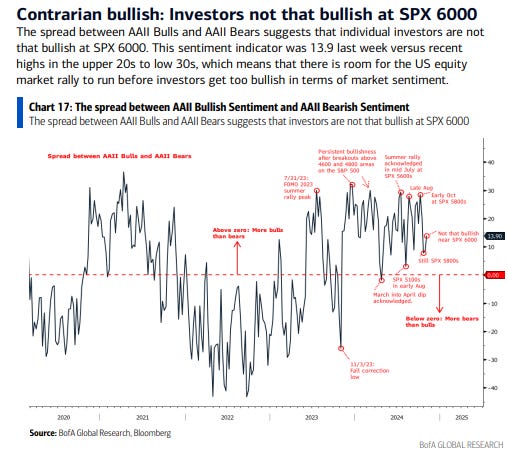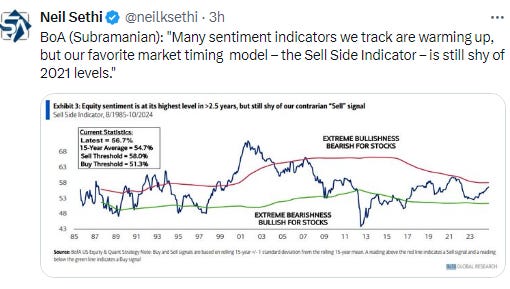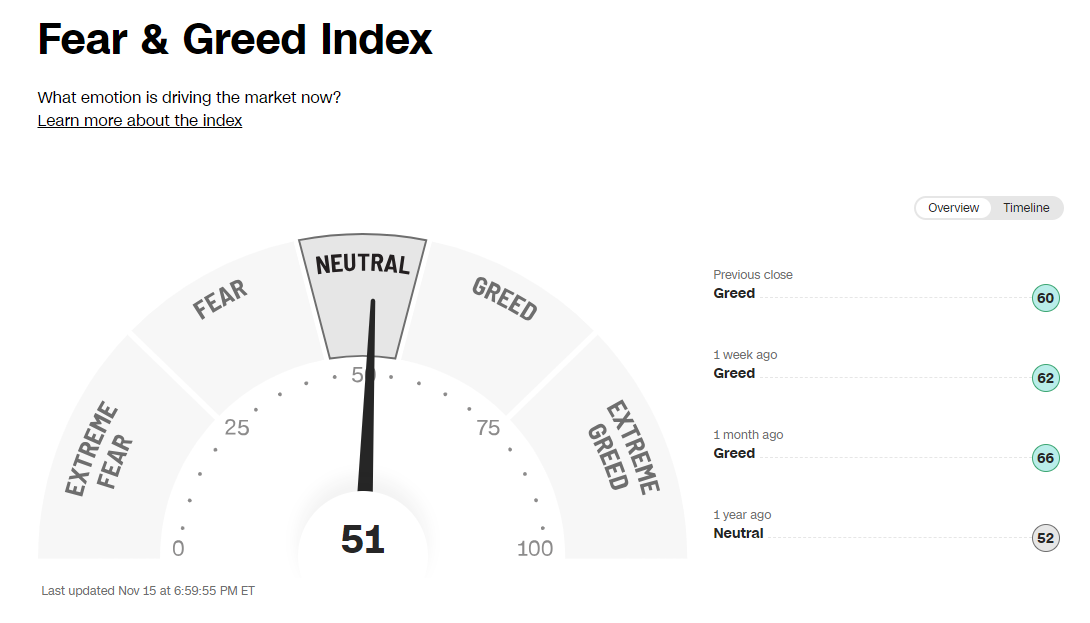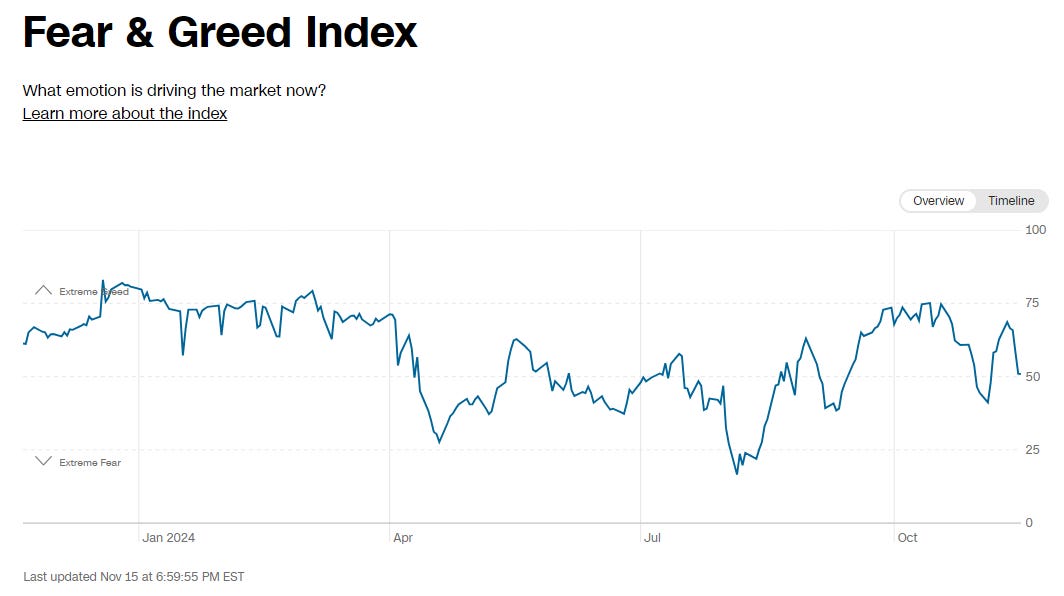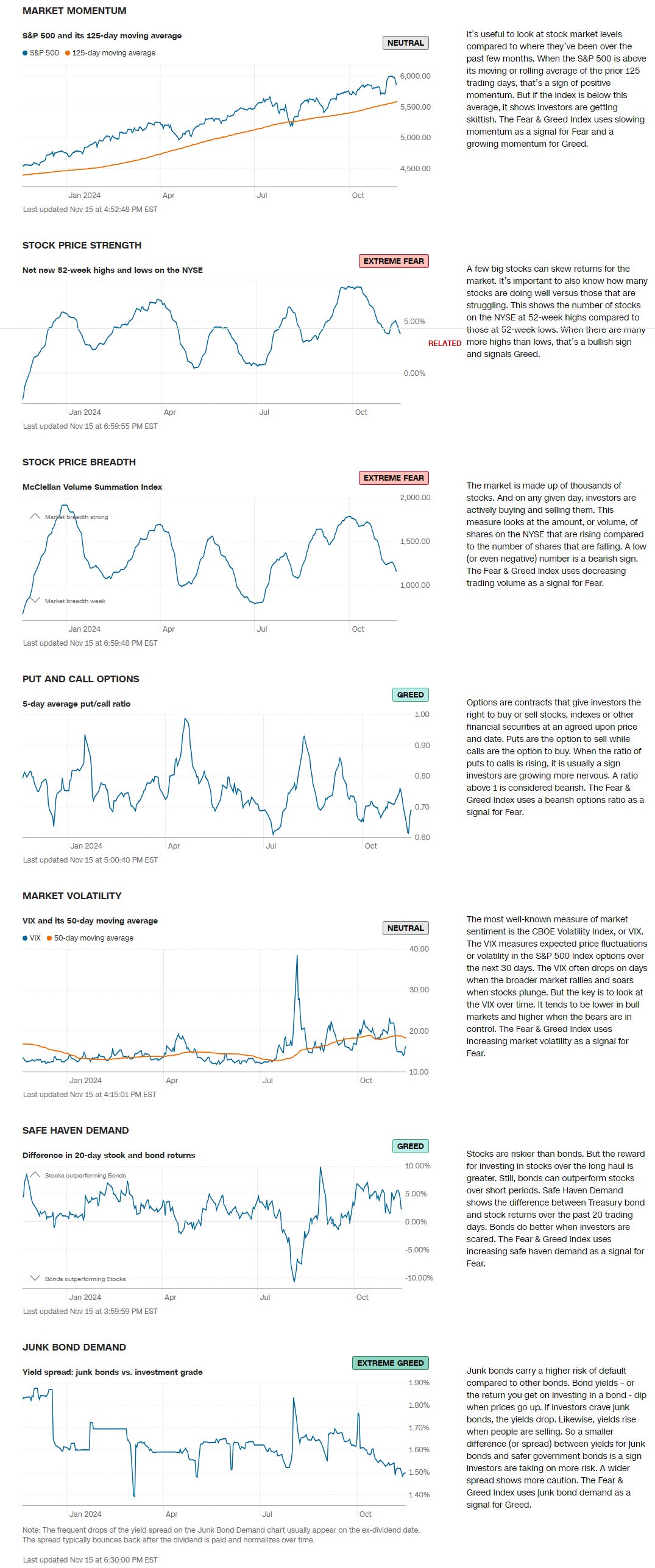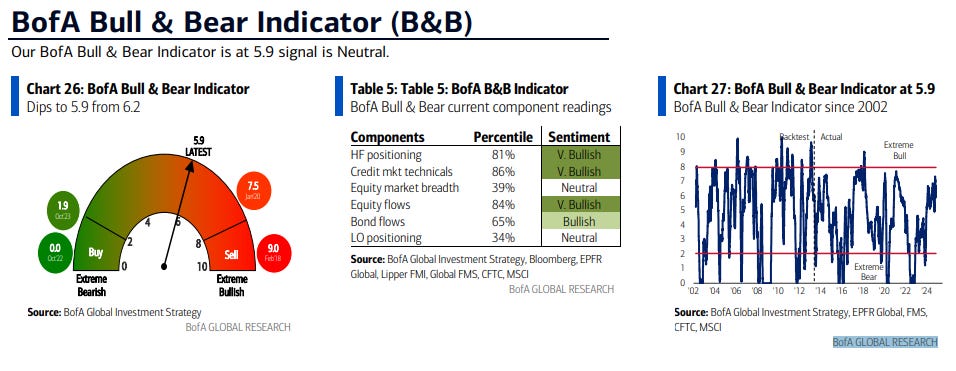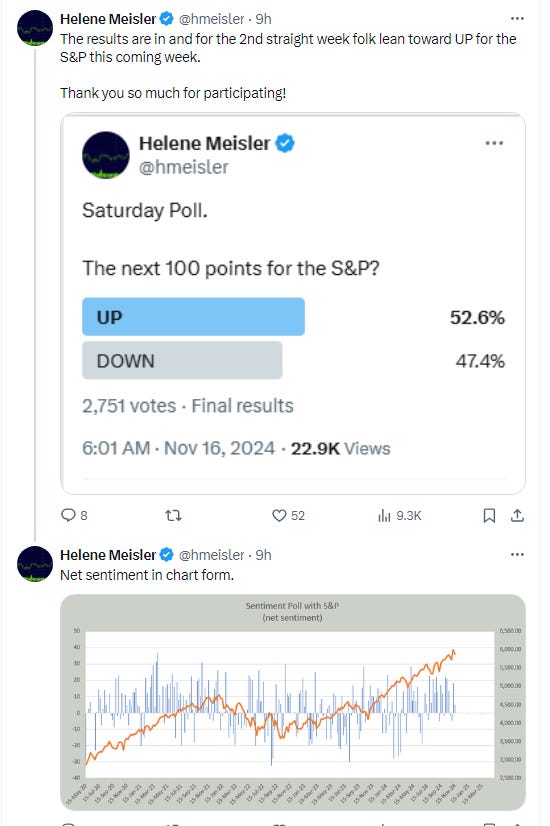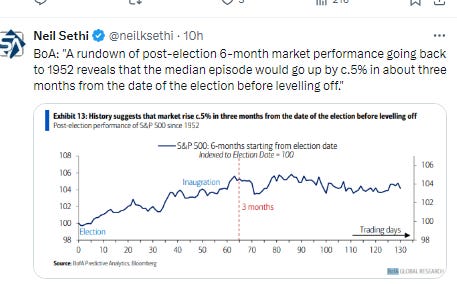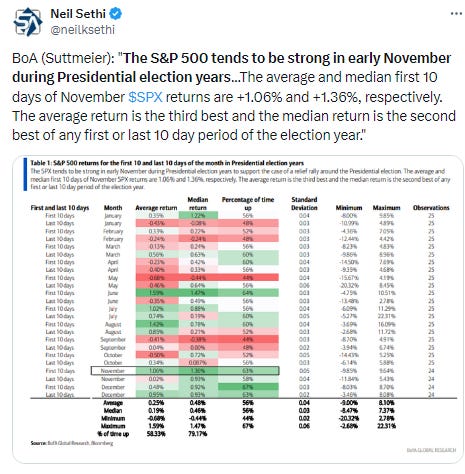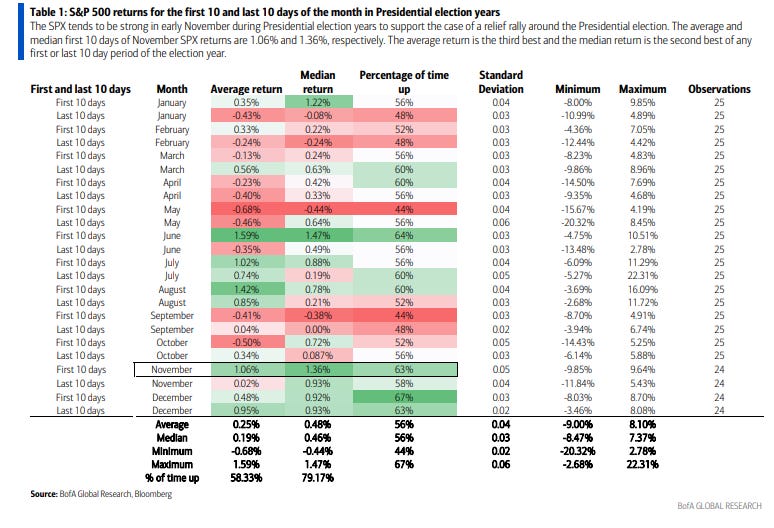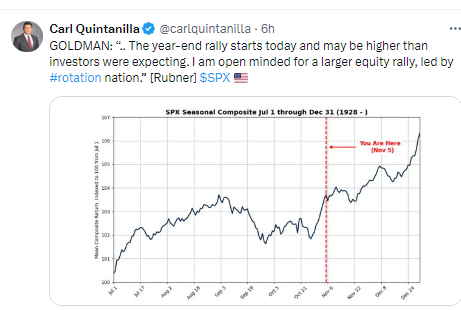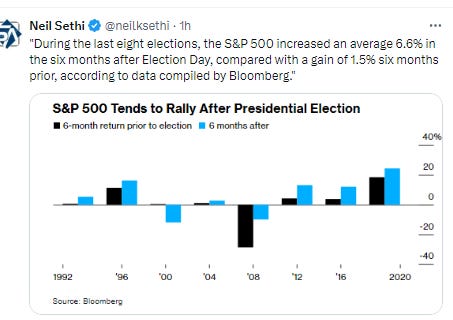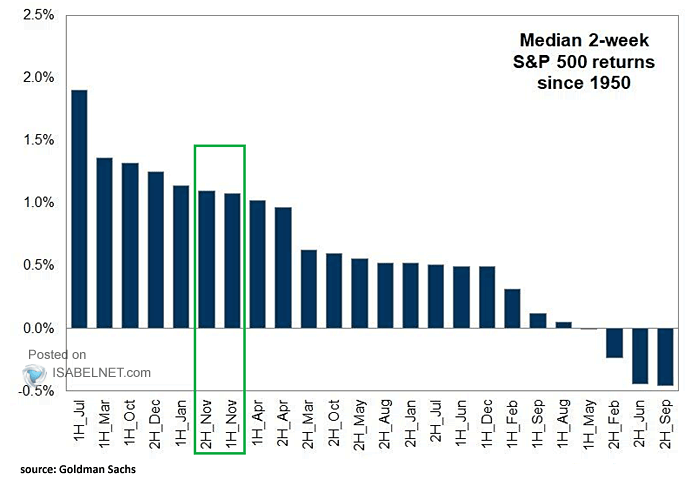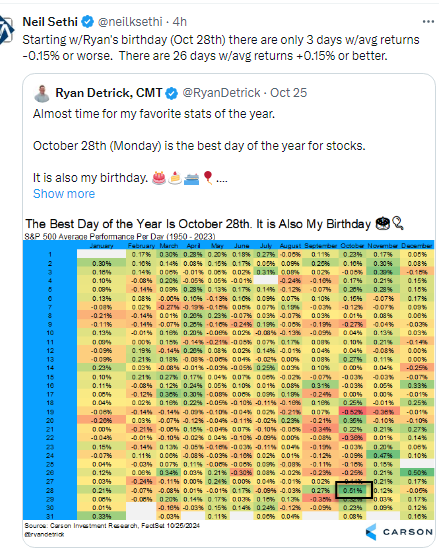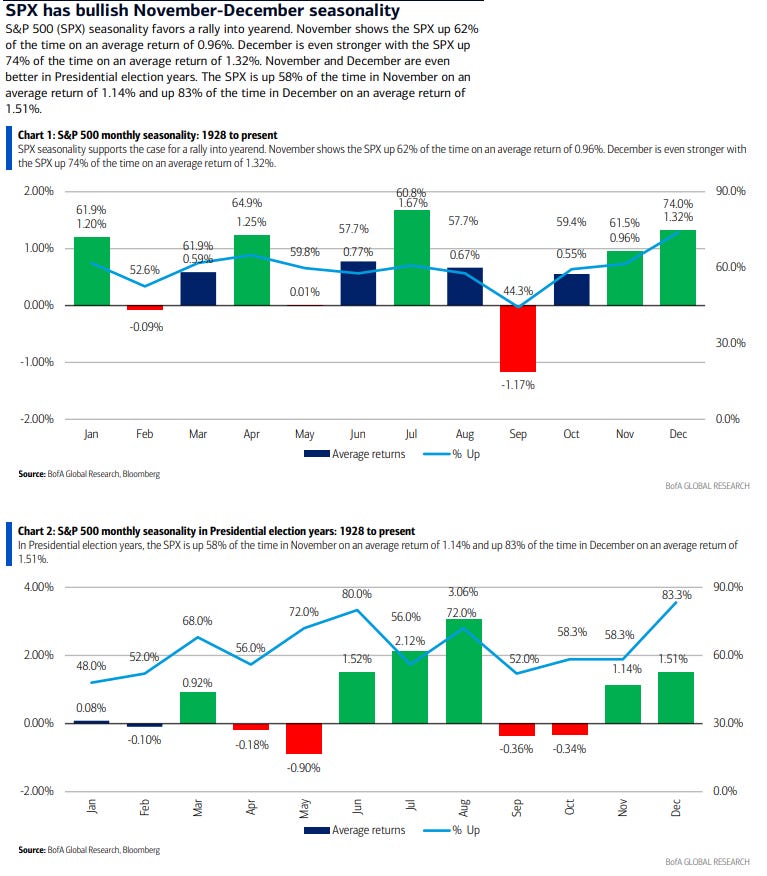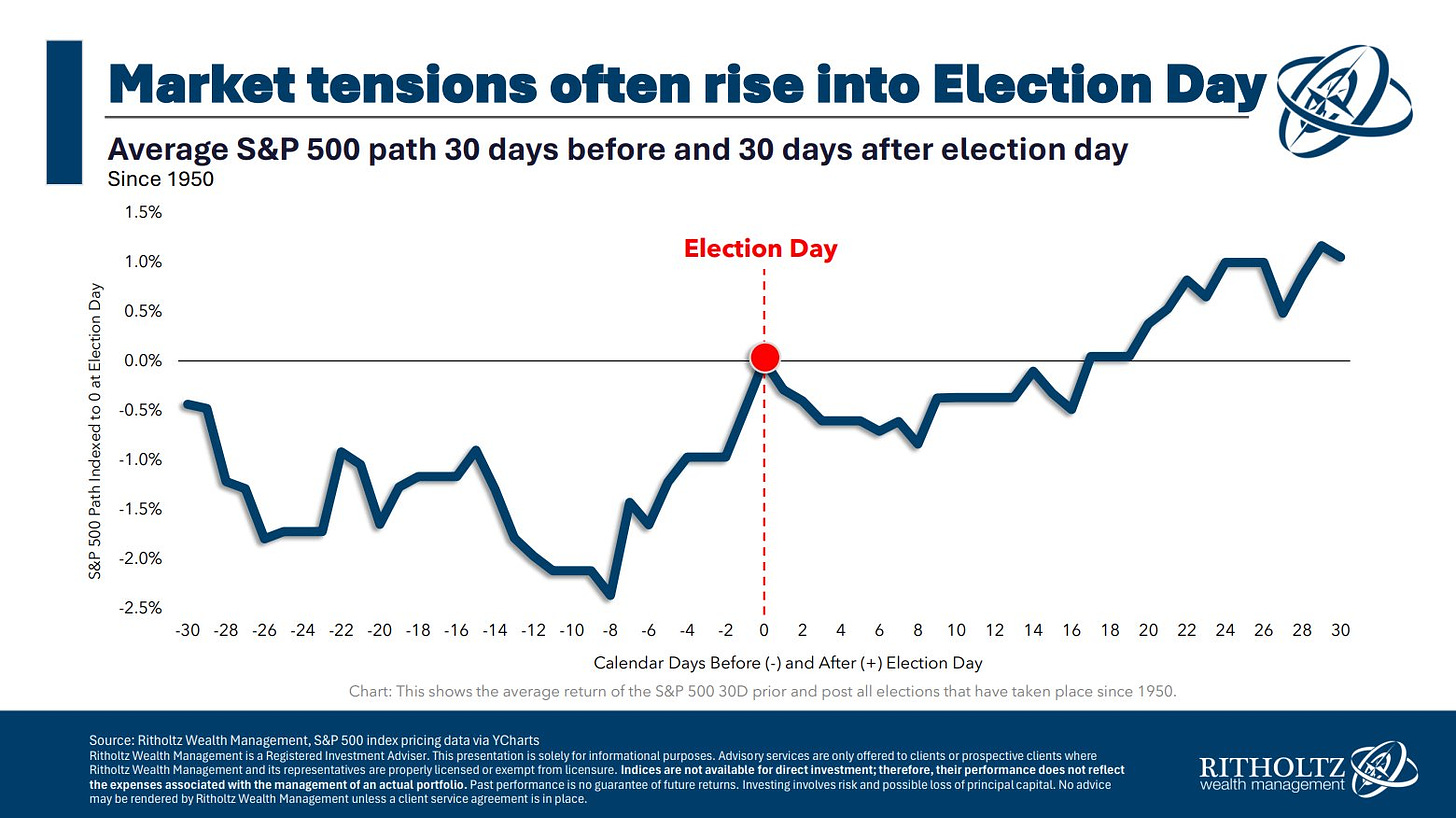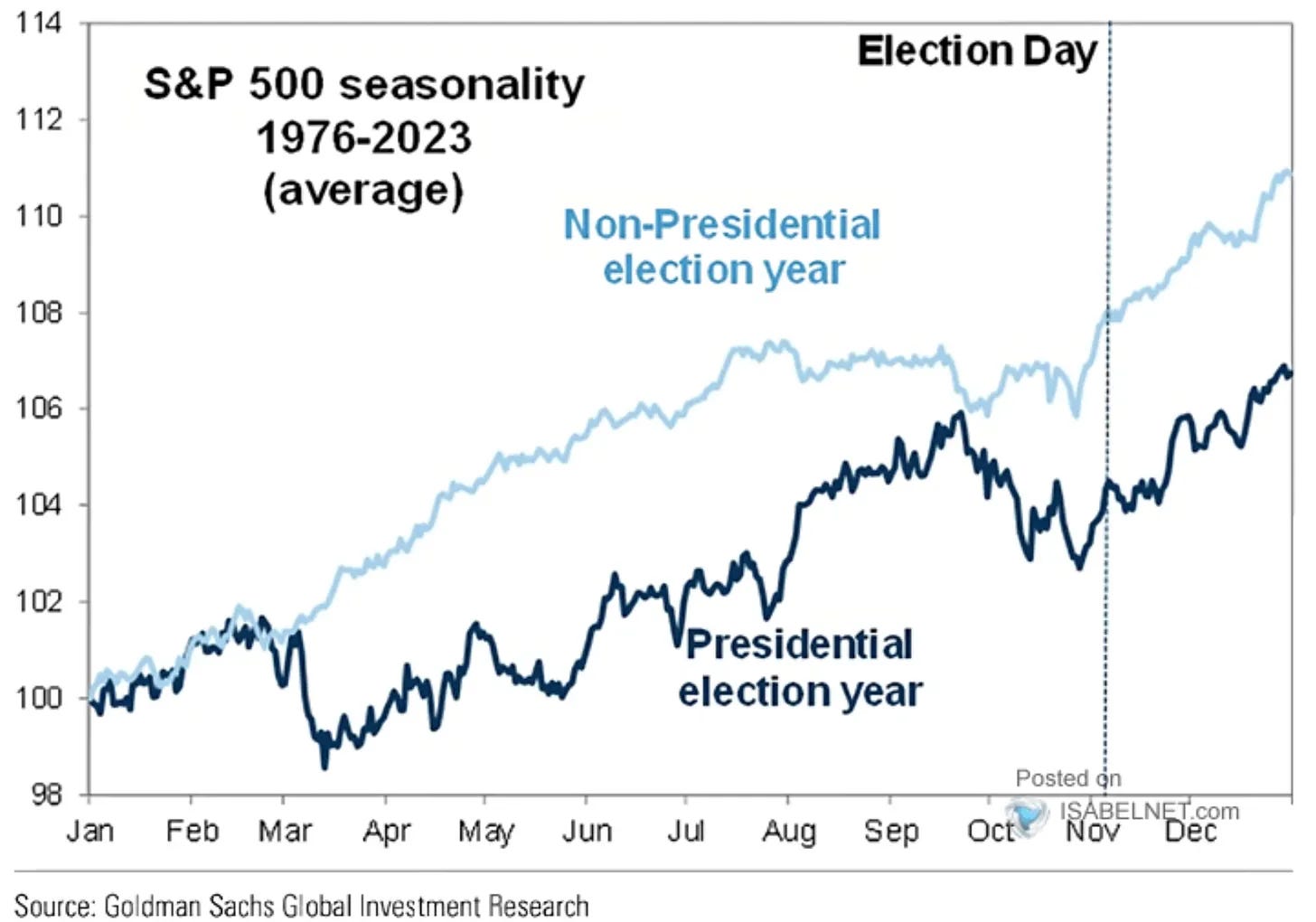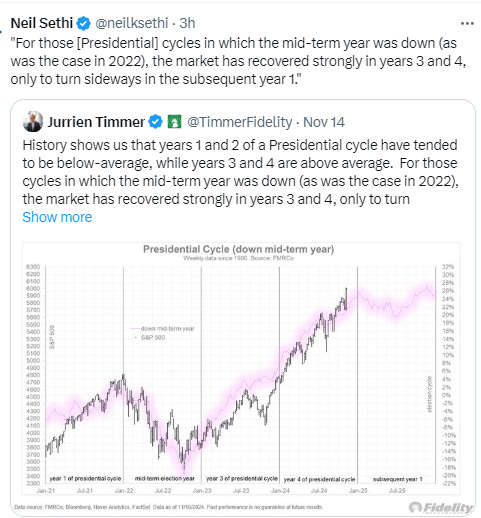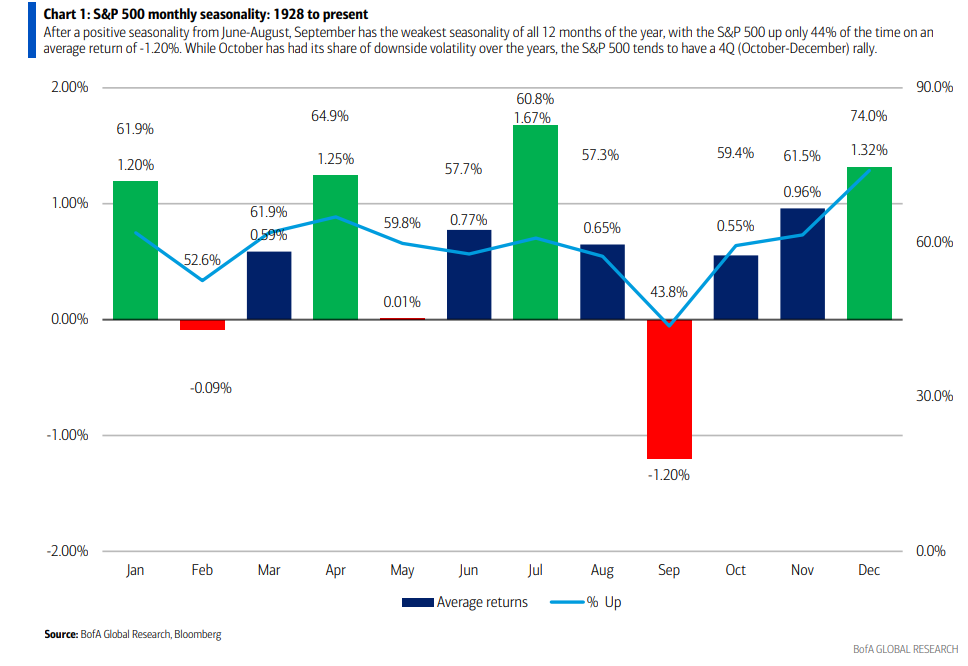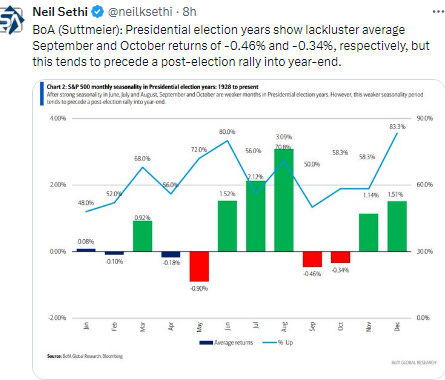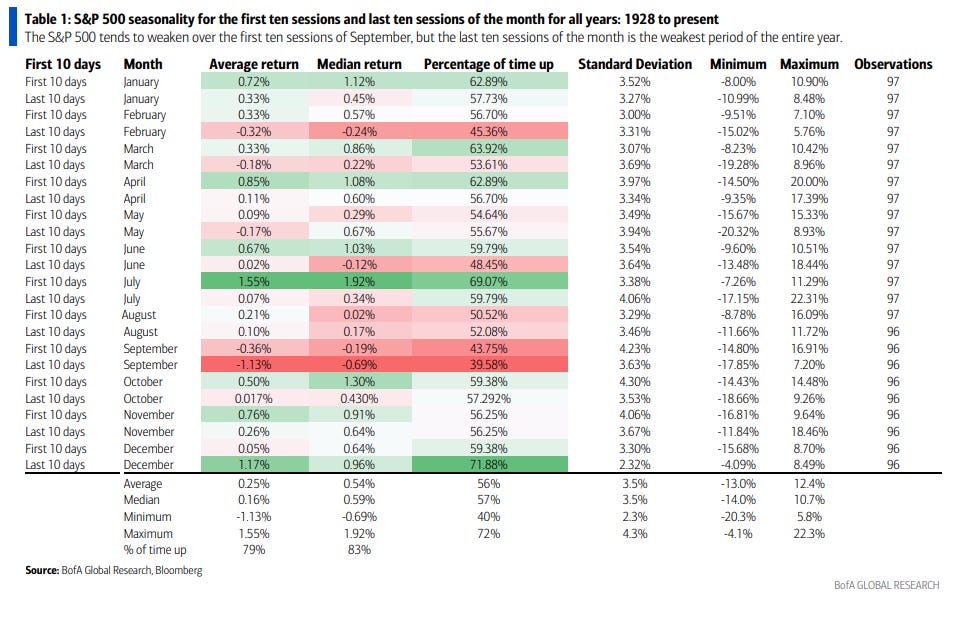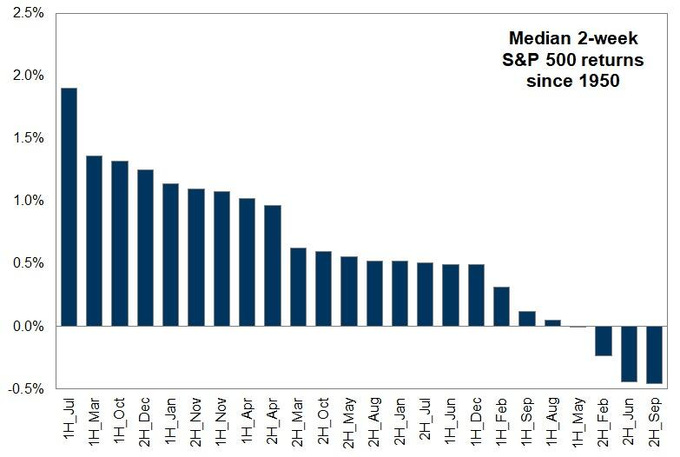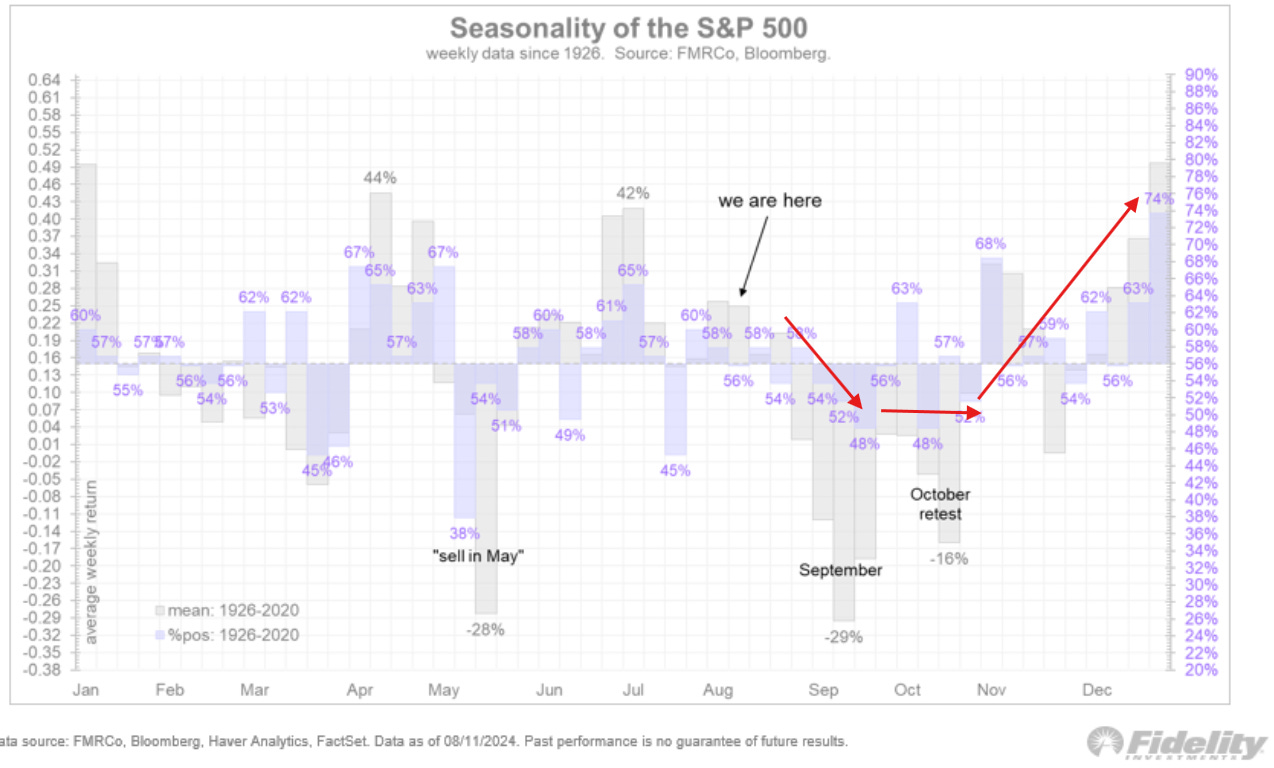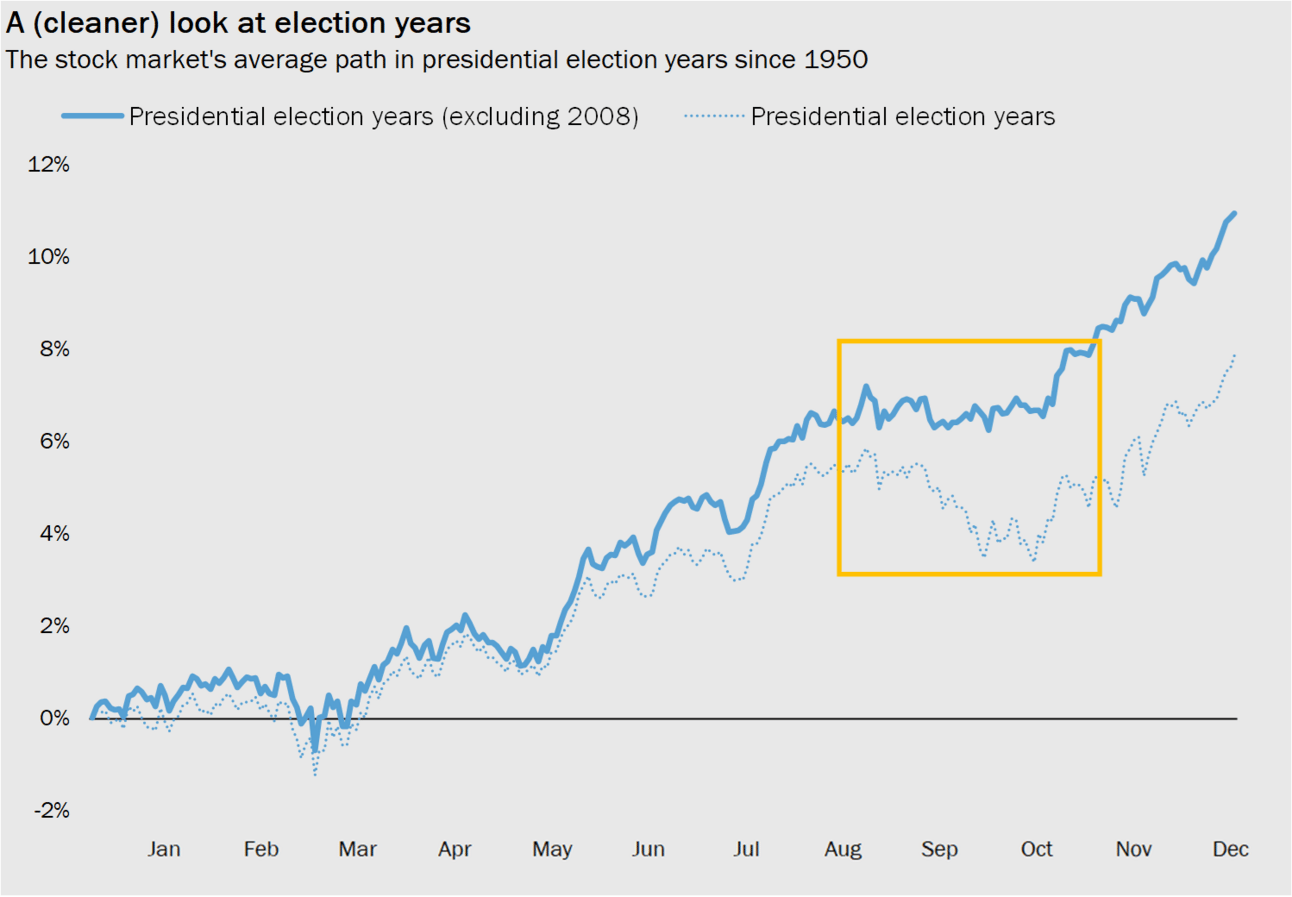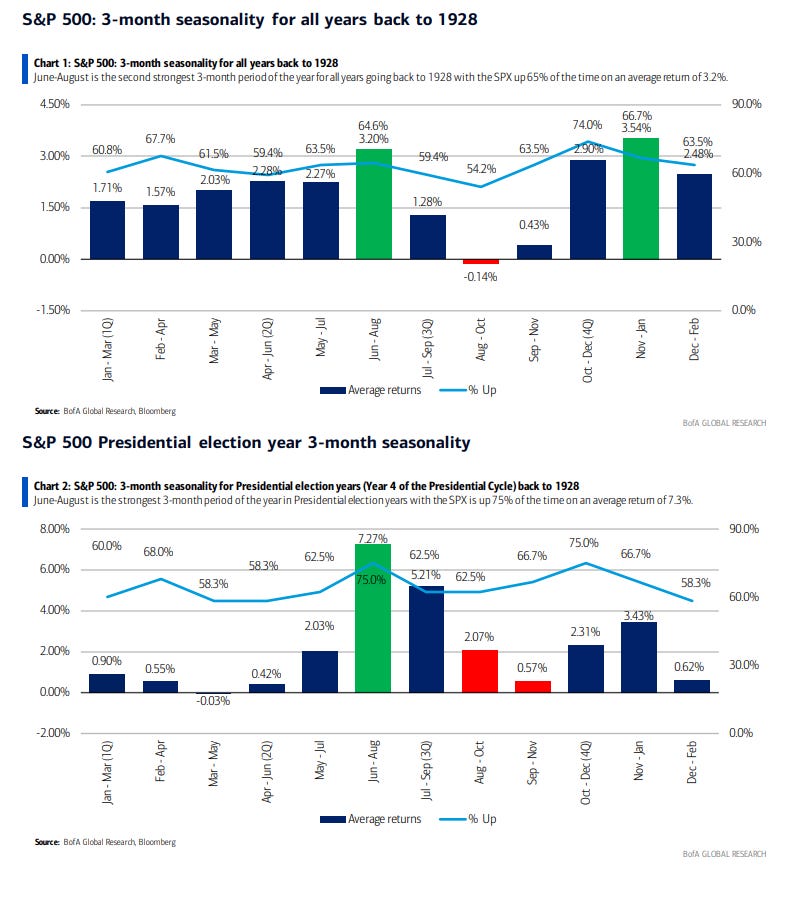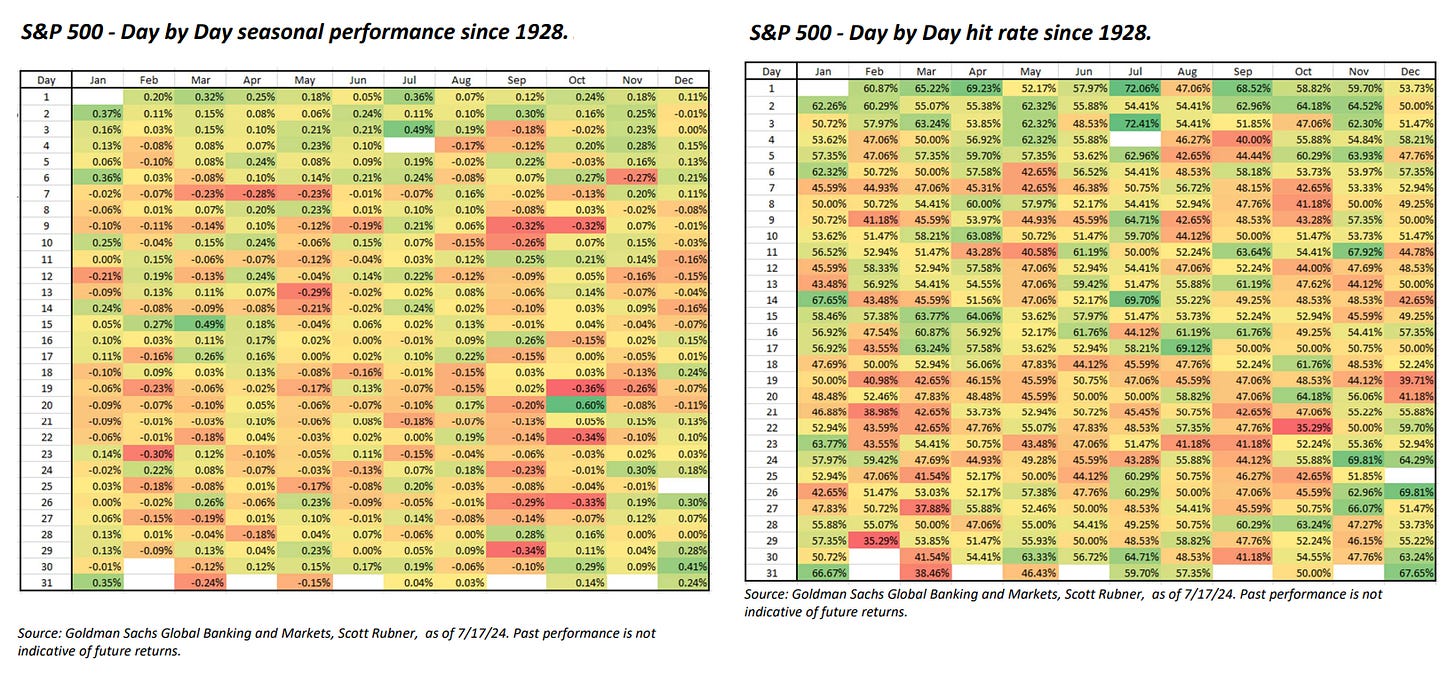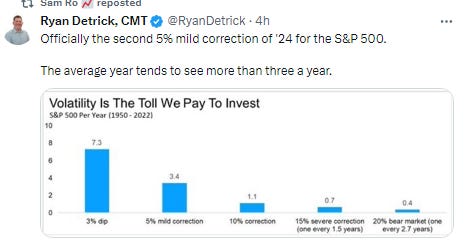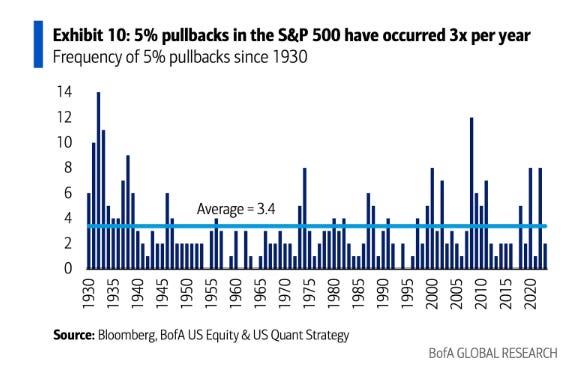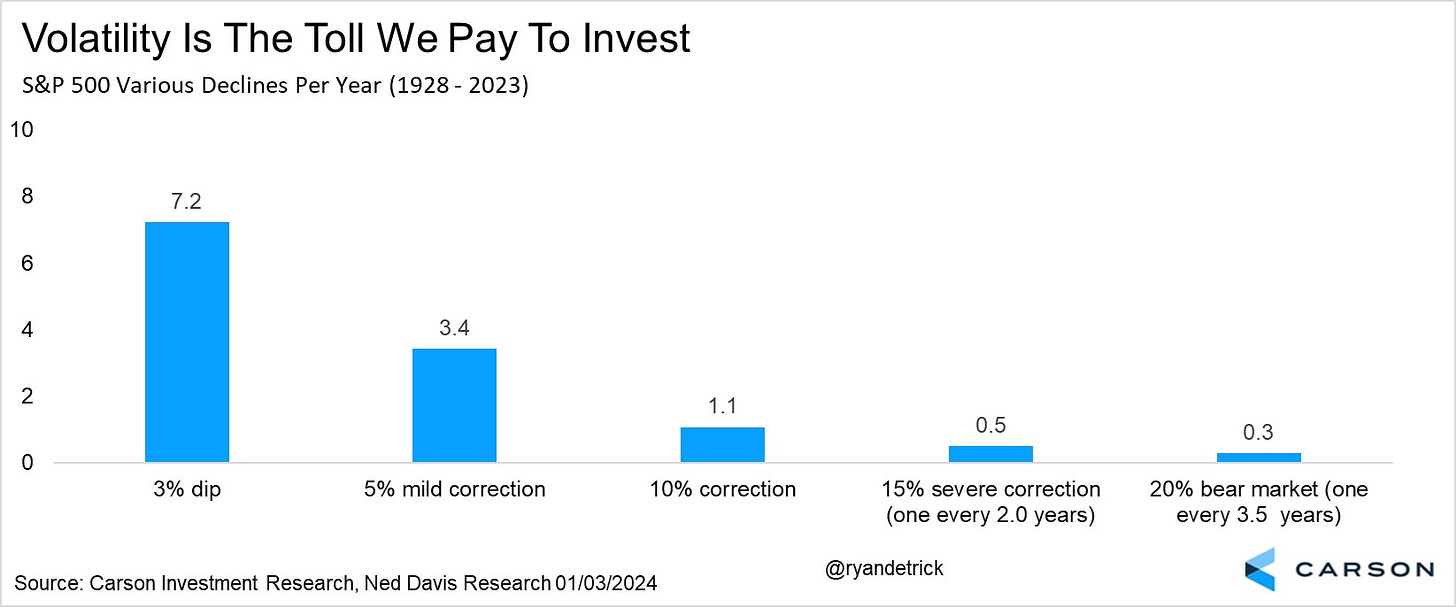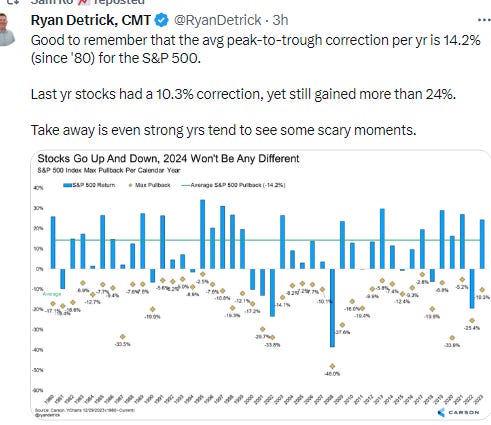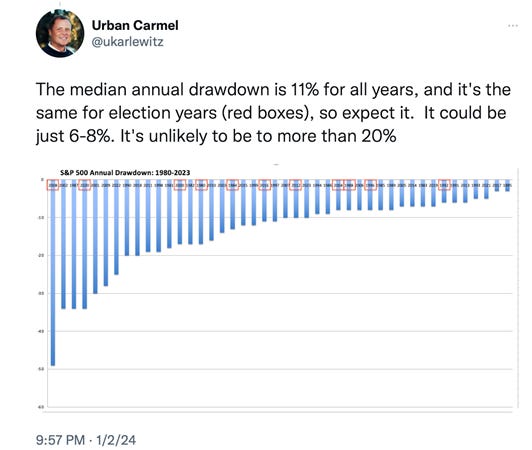The Week Ahead - 11/17/24
A comprehensive look at the upcoming week for US economics, equities and fixed income
If you're a new reader or maybe one who doesn’t make it to the end feel free to take a second to subscribe now (although then you’re missing my hard hitting analysis!). It’s free!
Or please take a moment to invite others who might be interested to check it out.
Also please note that I do often add to or tweak items after first publishing, so it’s always safest to read it from the website where it will have any updates.
As a reminder, some things I leave in from prior weeks. Anything not updated is in italics. As always apologize for typos, errors, etc., as there’s a lot here, and I don’t really have time to do a real double-check.
The Week Ahead
After three catalyst filled weeks packed with key economic data, central bank meetings, earnings reports, policy maker interviews, and, of course the US election and all its associated fallout, the upcoming week will be a welcome opportunity to catch our breath with a lighter week (relatively) on all fronts with the highlight being Nvidia’s earnings on Wed. Of course, that’s no small matter with BoA saying implied volatility for that day exceeds those for the November payrolls and CPI reports and even the Dec Fed meeting despite getting an updated SEP which I can promise you will be market moving (as would a "skip").
In terms of the US economic data this week, a big focus will be housing with housing starts & permits, existing home sales & NAHB homebuilder confidence. We’ll also get the flash PMI’s, Oct leading indicators & final U of Mich Nov sentiment (which will incorporate the election results). And we’ll get the normal weekly reports in jobless claims, mortgage applications, and EIA petroleum inventories.
Fed speakers will remain in focus this week but much lighter than last week when we not only had a heavier slate but also a Powell interview. Focus will be on their thoughts on a December cut (so far, we’ve seen a split between those who say they expect the FOMC to cut in December (Bostic, Kashkari, Goolsbee, etc.) and those who aren’t sure (Collins, Barkin, Logan, Schmid, Bowman, Musalem, etc.). Not all of those of course are voters either. All seem to think the neutral rate has risen from pre-pandemic levels, but all also agree that it’s lower than where Fed Funds is now (so right cuts are “appropriate” so long as inflation cooperates). BoA has Goolsbee (who we heard from a few times last week) and Hammock (who we haven’t heard from recently) on their calendar while BBG says that Lisa Cook and Jeff Schmid have scheduled events this week as well.
US Treasury auctions will also be light with just a $16bn 20-yr bond auction and $17bn 10-yr TIPS reopening Wed & Thurs respectively.
Earnings pick up if only because we bring in the biggest company in the SPX in Nvidia. We also get Wal-Mart who, while at $690bn is a fraction of Nvidia’s nearly $3.6tn market cap, is no slouch. In total we’ll get 14 SPX components representing 6% of earnings weight. Other >$100bn in market cap are Lowe’s, Medtronic, TJX, Palo Alto Networks, Intuit & Deere.
From Seeking Alpha (links are to their website, see the full earnings calendar):
Earnings spotlight: Monday, November 18 - Trip.com Group (TCOM), Symbotic (SYM), AECOM (ACM), BellRing Brands (BRBR), and Brady Corp. (BRC).
Earnings spotlight: Tuesday, November 19 - Walmart (WMT), Lowe’s (LOW), Medtronic (MDT), Keysight Technologies (KEYS), and Viking Holdings (VIK).
Earnings spotlight: Wednesday, November 20 - NVIDIA (NVDA), TJX (TJX), Palo Alto Networks (PANW), Target (TGT), and Snowflake (SNOW).
Earnings spotlight: Thursday, November 21 - Intuit (INTU), Deere & Company (DE), Ross Stores (ROST), Construction Partners (ROAD), NetApp (NTAP), and BJ’s Wholesale Club Holdings (BJ).
Earnings spotlight: Friday, November 22 - The Buckle (BKE), and Global Blue Group Holding (GB).
Ex-US the focus will be on CPI with readings from the UK, Japan, Mexico and Canada having the potential to influence upcoming central bank decisions. Also global flash PMI’s will be a focus. There are monetary policy meetings in Turkey, South Africa, Indonesia, Hungary, and Egypt.
Statistics Canada will release consumer-price data for October, and early estimates suggest inflation may have stayed below the Bank of Canada’s 2% target. The data may help settle a debate over whether officials should cut borrowing costs by 25 or 50 basis points next month.
Lenders in China, in line with guidance from the People’s Bank of China, are expected to hold loan prime rates steady after making larger-than-expected cuts last month, leaving the 1-year and 5-year rates at 3.1% and 3.6%, respectively. Bloomberg Economics forecasts another 10 basis points of reductions before the end of the year. Elsewhere, Indonesia’s central bank may trim its benchmark rate on Wednesday by a quarter-point, to 5.75%, after consumer inflation eased to the slowest pace in three years. Bank of Japan Governor Kazuo Ueda will speak at an annual event on Monday that’s sure to attract close scrutiny for any hints on the timing of the central bank’s next rate hike. At the end of the week, Japan is expected to report that consumer inflation eased a tad in October, to 2.2% — a result that would extend the streak of months at or above the BOJ’s target to 31 months. Trade figures are due during the week from Malaysia, Japan, Singapore, South Korea and Taiwan.
UK inflation probably surged back above the Bank of England’s target in October, reinforcing the case for policymakers to act cautiously when cutting interest rates. The consumer price index due on Wednesday rose an annual 2.2%, according to the median of 24 forecasts in a Bloomberg survey. That’s up from 1.7% last month, when it slipped below the BOE’s 2% target for the first time in more than three years. While the headline gauge is seen quickening because of higher energy costs, underlying measures including services inflation are likely to have weakened slightly. The overall picture — of slowly moderating but still-excessive price growth — may support the BOE’s gradual approach toward monetary easing so far. BOE Governor Andrew Bailey will be grilled on inflation and monetary policy when he appears before lawmakers on the eve of the data release. Alongside Bailey will be colleagues including Alan Taylor, making his first public remarks as a rate-setter since joining the policy committee in September. A glimpse into the health of the UK consumer will arrive on Friday, when retail sales data for October are released. Economists anticipate the numbers showing the first decline in four months. Purchasing manager surveys come out the same day.
A hectic week is in store for investors tracking the European Central Bank. Multiple appearances by policymakers are scheduled, including two by President Christine Lagarde. In all, more than half of the Governing Council will speak. The ECB will also publish its quarterly wage indicator on Wednesday — a key metric for officials gauging pipeline price pressures — and then its latest assessment of euro-zone financial risks the following day. Among data releases, the final measure of inflation for October on Tuesday, consumer confidence on Thursday, and then purchasing manager surveys the following day may be highlights. product numbers on Wednesday, with Norway doing so a day later. And in Switzerland, policymaker Petra Tschudin and Swiss National Bank chief Martin Schlegel are scheduled to speak toward the end of the week.
A number of monetary decisions are on the calendar across the region:
On Tuesday, Hungary’s central bank is poised to keep its rate unchanged after a currency slide following Donald Trump’s election victory.
Angolan officials may also leave borrowing costs on hold, anticipating inflation will continue to slow.
Icelandic policymakers on Wednesday are widely expected to deliver a half-point rate cut, following up on last month’s initial reduction of the current cycle.
In South Africa on Thursday, officials may lower borrowing costs by another 25 basis points, after data the previous day are forecast to show inflation slowing toward the bottom of the central bank’s 3% to 6% target range.
Rwanda will probably lower its rate by a half point the same day.
Also on Thursday, Egypt’s central bank may keep borrowing costs steady for a fifth straight meeting, delaying an easing cycle until inflation slows significantly.
Similarly, Turkey is foreseen staying on hold at 50%, after price growth failed to weaken as quickly as policymakers hoped.
Eswatini, whose currency is pegged to the rand, will likely follow South Africa and reduce its key rate by a quarter point on Friday.
Colombian data out Monday should underscore some of the weakness at the margins of the economy, even as July-September output numbers show a pickup from the previous three months. In Chile, third-quarter GDP figures are likely to show a rebound from an April-June slump, though monthly GDP-proxy readings suggest the economy is losing momentum. Strong second-quarter growth seen in Peru may extend well into the second half. Third-quarter output data will likely show momentum holding steady near the 3.6% annual pace of the three months through June. The consensus among economists is that Argentina’s recession will begin to ease in the fourth quarter after a deep July-September slump, though the September economic activity reading will likely come in above August’s -3.8% result. The week winds up with a fairly complete snapshot of Mexico, Latin America’s second-biggest economy. Mid-month consumer price data may highlight why Banxico marked up its fourth-quarter inflation estimate to 4.7% from 4.3%. Retail sales in September may have risen for a third month, while the final third-quarter output report will reaffirm that Mexico’s economy rebounded on resilient domestic demand and trade with the US, its No. 1 trade partner.
And here’s BoA’s cheat sheets for the upcoming week.
And here’s a calendar of 2024 major central bank meetings.
Market Drivers
So let’s go through the list of items that I think are most important to the direction of equity markets:
Fed/Bonds
As noted previously this was one of the sections that had grown unwieldy, so I’ve really pared it down. Given I provide daily updates on Fed expectations, Fedspeak, and analyst thoughts on the Fed, it’s duplicative (and time consuming) to gather it all again so, again, I encourage you to look at those (the daily posts) for updates. I will just give more of a quick summary.
I noted last week that at the November FOMC press conference “Powell knows markets have a December cut priced, and he didn’t take the opportunity to knock that down. That says to me the pricing is about right at 65%. We’ll see where we are at the end of the week following CPI, PPI, and retail sales.” And after those reports, and a lot of Fed speakers, we ended about where we started with chances for a December cut at 60% but just two more cuts after that priced in (which I think is a bit hawkish). While the inflation reports were in-line, they did show a firming of inflation above the 2% level, the retail sales report showed underlying strength, and the Fed speakers as noted in the daily updates were tilted towards the hawkish side including Powell himself who said what I thought he would say at the November FOMC meeting (which is that the Fed was “in no hurry” to lower rates). Of course he said the same thing in September.
But with the overall more hawkish Fed speakers including Powell, I think what is being telegraphed is a switch to quarterly cuts following what remains a likely December cut. I think the only thing that would change that is a strong November payrolls report and hotter than expected CPI (which comes during the blackout period so would need to be telegraphed by a Nick Timiraos/Colby Smith article(s)). But I do think if we get those types of reports the December cut is in serious jeopardy. For now, though, we wait.
Looking at the Treasury markets, with yields rising more on the long end this week, the 2/10 curve got back the -8bps drop from the prior week, back to +0.12% Fri according to the St. Louis Fed, overall remaining in the same narrow range over the past 2 months.
As a reminder, historically when the 2/10 curve uninverts following a long period of inversion the economy is either in a recession or within a few months of one. Given we just got a 2.8% GDP for 3Q and are currently estimating well over 2% for 4Q, it seems like the days of the 2/10 curve as an infallible recession indicator may be numbered.
The 3mos/10yr yield curve (considered a better recession signal than 2/10’s w/the last four recessions on average coming a few months after the curve uninverted (prior to that it generally uninverted after a recession had already started)) at one point hit its steepest since Nov ‘22 at just -0.17% (+1.29% since Sept 11th).
Long term inflation expectations (as measured by the 5-yr, 5-yr forward rate (exp'd inflation starting in 5 yrs over the following 5 yrs), specifically mentioned by Powell at the Nov FOMC press conference (he said the metric was “right where it’s been, consistent with 2% PCE inflation”), were in that regard little changed at 2.26% -1bps w/w in the middle of its range this year.
With nominal yields rising and inflation exp's little changed, 10yr real rates using 5-yr, 5-yr forward inflation expectations (subtracted from the 10yr nominal yield) pushed further above 2% to 2.10% as of Thursday, the highest since early July, +5bps w/w & +69bps since Sept 17th (remaining well above the 2010-2020 peak of 1% but down from the post-pandemic peak Oct ‘23 of 2.5%).
10yr real rates using 10yr TIPS also pushed even further above 2% to 2.17%, +6bps w/w and the highest since May, moving towards the highs of the year (2.29%), and well above the 2013-2020 average of around 0.5% (but down from the post-pandemic peak of 2.5% in October '23).
And according to BoA the importance of real rates on equity returns has seen the largest increase in the factors they track over the past 5 yrs.
Shorter-term real yields (Fed Funds - core PCE) remain well over 2% at 2.48% slightly off the highest since 2008.
And the real prime rate (using core PCE) is at 5.65%, just off the 5.9% in June which was the highest since Sep 2007. No wonder small biz sentiment has been so negative.
And with the 25bps FOMC Nov cut, the gap between 2yr Treasury yields and the Fed Funds continues to close, now just 0.24% versus the record of 1.77% before the Sept FOMC meeting, still though remaining at levels historically indicative of further FOMC cuts. Also even if it crosses, note that the 2yr often follows rather than leads, and we’ve seen this type of action before (rising 2yr crossing through a falling Fed Funds) such as in 2008 when the market thought fewer rate cuts were coming only to be wrong-footed).
And looking out longer term, one thing to note is the FOMC’s long run projection for the endpoint of the Fed Funds rate (the “neutral rate”) has steadily increased this year, now the highest since Sep 2018 at 2.9% (and not unlikely to go higher). [This gets updated in December]
And the 10yr term premium from the St Louis Fed (who uses the Kim and Wright (2005) model which differs from other models in that it incorporates non-yield curve factors such as inflation & GDP) continued to rise, +3bps w/w (and +52bps since Sept 11th) to +0.56%, the highest this year (and just 12bps under the post-pandemic peak in June ‘22).
I had been a broken record since the Spring that I thought at some point (most likely around the election) this could resurface as an issue that will push yields higher and cause some equity indigestion as it did then, and it appears it’s now happening.
Also as Simon White of BBG noted 3 weeks ago it generally increases after FOMC rate cuts which we may be seeing some of as well (circle).
The extended discussion on term premium (what it is, why it’s important, etc.), can be found in this section in the Feb 4th Week Ahead.
As the MOVE index of expected 30-day bond volatility wasn’t able to make further progress following the sharp post-election drop remaining above the levels before the election, etc., entered the 30-day window (early October).
Despite the flat bond volatility 30yr mortgage spreads edged lower this week to 2.38%, -8bps w/w, but like bond volatility finds itself around mid-Sept levels. Spreads overall remain just +10bps above the least since June ‘22, around a half percent above the 2010-2020 avg leve
And the Chicago Fed National Financial Conditions Index and its adjusted counterpart (which are very comprehensive each w/105 indicators) in week through Nov 8th each fell a tenth to now the loosest since Jan & Feb ‘22 respectively despite the rise in rates.
And Goldman also sees a loosening post-election.
Turning to the discussion of the Fed’s balance sheet/QT and its impact on RRP, we continue to get steady, sizeable auctions of T-bills (<1 yr duration) of around $800bn/month as well as the $60bn in balance sheet runoff which quickly drained ~$1.75 trillion from RRP in the year through March 1st. From then until early July they had remained relatively stable in the $375-$500bn range, but since early July had resumed their decline (in fits and starts), falling to just $144bn on election day, but since then have rebuilt somewhat to $172bn as of Friday, still under $200bn after falling under that level two weeks ago for the first time since May ‘21 (when RRP went from $129 to $485bn), and -$203bn since the start of the quarter Oct 1st.
This was a situation the Fed was comfortable with even when they were down below $300bn (at the Sept FOMC press conference Powell went so far as to say liquidity was “ample”, amplified later by comments from Dallas Fed Pres Laurie Logan (who is an important voice given her extensive experience in the NY Fed's markets group) who like Powell described liquidity as “more than ample” and said she's looking for RRP to fall to "negligible" levels). As I said in previous weeks “she's the expert so I'll defer to her, but I continue to be on the lookout for funding stresses now that RRP has crossed below $200bn, and I still think at zero RRP the Fed will likely need to stop QT to avoid another liquidity shortage as they did in late 2018.”
And as noted previously, BoA, who had previously estimated that RRP would fall to zero in Oct has pushed that out now to Jan ‘25. Citi in contrast had thought it would remain around the $300bn level until RRP rates fall.
And Powell’s and Logan’s lack of concern with liquidity was echoed by New York Fed’s Roberto Perli who said bank reserves remain “deep inside the ‘ample’ range,” even as the difference between peak and avg bank overdraft levels with the Fed has been increasing, traditionally a warning sign of bank reserve scarcity, although it may also just be a sign that banks are becoming more comfortable using the overdraft program. “We’re reluctant to draw strong conclusions from the latest data, as we don’t know exactly what is driving the trend,” said Wrightson ICAP senior economist Lou Crandall, and “if some banks are in fact more willing to rely on their Fed overdraft privileges to meet intraday working-balance needs, they may be less inclined to hoard reserves going forward,” Crandall wrote. “That ultimately could allow the Fed to shrink its balance sheet more than would otherwise be the case.”
And Perli was out again this week brushing off concerns this time regarding the widening of rates at quarter end.
Meanwhile BTFP loans (the emergency loan program created by the Fed in the aftermath of the SVB collapse) continue to fall as loans come up for refinance. As noted previously the Fed has wanted to clear these loans out and raised the rates to make them unattractive starting Jan 1, 2024. As these are 1yr loans, that means that by the end of this year all borrowers will have had to either pay off or refinance their loan at the now unattractive rate.
As you can see from the chart below, many are choosing the former with the program down to around $26bn (from $167bn at the peak in March of this yr), -$30bn w/w, the least since Mar ‘21 (when it went from $0 to $64bn) which I think will fall to near zero by year end (we’re almost there already). This will add to pressures on funding markets to some extent (the money has to come from somewhere).
For more on BoA’s forecasts for RRP to drop to near zero ($60bn) by Oct you can follow the link and look in this section (but it’s mostly due to RRP yields falling below those of money markets and will be soaked up by bonds (from Fed QT), the Treasury (with a higher TGA), and currency growth (in dollars). If bank reserves increase that would also pull from RRP. They see it building again into early 2025 before declining again towards zero.
For more on BoA pushing back their est for the end of QT to Mar ‘25 from YE ‘24 “which could create a funding blind spot for the Fed” in the event the debt limit (which expires at YE) is not resolved you can follow this link and look in this section. In summary their thinking is that, similar to earlier this year, the Treasury’s depletion of its General Account (TGA) will offset what would otherwise be a continued drawdown of liquidity. That will keep liquidity stable but will rapidly reverse once the debt limit is ultimately raised (which BoA est’s will again be in July as they assume Congress will take it to the very last second as is their habit), which could lead to a funding squeeze. However if the debt limit is raised in advance, the liquidity issue will come quickly as noted above, and we could very easily find ourselves in another 2018 scenario (which resulted in a near bear market).
RRP going up and BTFP going down added pressure to bank reserves which fell from the highest since Sept 11th in the week through Wed to $3.19tn, -$70bn w/w, giving a little less breathing room from the $3tn level which we haven’t revisited since the indigestion in the credit markets in March ‘23 contributing to the banking issues (SVB, etc.).
Overall, though, they remain just -$170bn below June 1, 2022 levels ($3.36tn), when the Fed started QT, a much better result than even the most optimistic estimates at the time.
For background on various estimates of when reserves will be “too low” see the Feb 4th Week Ahead.
Getting back to rates, I said 7 months ago 2-year Treasuries were a good buy at 5%, and as I noted once the Fed started its cutting cycle, the ship has likely sailed on seeing those yields anytime soon (meaning years). In terms of 10’s I had advised grabbing some at 4.7% which I had thought seemed like something we wouldn’t see anytime soon, but as I noted last week “we’re already back to 4.45% and 4.7% doesn’t seem so far away. I still think it will take something new to push over 4.5% (a hot inflation print, very strong payrolls report, etc.), but we’ll see.” I had thought getting past the election would perhaps be the catalyst that saw rates ease off, but so far that’s not been the case. In terms of much lower yields, though, as I said 7 weeks ago, we have probably seen the lows until we get a recession:
“while we didn’t quite see 3.5%, I think 3.6% is close enough, and I think we might have been at or near the lows at this point, particularly as the Fed has been raising their neutral rate estimate. If the endpoint for Fed Funds is around 3% (or higher) then it’s hard to see the 10yr trading much lower absent a recession. Similarly 2yrs at 3.6% seem to be very rich and almost certainly too low absent a recession consistent with my statement last week.” In short I’d expect to see 4% on these before we see 3.2%:
At around 3.6% on both the 2 & 10yrs absent a recession I think there’s not much value in either (I’d rather park my cash in short term Treasuries (0-3mths) or safe dividend paying stocks with a track record of growth (dividend aristocrats, etc.) at these levels.
For all the old “final hike” and “first cut” materials, you can reference the Feb 4th blog post.
BoA updated their FOMC Dove-Hawk Chart. Note it’s missing Hammack in ‘26 (Cleveland and Chicago vote every 2 yrs), but otherwise looks right. Also note that Philadelphia Fed Pres' Harker’s term is up next year (which is why they don’t have a name for Philadelphia), something I didn't realize.
Also, I had a little back & forth with them arguing that Schmid should be "Hawkish" considering that he didn't dissent (versus Bowman) and that Goolsbee seemed more dovish than Harker. Here was their response (which makes some sense):
In a recent dot plot (I think June), Goolsbee identified himself as not the outlier, which led us to conclude Harker is the outlier. On the other end of the spectrum, there were two people forecasting 50bp of total cuts this year. We think they’re probably Bowman and Schmid. If we had more granularity, we’d rate Bowman as more hawkish, but with only five categories, I’m comfortable with putting them in the same bucket.
It seems like there might be more changes coming soon though with Collins saying this week a December cut wasn’t a “done deal”, a fairly hawkish statement. Similarly Kashkari has blessed a December cut so seems less hawkish. Logan, Musalem, Bowman & Schmid though did their “hawkish” best last week.
Earnings
As a reminder, I have removed most of the background material, which you can get in the Feb 4th blog post. As you know I’ve moved on to 2Q and beyond. You can reference this post from 5/12/24 for stats on 1Q.
Given we’re past the 90% mark in terms of earnings reports, I won’t update most of this section because it won’t change much. I will change the italicized areas with any changes, but, again, if they’re italicized its because they’re basically the same as the prior week.
As we continue to move through Q3 earnings season, now with 93% of SPX earnings weight having reported through Thursday Factset reports 75% have beaten expectations (the same as last week), below the 5yr (77%), but above the 10yr avg (74%). Overall companies are reporting earnings that are +4.3% above expectations (down from +4.6% last wk & +5.7% & +6.1% 3 wks ago (so unusually going in the wrong direction)), now below 1yr (+5.5%), 5yr (+8.5%) & 10yr (+6.8%) avg's.
According to Factset Tech has been the biggest drag led by Apple: “Six sectors have recorded an increase in their earnings growth rate or a decrease in their earnings decline since the end of the quarter due to upward revisions to earnings estimates and positive earnings surprises, led by the Communications Services (to 23.0% from 10.3%), Consumer Discretionary (to 8.8% from -0.1%), and Financials (to 7.1% from -0.7%) sectors.…On the other hand, five sectors have recorded a decrease in their earnings growth rate or an increase in their earnings decline since the end of the quarter due to downward revisions to EPS estimates and negative earnings surprises, led by the Information Technology (to 6.9% from 15.6%) and Materials (to -10.9% from -2.6%) sectors…Apple ($0.97 vs. $1.60) has reported the largest negative EPS surprise.“
Despite the reduced beat amount, we’ve still seen 3Q earnings expectations edge higher to 5.4% y/y growth from 5.1% last wk (and 3.6% two wks ago), remaining above the 4.3% on Sept 30th. 5.3% though would be the lowest growth since Q2 ‘23.
Which means we didn’t see this quarter the normal level of “earnings inflation” which happens as companies beat the lowered bars they set for analysts (37 of last 40 quarters have seen actual earnings beat expectations at the end of the previous quarter (exceptions were Q1 '20 (Covid) & Q3/Q4 '22)). As Factset reminded us at the start of the season, even with those outliers, the past 10yrs earnings have ended +5.5% higher than the start of the quarter, which would equate to +9.9% earnings growth. However as I noted last week “it seems highly unlikely we’ll come anywhere close to +9.9%. In fact, I’d bet it’s not much changed from the current +5.1% which would mean we’d have seen the least earnings inflation (~1%) since Q4 ‘22 when it was -1.4%.” With now 90% of SPX earnings in by weight, it seems now certain we won’t come “anywhere close” to the historical earnings increase from the start of the quarter.
On the top line, 61% of companies have beaten expectations (up one percent from last week), below the 5yr (69%) & 10yr avg’s (64%). Companies are reporting revenues that are +1.2% above expectations (up from +1.1%), still below the 1yr & 5 yr avg’s (+2.0 & 1.4%).
But like earnings, revenue growth exp’s increased w/w to +5.5% from +5.2% (which will be the 16th consecutive quarter of earnings growth and most since Q3 ‘22). It is up from +4.7% on Sept 30th (start of the quarter).
Expectations for earnings in future quarters continued to be marked lower this week although the markdowns slowed with Q4 down a tenth to +12.1% (now down -2.9% the past 6 wks), Q1 ‘25 down three tenths to +12.7% (-1.4% last 4 wks) & Q2 ‘25 down two tenths to +12.0% (-1.3% last 4 wks). Still, remember last week that Factset noted two weeks ago the decline in 4Q earnings expectations since the start of the season was not unusual, equal to the 5- year, 10-year, and 20-year averages.
The weakening in 4Q exp’s due mostly to Health Care, Materials, Energy & Industrials (Boeing).
Putting it together despite the overall deterioration in earnings expectations FY ‘24 edged up to $239.84 from $239.69 (still just +48 cents above the least since the start of 2024 tracking in 2023), representing +9.3% growth. Looking further back, it remains down just around -2% from July 1, 2023, much better than the typical -6% or so drop we historically see.
2025 earnings expectations also moved higher for the first time since the start of Sept +33 cents to $274.92 (+15.0% growth), up from the least since February.
In terms of how markets are handling earnings beats & misses at this point, looking 2 days before to 2 days after an earnings release, Factset continues to see beats rewarded more than average at +1.5% (from +0.3% (but +2.6% three wks ago)) vs 5yr avg of +1%, and continues to see misses punished more than average (-2.9% vs 5yr avg of -2.3%).
Despite the softening in earnings expectations, Factset’s analysis of analyst bottom-up SPX price targets for the next 12 months as of Thursday jumped 107pts w/w to 6,551, now up ~1,528 points over the past 36 weeks. Health Care remains with the largest upside seen by analysts (+17.7% (up from +13.1% last wk with the selloff)) while Financials (+3.8%) and Consumer Discretionary (+4.5%) are now expected to see the smallest price increase.
As a reminder the last 10 yrs they have been on avg +2.9% too high (+3.4% last 5 yrs). Of course, that avg range masks a wide discrepancy between big up and down years.
In terms of analyst ratings, buy and hold ratings continue to dominate at 53.7 & 40.6% (from 53.6 & 40.8% respectively (sell ratings remained at 5.6%)). Communication Services (62%), Energy (62%), and Information Technology (60%) sectors have the highest percentages of Buy ratings, while the Consumer Staples (41%) has the lowest percentages of Buy ratings.
And some other earnings stuff:
Economy
Over the past 2+ years part of my earnings optimism has been due to the economy holding up better than expected. While earnings only track the economy loosely (and markets look forward 6-12 months), there is a clear correlation between recessions, lower earnings, and lower stock prices (although stock prices (being as noted forward looking) generally fall in advance of the recession and bottom 6-9 months before the end of the recession). So if you can see a recession coming it is helpful, although very difficult (especially ahead of the market). You can reference this Week Ahead (see the Economy section) for a lot of material on how every recession is preceded by talk of a “soft landing” as close as a month before the start. On the IRA infrastructure act, the November 26 report has good info on how that should be supportive at least through the end of this year. That report also has the notes about how small caps have shorter debt maturity profiles and more of it.
As I’ve been stating since I switched to the Week Ahead posts in mid-2022, the indicators to me are consistent with solid (which at times has been robust) economic growth, and I have been a broken record that I “certainly [did] not think we’re on the verge of a recession (although as noted above every recession starts out looking like just some economic softening).” But several months ago I added: “That said, I’ve also noted over the past __ weeks or so [it got to 22], we have clearly started to see some moderation in key areas like consumption, manufacturing, construction, exports and housing.” The last 9 weeks though I’ve noted “the data [has been] fairly strong, more consistent with what we’d been seeing at the start of the year.” That was generally true again this week with retail spending coming in very strong (October ex-autos was weak likely due to hurricane impacts but Sept was revised much higher), jobless claims remaining low, the NY Fed’s manufacturing index jumping higher, and prices data remaining firm (which is generally evidence of economic strength). The only real weakness was in industrial production, but that was heavily influenced by hurricanes and strikes, so hard to really draw broader conclusions from it. Overall, as noted 7 weeks ago, “the situation continues to seem like manufacturing is subdued but trying to bottom, housing perhaps has inflected off the bottom [although that is going to take a step backward with the jump in mortgage rates in the short term], labor markets (and the services sector and construction in particular) are solid [although the last NFP report does raise some questions], and productivity appears to be very healthy…I continue to feel that any softening does not appear to be morphing into a recession.”
Overall, as I said 13 weeks ago:
without question, the evidence is building that the days of >3% real GDP growth are behind us (although we nearly got there in Q3), and we should be happy to settle into something more around trend (1-3% real (infl adjusted) growth). That though is far from a disaster. The important thing will be to see the softening level out (L-shape) rather than continue to fall turning the “soft landing” into a recession.
So far that’s what we’ve seen.
And with the on net stronger data last week, the Citi Economic Surprise Index improved to 43.3 from 37.2 a week ago, continuing to move closer to the highs of the year (~50 in Jan) and away from the lows (-47.5, sixteen weeks ago).
https://yardeni.com/charts/citigroup-economic-surprise/
And GDP estimates are for now consistent with a no recession call (again though remembering GDP going into recessions generally doesn’t look like one is coming (it was up around 2% in Q2 & Q3 2008 well after the recession had started)). After coming in at 2.8% for Q3, most trackers are looking for a little below that level for Q4.
Goldman (who was 3.0% for 3Q vs 2.8% actual 1st est) trimmed their 4Q GDP estimate a tenth to +2.5% (from Mike Ziccardi).
Atlanta Fed (who was right in line in its 3Q est of #GDP (and just a tenth off for 2Q from the 1st est)), saw its 4Q GDP estimate remain at +2.5%
BoA hasn’t released their 4Q tracking estimate yet. Their 3Q GDP tracking ahead of the GDP print was 3.0%, the highest since it initiated tracking. As a reminder, their “official” house est was 2.5% y/y growth in 3Q.
NY Fed’s 4Q GDP Nowcast (as a reminder, they had 2.91% for 3Q vs 2.8% 1st est) remained at 2.06% this week, as increases from retail sales, import/export prices & the NY regional mfg PMI were offset by a drop in industrial production.
As a reminder, the NY Fed’s model is dynamic and so adjusts in real time as data evolves, which added +0.02% for “parameter revisions”.
And the St. Louis Fed GDP tracker, which outside of Q1 this yr (where it was the closest) has undershot actual real GDP since Q3 ‘22, continues to see sub-2% growth at 1.6% for Q4.
While the Weekly Econ Index from the DallasFed (scaled as y/y rise for GDP), which runs a week behind other GDP trackers, bounced back to +1.82% in the week through Nov 9th after falling relatively sharply the prior week to 1.65%, moving closer to the middle of its range this yr (1.49 - 2.66%). The 13-wk avg though deteriorated a tenth to 2.02%, evidencing overall economic momentum around trend.
https://www.dallasfed.org/research/wei
Here’s the components.
Other economy stuff:
Multiple
Like the other sections, I’ll just post current week items regarding the multiple. For the historical stuff, see the Feb 4th blog post.
With the pullback in equities this week, forward P/E’s outside of the “Megacap 8” did as well from the highest since 2021.
The $SPX fell a half point to 21.7 (from the highest since mid-'21).
Mid-caps (S&P 400) were down four tenths to 16.4 (from the highest since late ‘21).
Small caps (S&P 600) were also down four tenths points to 16.3 (also from the highest since late ‘21).
The “Megacap-8” P/E though moved up +1.5 pts to 30 on the back of Tesla’s big move now up 3.6 pts from the 26.4 it hit 8 weeks ago (which was the least of the yr) not yet though to the 31.5 it hit 17 wks ago (which was the highest since Jan ‘22)).
https://yardeni.com/charts/stock-market-p-e-ratios/
Other valuation stuff:
Breadth
Breadth which had seen a sharp improvement election week, weakened for a 2nd week.
The McClellan Summation Index turned back down after edging higher the previous week, moving towards the lows of the year.
With the pullback in equities, the % of stocks over 200-DMAs pulled back as well, but as they never caught up to prices, they are closer to the lows of the month (for NYSE), with Nasdaq actually the least since early Oct (a negative divergence with price).
% of stocks above 50-DMAs a similar situation to those over 200-DMAs with the NYSE tracking price to 2-wk lows (but unlike price from a lower high) while the Nasdaq is the least in a month (also from a lower high).
% of stocks above 20-DMAs a similar situation to those over 200& 50-DMAs with the NYSE tracking price to 2-wk lows (but unlike price from a lower high - it’s actually made a series of lower highs since July) while the Nasdaq is the least in a month (also from a lower high).
Value/Growth moved higher last week, but so far just another lower high with an overall grind lower since the local peak in September, not seeing the big jump we got following Trump’s victory in 2016 (circle). Notably, though, after that peak in 2016, the ratio fell until it finally bottomed post-Covid. Also note that it has never revisited those levels.
The equal-weighted SPX vs cap weighted ratio like value/growth edged higher last week, but so far just another lower high in the series since the local peak in Sept. Again, not seeing the big jump we got following Trump’s victory in 2016 (circle). And again, note after that peak in 2016, the ratio fell until it finally bottomed post-Covid. Also note that like value/growth it has never revisited those levels.
It continues to me to bear some resemblance to the 2009 pattern where we saw an initial bounce from historic lows, then a pullback for several months before it embarked on a rapid multi-year recovery, although the Trump analog above raises caution signs.
Unlike the equal-weighted to cap weighted or value-growth ratios, IWM:SPY (small caps to large caps) fell back this week, like those ratios not following the analog of Trump’s election win in 2016 (circle) which was basically a straight shot higher into YE. Also note that the ratio has never gotten back to those levels (in 2016) since then. It remains not far from 24yr lows.
Equity sector breadth based on CME Indices last week remained with 5 green sectors w/3 up at least 1%, and 5 sectors down that much or more. But 4 sectors were down more than the best performing sector (financials) was up (2.2%). Materials and health care both down over -4%.
SPX sector flag shows again this week some big down moves in several sectors, notably semi’s, health care, defense names, miners. Just pockets of strength elsewhere outside of financials where most all of the sector advanced.
Other breadth stuff:
Flows/Positioning
BofA using EPFR data in the week through Nov 13th saw equities with another inflow (7th in 8 wks & 24th inflow in 26 wks), +$53.2bn, now +$89.3bn the last 2 wks (since election) & $609bn YTD annualizing to ~$702bn:
US 6th wk of inflows, accelerating to +$55.8bn, $88.6bn last 2 wks (since election), +$388bn YTD.
EM though saw a 4th week of outflows, accelerating to -$7.5bn, most since Aug ‘15 & after the largest 4 wk outflow since May ‘20 (now -$25.6bn last 5 wks, but after 20 wks of inflows), still at +$151bn YTD (after $91bn in all of ‘23), w/#China seeing most of that outflow w/another -$5.2bn (now -$21.5bn the past 5 wks (but like EM overall only after 20 straight wks of inflows before that)) still +$132.2bn YTD, while #India saw a 4th wk of outflows (but only 5th this yr), but not even a rounding error leaving it at +$20.8bn YTD.
#Japan saw small outflow (-$47mn) after 4 weeks of inflows (still +$5.6bn last 4 wks (but after -$10.7bn the prev 2 wks)), +$13.8bn YTD after +$7.3bn in 2023.
Europe 7th straight outflow & 81st in 87 wks, -$3.1bn, now -$49.0bn YTD after -$66.9bn in 2023.
US large caps see 6th consec inflow & 47th in 57 wks +$44.1bn, the most on record, now +$68.3bn last 2 wks (since election), ~+$146bn last 8 wks & ~+$434bn last 51 wks after +$125bn in all of 2023).
Small caps also see another inflow +$6.7bn, most since July, now +$11.2bn last 2wks (since election), +$23.7bn last 18 weeks and +$15.4bn YTD.
US value back to inflows +$1.8bn (still -$70.9bn in 2024 after a record -$73bn in 2023).
US growth just 1st inflow in 8 wks & the 3rd in 20 wks +$2.9bn, still -$38.3bn last 20 wks but also ~+$112bn YTD.
Sector specific equity flows were very positive in EPFR data in the week through Nov 13th:
Inflows:
Materials led inflows with a record +$5.6bn, the 9th inflow in 10 wks, +$14.0bn last 8 wks).
Financials another big inflow +$2.6bn after a record +$2.9bn the prior week.
Healthcare returns to inflows +$0.1bn (still -$18.6bn last 57 weeks).
Consumer 1st inflow in 5 wks +$0.3bn (still -$27.1bn last 55 wks).
Outflows:
Tech 4th outflow in 5 wks -$0.7bn, still +$12.5bn last 16 wks & +$47.0bn last 45.
Utilities 5th outflow in 6 wks -$1.1bn (-$1.3bn since election).
Real estate 5th consec outflow -$1.1bn, matching prior week as largest since May (-$2.2bn since election).
Energy 13th outflow in 14 wks (and only inflow was tiny +$0.045bn) -$88mn (-$7.2bn last 13 wks, -$0.3bn since election).
Looking at EPFR data in the week through Nov 13th for fixed income saw an 84th inflow in 85 wks (and 16th straight) +$2.8bn now ~+$585bn YTD (annualizing to $674bn) but still BoA private client bond holdings as % of AUM lowest since '22:
IG/HG a 55th consec inflow (& 81st in 83 wks) but at +$2.1bn smallest YTD, still ~+$421bn YTD, on track for a record $485bn in 2024 after +$162bn in 2023.
Munis the 39th inflow in 43 wks (and 20th straight) +$0.9bn.
HY 14th consec inflow & 20th in 21 wks (and 45th in 54) +$1.8bn, now ~+$60bn last 52 wks (+$2bn since election).
Bank loans 6th wk of inflows, +$2.1bn, largest since Apr '22 (+$7.9bn last 5 wks).
EM debt though 4th consec outflow -$1.1bn, after largest since Oct ‘23 prior wk (-$7.0bn last 4 wks).
Treasuries see 1st outflow in 6 wks, just 5th in 29 wks (and 7th in 42) -$3.5bn, largest since Jan (+$0.7bn since the election).
TIPS 13th outflow in 14 wks & 17th in 19 (& 51st in 63), -$0.2bn. TIPS also saw record outflows of -$33bn in 2023.
In week through Nov 13th, EPFR saw cash w/4th wk of inflows & 7th in 8 wks, +$97.6bn, now +$992bn YTD (annualizing to +$1.142tn after a record +$1.3T in 2023 and +$3.3T 2019-2023). BoA private client cash holdings as % of AUM though remain well under the historic avg, even as AUM in money markets is at a record high ($6.7tn).
Gold/Silver see 2nd outflow (but only 4th in 20 wks) -$1.6bn, most since Jul ‘22, still +$13.5bn last 24 wks, but -$2.2bn since election.
Crypto funds (Bitcoin) return to inflows (8th in 9 wks) w/a record +$6.0bn +$19.5bn last 27 wks and +$5.4bn since the election.
ICI data on money market flows saw a smaller inflow (+$81.6bn) than did EPFR (+$97.6bn) in the week through Nov 13th, still pushing the YTD flows into money market funds to ~+$745bn and total MMF assets to $6.67tn, a record high. Notably $79.4bn of the inflow was institutional inflows, $2.2bn was retail. In terms of totals, 60% is institutional, 40% retail.
Looking at CTA (trend follower) equity positioning, BoA says despite the moves lower in the equity indices “our model indicates that trend follower longs remain at relatively elevated levels. While our model indicates that positioning is off stretched levels, actual CTAs could be longer as implied by a backwards looking regression. Looking forward, we expect trend followers to adjust US equity positioning in accordance with moves in spot with more buying possible in the Russell 2000 on resumed upside. Outside the US, trend followers have short EURO STOXX 50 and long Nikkei 225 positions, according to our model, and we expect CTAs to be sellers of both next week.”
So, CTAs look to be adders of volatility this week buying/selling in the direction of index moves.
SPX continues to have the strongest trend strength at 64% (down through from 79% two wks ago) while NDX & RUT have improved to 60% (from 59 & 55% respectively). Japan fell to 15% from 26% while Stoxx50 is -23%.
In terms of gamma positioning, BoA says that “SPX gamma has consistently been elevated since 07-Nov (>$8.5bn), representing a clear sea change vs the modestly short gamma levels seen in the lead up to the US election. As of Thursday’s close, SPX gamma was long $10.8bn (92nd %ile year-to-date).”
As I’ve noted weekly this year, very high levels of gamma have acted as a market stabilizer for most of this year dampening volatility in both directions. When it’s fallen below $2bn or so (as it did 3 weeks ago) we’ve seen heightened volatility (which we did), and while it’s rarely been negative that has been associated with even higher volatility (which is what BoA saw 2 weeks ago, and which we saw (to the upside)).
I noted last week with gamma getting back to higher levels, that should get us back to less volatility all things equal. That really wasn’t the case last week, but it’s grown larger so we’ll see if things calm down this week as that would indicate. A sharp move below 5725 would see gamma flip negative.
And while BoA est's that risk parity strategies continue to heavily overweight bonds and underweight commodities & equities, as I suggested 4 wks ago given the (relatively) lower equity volatility on a 30-day lookback window vs bonds, the gap continues to narrow. Commodities not so much given the continued elevated volatility in that asset class.
And after falling off sharply the prior week given the sudden jump in volatility in equities (which can be in either direction), BoA est’s that volatility targeters (vol control), added back some SPX exposure last week. With last week’s declines though this could fall back this week, but as of now BoA is not seeing that (at least for Monday). If volatility falls as the elevated gamma would predict, then these will continue buying.
And BoA notes “the amount of both S&P 500 and NASDAQ-100 futures that leveraged & inverse ETFs would theoretically need to trade for each 1% move decreased over the last week as the underlying indices declined,” falling back from ATH’s. This trading typically happens the last 5 minutes of each day, and they estimate is still responsible 4 & 33% (the latter down from 37% last wk) respectively of all volume in that period.
And some other notes on positioning:
And BoA continues to see buybacks continuing above seasonal norms.
But something to watch out for towards the end of the year.
Sentiment
Sentiment (which I treat separately from positioning) is one of those things that really only matters at the extremes (and even then, like positioning, it really is typically helpful more at extreme lows vs extreme highs (“it takes bulls to have a bull market”, etc.)). With the huge jump post-election jump followed by last week’s pullback, sentiment is mixed with some metrics pushing towards (or above) Sept levels (which I said were a “caution signal”) while others continued their declines. So not a good read which says to me sentiment is not an issue currently.
The 10-DMA of the equity put/call ratio (black/red line) which had started to lift from near the lows of the year (investors starting to grow more cautious), halted that rise 2 weeks ago, and now has turned lower indicating investors are reengaging. When it’s increasing it normally equates to a consolidation in equities and increase in volatility and vice versa.
With the equity pullback the CNN Fear & Greed Index fell -10 pts w/w to 51 (and -17pts from the recent peak of 69 Nov 11th) all the way back to “Neutral” territory.
Looking at the components, safe haven demand (20-day difference in stock/bond returns) and junk bond demand remain in greed/extreme greed territory and are joined by 5-day put/call options (from neutral). Market volatility remained in neutral, but stock price breath (as measured by the McClellan Volume Summation Index) and net new 52wk highs have moved to extreme fear.
https://www.cnn.com/markets/fear-and-greed
After “surging” 5 wks ago the most this year to 7.0, BofA’s Bull & Bear Indicator declines for a 5th wk to 5.9, the least since Sept which Michael Hartnett says is due to “extreme bullishness thus far confined to US stocks rather than all global markets & other risk assets; extreme bull US stock inflows currently offset within BofA Bull & Bear Indicator by FMS cash levels rising past 4 weeks, bearishness on global risk assets (e.g. EM debt & stock outflows), narrow global equity index breadth.”
While Helene's followers remain in the bullish camp for a 2nd week after the first 2-wk stretch of bearishness since June although moderating to 52.6% from 59.2%.
Seasonality
As I said 3 weeks ago, “now though we’re pushing into the the very strong end-of-year period which starts Oct 28th and runs to the beginning of Jan, although some think perhaps we pulled forward some of those gains.” Perhaps that’s why we’re back to the same level as Oct 17th. Still if you’re basing your decisions just on seasonality, it doesn’t get any better than this through the end of the year.
BoA (Suttmeier): When the SPX is up through 3Q in an election year, 4Q is up 89% of the time w/avg return of 4.98% (4.26% median), which equates to SPX 6000 into yearend.
And as we consider seasonality, a really nice post from Callie Cox about how you need to take historical analogies w/a grain of salt (unless you've dug into the history). Her chart on Presidential election yr performance w/ & w/o 2008 (when the SPX was -17% in Oct) is a wonderful example.
https://www.optimisticallie.com/p/a-history-lesson
For references to all of the “up YTD through Feb” see the March 3rd post. For all the very positive stats through March (strong 1Q, strong two consec quarters, etc.) see the April 14h post.
For the “as January goes so goes the year”, see the February 4th Week Ahead.
Final Thoughts
As noted last week,
with “nothing [last] week really upset[ting] things” we got the predicted equity rally (and then some), and things are really set up nicely for the bulls. We are at all-time highs (no technical resistance), momentum is strong, systematic positioning has plenty of room to move higher, volatility is dropping, sentiment is bullish but not excessively so, the economy remains in good shape (and will likely inflect higher on the Trump policy agenda), buybacks are back in full force, we’re past the mutual fund deadline for tax loss selling, retail appears to be buying, breadth is improving, and seasonality couldn’t be better (I’m sure I’m missing a few). On the negative side earnings had the weakest beat over expectations since Q4 ‘22, multiples are the highest in 3 years and not far from all-time highs, the Fed seems to be dialing back rate cut expectations, and real rates are back up to 2%. Unfortunately for the bears the negatives are on the weak side and can go on for long stretches (as long as earnings at least beat expectations, if they start to miss it will be a different story, but that’s a January problem as long as Nvidia comes through on the 20th, and the Fed just needs to be in a “cutting cycle” versus a prolonged pause).
And as it often goes, when things seem so set up to move in one direction, they go in the other with equities pulling back. Nevertheless most of the above bullish notes remain intact, although we’ve still got Nvidia earnings on Wednesday to navigate. And the shine has clearly come off the rose more quickly than I expected (I thought it would be in January) on some of the Trump trades with worries about higher yields and fewer rate cuts from spending and policy decisions as well as some consternation with some of the picks for some key positions. Also, earnings remain an issue for me, and breadth is poor. Still seasonality remains very strong, buybacks are in full force, retail continues to buy, systematic positioning seems to be increasing (particularly if volatility falls), and we’re in a week without any other major catalysts on the calendar so if Nvidia comes through (or at least doesn’t create a lot of volatility in markets) and things settle down a bit I would expect the rally to resume. That probably means buy puts.
So as I’ve said all year:
Overall this feels like a bull market (the economy is growing, earnings are growing, the Fed is much more likely to be cutting than hiking as its next move, the technical picture and seasonality are strong overall for this year, balance sheets are solid, there’s lots of liquidity, and there’s lots of stocks other than the biggest ones that are performing well (the equal weight SPX hit a new ATH in March, etc.). So if/when we do get that sharp pullback I would think it will likely be an opportunity to buy (like most sharp pullbacks are), not a reason to run for the hills.
And as always just remember pullbacks/corrections are just part of the plan.
Portfolio Notes
Sold out of TAP. Trimmed CMP, LRCX, CAG, CVX, DIS, TPR, HBAN, LULU, E, OXY, ZS, CTRA, BAX, FXI, NSANY, ACCO, SQ, SPG, ALB, NEM, AR, BMY, SCHW.
Added to VEEV, BIO (new), CTVA, GIS (new), PEP (new), MRNA, ASML, ELV (new), RHHBY, STLA, BXMT, VWAPY, DVN, CVS, PAA, VOD.
Cash = 18% (held mostly in SGOV, MINT & BOXX (BOXX mimics SGOV but no dividend, all capital appreciation so get long term capital gains if you hold for a year) but also some non-TBill (>1yr duration) Treasury ETF’s (if you exclude those longer duration TBill ETF’s, cash is around 11%)).
Positions (after around the top 20 I don’t keep track of their order on a frequent basis as they’re all less than 0.5% of my portfolio).
Core positions (each 5% or more of portfolio total around 20%) Note the core of my portfolio is energy infrastructure, specifically petroleum focused pipelines (weighted towards MLP’s due to the tax advantages). If you want to know more about reasons to own pipeline companies here are a couple of starter articles, but I’m happy to answer questions or steer you in the right direction. https://finance.yahoo.com/news/pipeline-stocks-101-investor-guide-000940473.html; https://www.globalxetfs.com/energy-mlp-insights-u-s-midstream-pipelines-are-still-attractive-and-can-benefit-from-global-catalysts/)
EPD, ET, PAA
Secondary core positions (each at least 1% of portfolio)
ENB, XOM
For the rest I’ll split based on how I think about them (these are all less than 1% of the portfolio each)
High quality, high conviction (long term), roughly in order of sizing
DIS, SHEL, CVS, CTRA, KHC, GOOGL, ADNT, T, PFE, GILD, BWA, BMY, SCHW, APA, O, GSK, EQNR, CMCSA, TLH, TPR, DVN, ADNT, OXY, RHHBY, STLA, NEM, NTR, TRP, E, ING, VZ, KMI, CI, AM, JWN, VSS, ARCC, AES, BAC, VNOM, TFC, MPLX, VOD, FSK, CVX, ING, HBAN, CCJ, BTI, MTB, RRC, FRT, VICI, DGS, WES, INDA, CURLF, MPLX, OWL, BUD, KEY, CVE, URNM, URA, BAYRY, SOFI, BEP, BIIB, SAN, TEF, SPG, KVUE, SLB, KT, SQM, ALB, F, VNM, MFC, GPN, SEE, LYG, NKE, ORCC, LVMUY, EMN, ZS, ADBE, NVDA, BCE, MDT, BAX, SNOW, DAL, RTX, HAS, DELL, NOC, BIO, GIS, PEP, OCSL, MSM, PHM, CE, EL
High quality, less conviction due to valuation
Higher risk due to business or sector issues; own due to depressed valuation or long term growth potential (secular tailwinds), but at this point I am looking to scale out of these names on strength. These are generally smaller positions.
ILMN, AGNC, FXI, PYPL, URNM, URA, LADR, STWD, PARA, CFG, YUMC, ORAN, KSS, CHWY, TIGO, TCNNF, TCEHY, JD, WBA, ACCO, KVUE, KLG, CLB, HBI, IBIT, UNG, EEMV, PK, VNM, SABR, NSANY, VNQI, VALE, SBH, ST, WBD, BNS, EWS, IJS, NOK, SIL, WVFC, VTRS, NYCB, ABEV, TPIC, PEAK, SEE, LBTYK, RBGLY, LAC, CMP, CZR, BBWI, LAC, EWZ, CPER, MBUU, HRTX, MSOS, SIRI
Note: CQP, EPD, ET, MPLX, PAA, WES all issue K-1s (PAGP is the same as PAA but with a 1099).
Reminder: I am generally a long term investor (12+ month horizon) but about 20% of my portfolio is more short term oriented (just looking for a retracement of a big move for example). This is probably a little more given the current environment. I do like to get paid while I wait though so I am a sucker for a good well supported dividend. I also supplement that with selling calls and puts. When I sell a stock, I almost always use a 1-2% trailstop. If you don’t know what that is, you can look it up on investopedia. But that allows me to continue to participate in a move if it just keeps going. Sometimes those don’t sell for days. When I sell calls or puts I go out 30-60 days and look to buy back at half price. Rather than monitor them I just put in a GTC order at the half price mark.
To subscribe to these summaries, click below (it’s free).
To invite others to check it out,



